-
Madrid Day 2: November 20, 2024
As I wrote in my last post, I slept for almost eleven hours last night after a long day and a red eye flight to Madrid. I woke up energized and ready to explore.
I headed down to the Plaza del Teatro and had brunch across from the Teatro Real, Madrid’s opera house. They’re staging a Handel opera, but unfortunately the next performance isn’t until tomorrow night, when I’ll be in Valéncia. The scrambled eggs, avocado, smoked salmon and small arugula and tomato salad was excellent.
After brunch, I headed over to the Royal Palace grounds. I toured the palace in 2013, so this time I simply walked the grounds and bought a ticket to the Almudena Cathedral, which I missed the last time. The Royal Palace is the largest in Europe and is administered by the Patrimonio Nacional, which preserves and safeguards national monuments and the national patrimony. It’s a concept I’ve long admired. It also maintains two sites that I toured in 2013: El Escorial and El Valle de los Caidos, located in the Sierra west of the city. When I visited the Valley of the Fallen in 2013, the tombs of Francisco Franco and José Antonio Primo de Rivera were still intact. They’ve been disinterred in recent years under political pressure. Views of the Palacio Real:
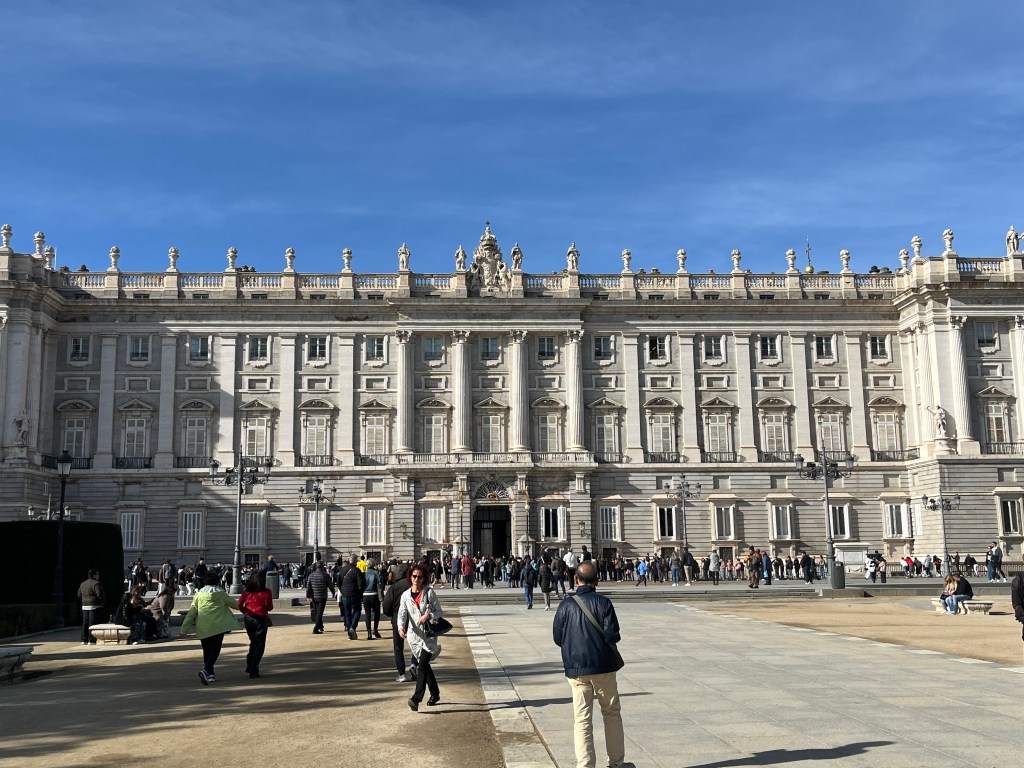


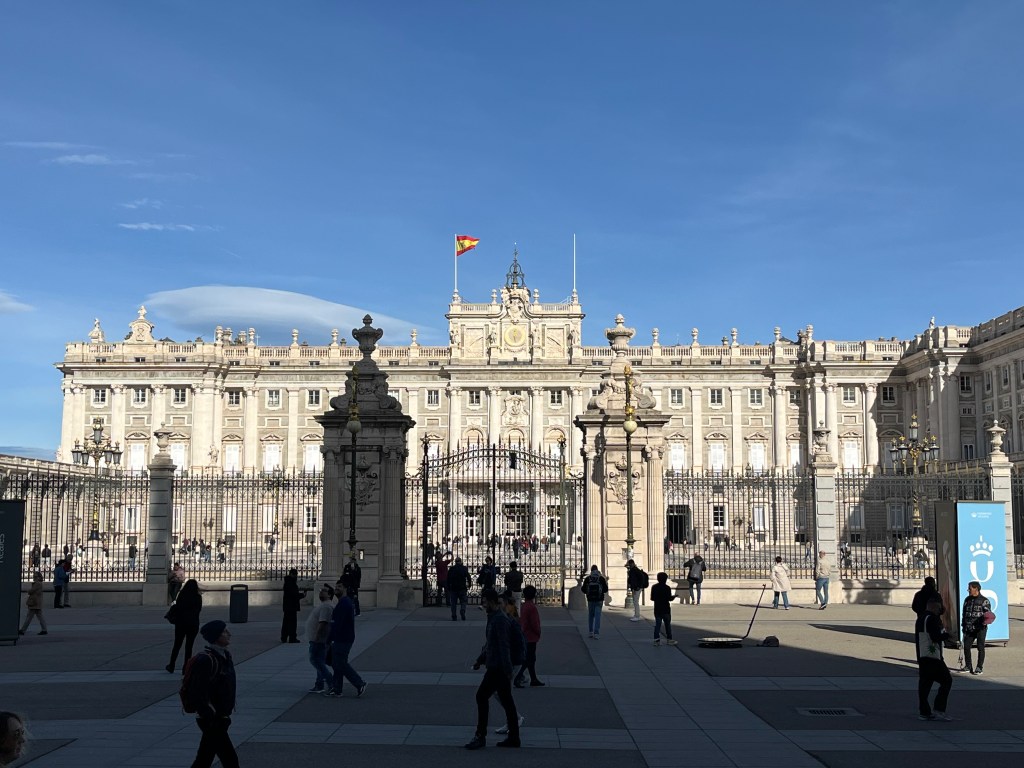
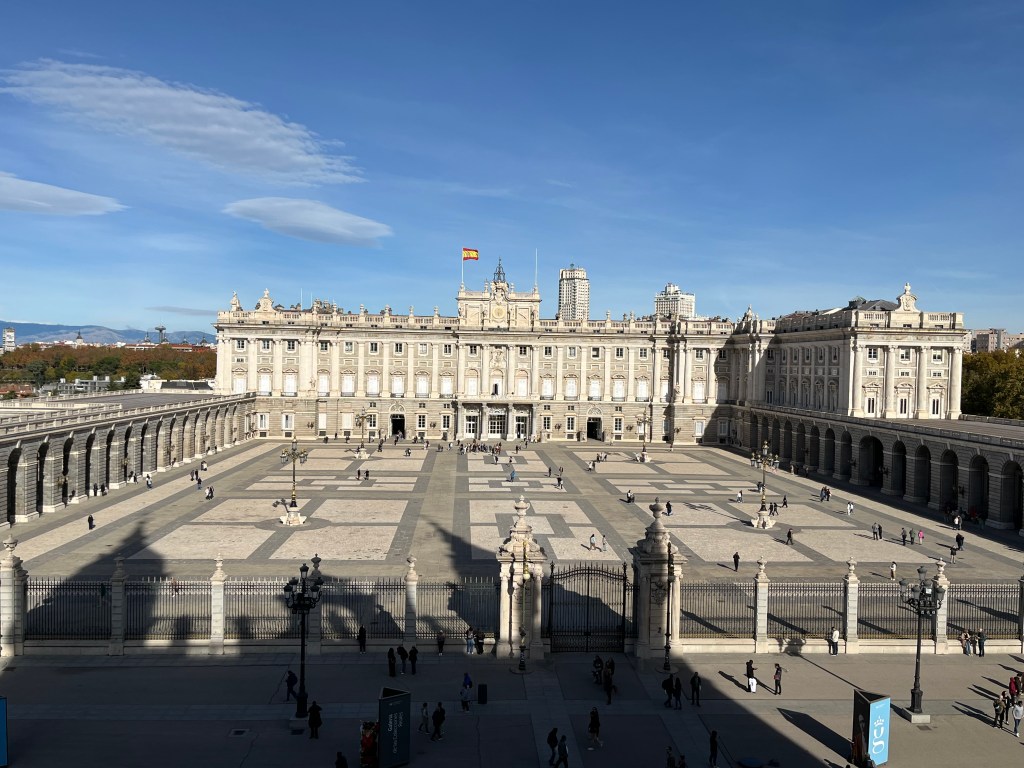

Directly across from the Royal Palace stands the Almudena Cathedral, which was built over a span of 100 years beginning in 1893 in the French Gothic style. A modest entrance fee allows visitors to tour the interior and walk up to the dome, where one can take in panoramic views of the the Hapsburg-inspired royal district of Madrid, including the temporarily closed Campo del Moro, formerly a royal hunting ground. Views from the cathedral below.
I then revisited the Plaza Mayor, the Habsburg-inspired main plaza. Most are unaware that the Hapsburgs ruled Spain from 1516 to 1700 when the Spanish Empire was at its zenith. Charles V and Philip II were two noteworthy kings. It was also under the Hapsburgs that hundreds of thousands of Moriscos were deported from Spain. The Moriscos were Moors who had converted to Christianity after the Reconquista. The Church and the King were always suspicious of the Moriscos’ true intentions in converting to Christianity and planned their removal. Part of this was related to the concept of Limpieza del Sangre, or purity of the blood, in this case referring to the true Catholic Spain of Visigoth and Celtic origins. Although many nobles who employed the Moriscos on their estates objected to losing their valued and talented vassals, the reactionary elements of the Inquisition and Philip III persevered. This period is a fascinating yet largely forgotten part of Spanish history. Plaza Mayor with Christmas tree prep:
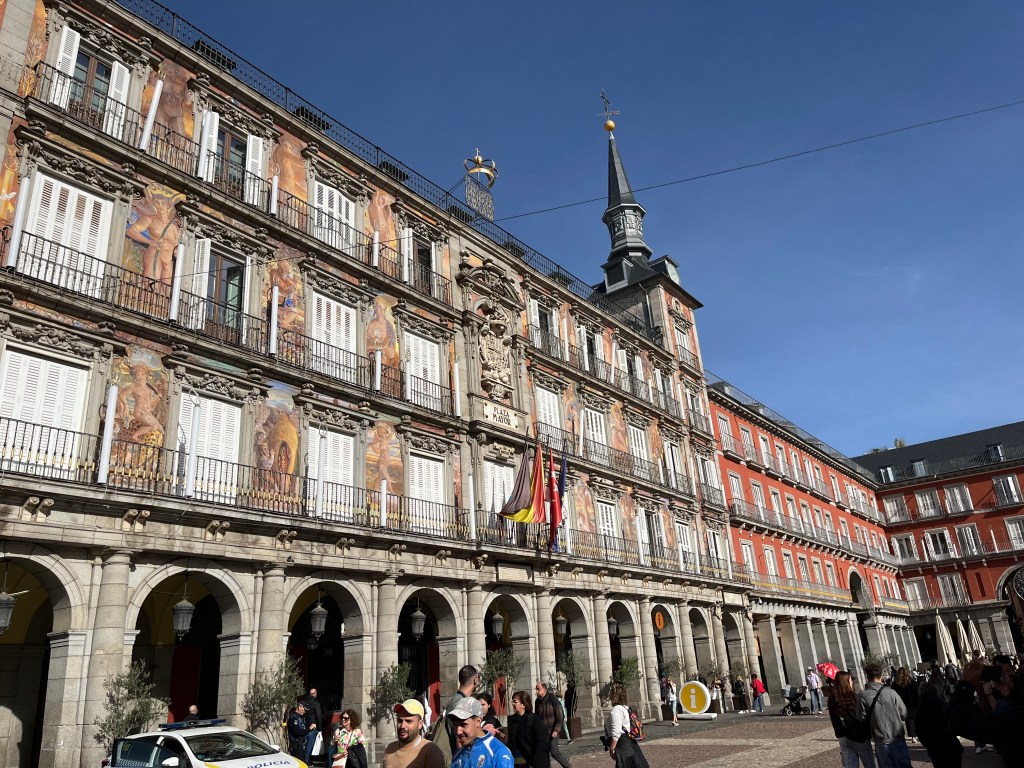
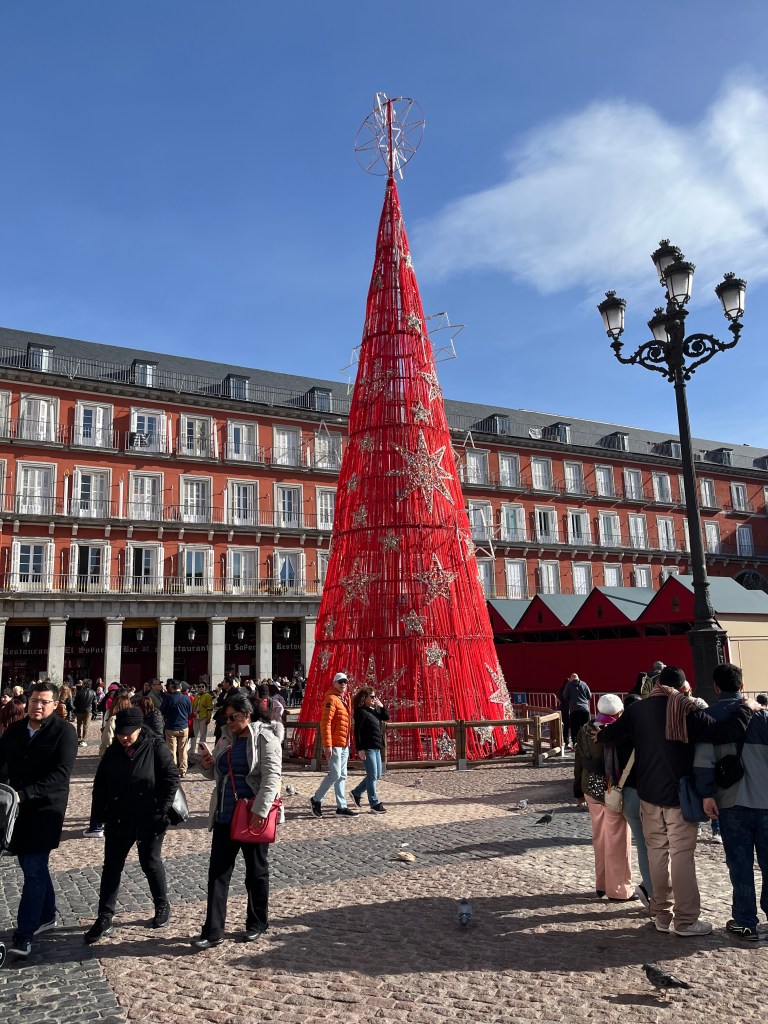

Neighboring the Plaza Mayor is the splendid Mercado de San Miguel, a food emporium. I grazed the stalls for dinner tonight. This is similar to the TimeOut market in Lisbon that I described in September 2022.

Since WordPress’ upload function on photos from IPhone has become impossibly tedious and capricious, allowing only one photo at a time, my blogging going forward is likely to become increasingly terse. I won’t be renewing next year.
Later in the afternoon, I did a circumnavigation of the Retiro park. Tomorrow I leave for Valéncia.
-
Madrid Day 1: November 19, 2024
I arrived in Madrid around 7:30 am in the morning gloom, since sunrise at this latitude isn’t until 8:05. Typically, Delta One’s business class product is superb, but this one was mediocre. It was a 767, which I didn’t know was still in service. The power outlet didn’t work, there was no personal light for reading, and the food was awful. At least there was a fully flat sleeping configuration with a decent pillow and blanket. I doubt that I slept more than an hour. Passport control at Madrid Barajas was quick and I grabbed a ride to my hotel. The fall scenery was splendid and the drive took us through several city parks which was pleasant.
My hotel had a room available for early check-in, so I dropped off my luggage and set out for a long walk in the crisp autumn air. I didn’t dare take a nap for fear that I’d sleep for hours. My routine on the first day is to stay up as late as I can to acclimate myself to the time zone. Last night I dropped at 8:00 pm and arose this morning around 7:45! I’ll describe today’s itinerary tonight.
A friend and his wife suggested brunch at El Federal, which was a 3 km. walk from my hotel. I walked along the Gran Vía, Madrid’s broad shopping and commercial artery. It was somewhat depressing to see the usual American fast food and clothing chains. En route, I stopped at the Plaza de España to admire two high-rises built over 60 years ago during the Franco regime. At the time they were among the tallest in Europe. El Torre de Madrid at 37 stories is the tallest and El Edificio, completed in 1953, is 26. There’s a large fountain with a statue of Cervantes in the middle.

La Torre de Madrid 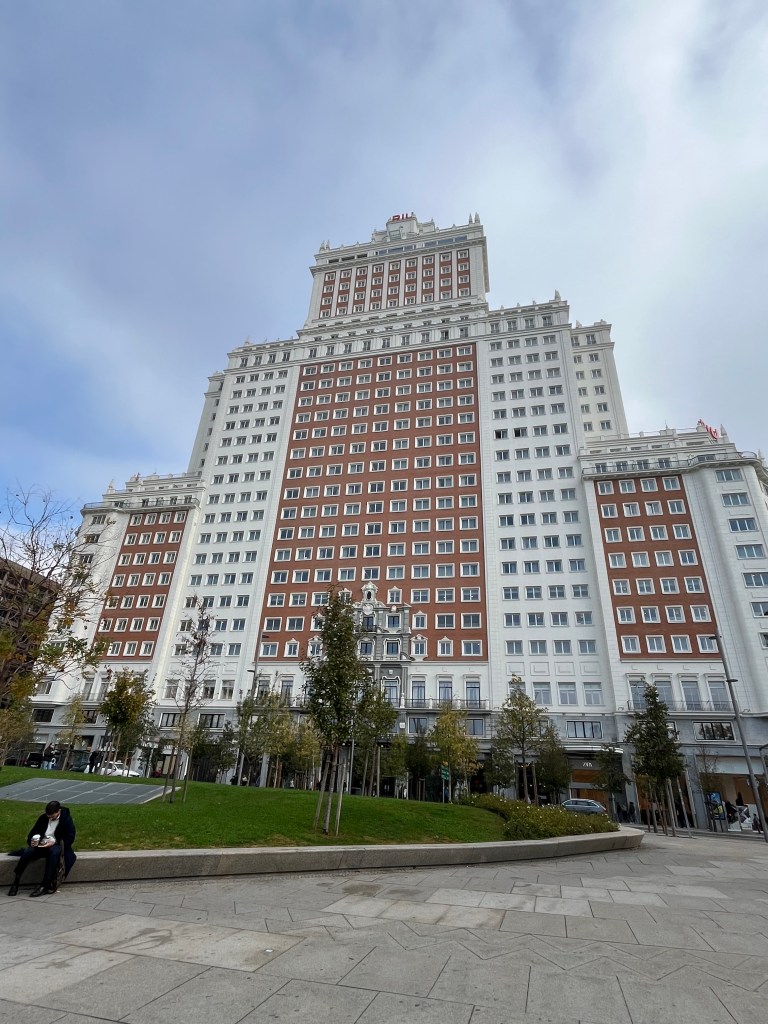
Edificio España 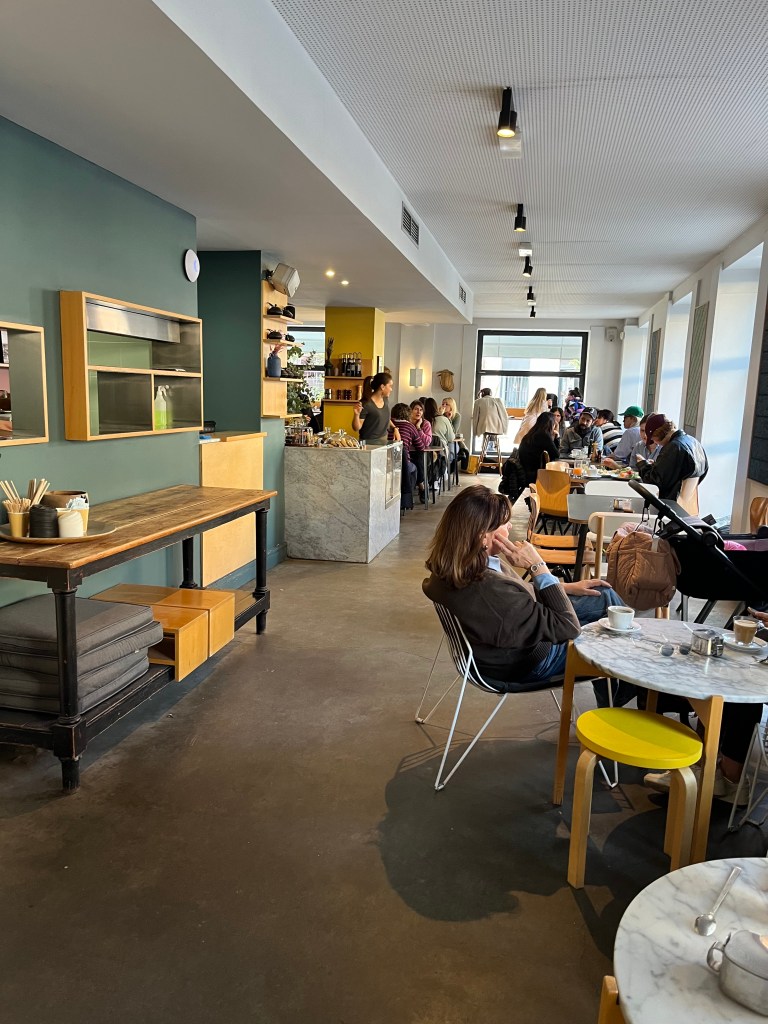
El Federal After lunch I walked to the Thyssen-Bornemisza Museum where I’d purchased a ticket online. The area around the museum is filled with monumental buildings and parks. The streets are lined with mature chestnut and sycamore trees showing their fall colors. The Thyssen is almost overwhelming in its immense collection spanning over four centuries, from Dutch Masters through Impressionism and Abstract Expressionism to 20th c. American and European modern and pop art. It would take two days to see all four floors. They even had a Jamie Wyeth.

Museum exterior 
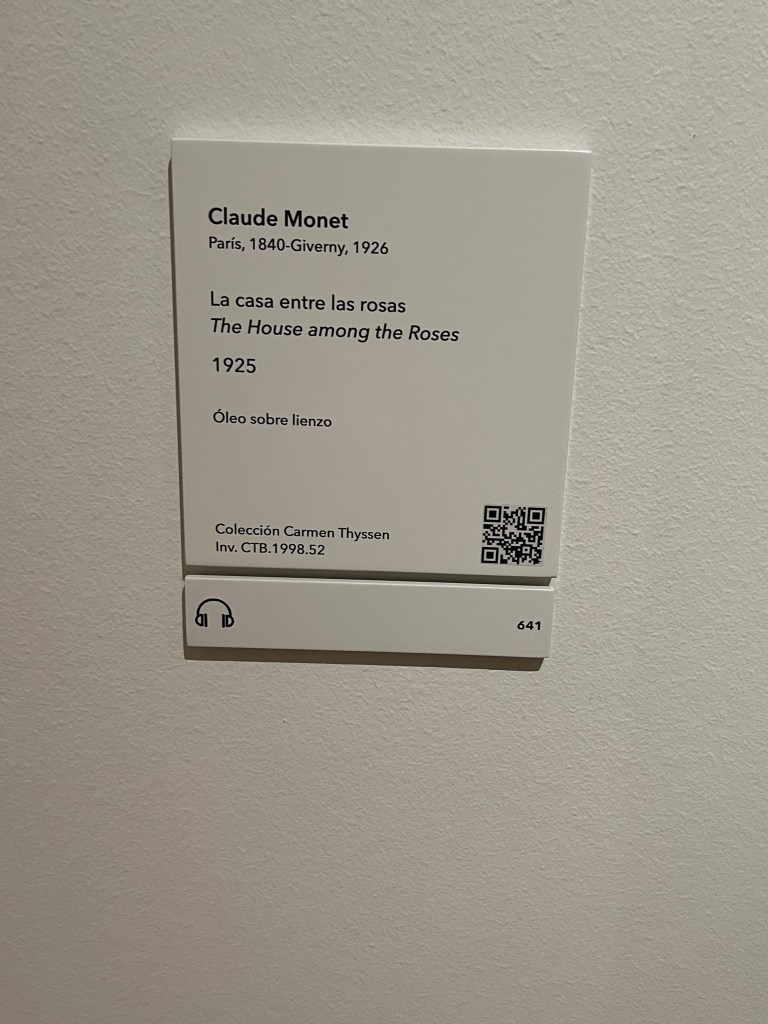
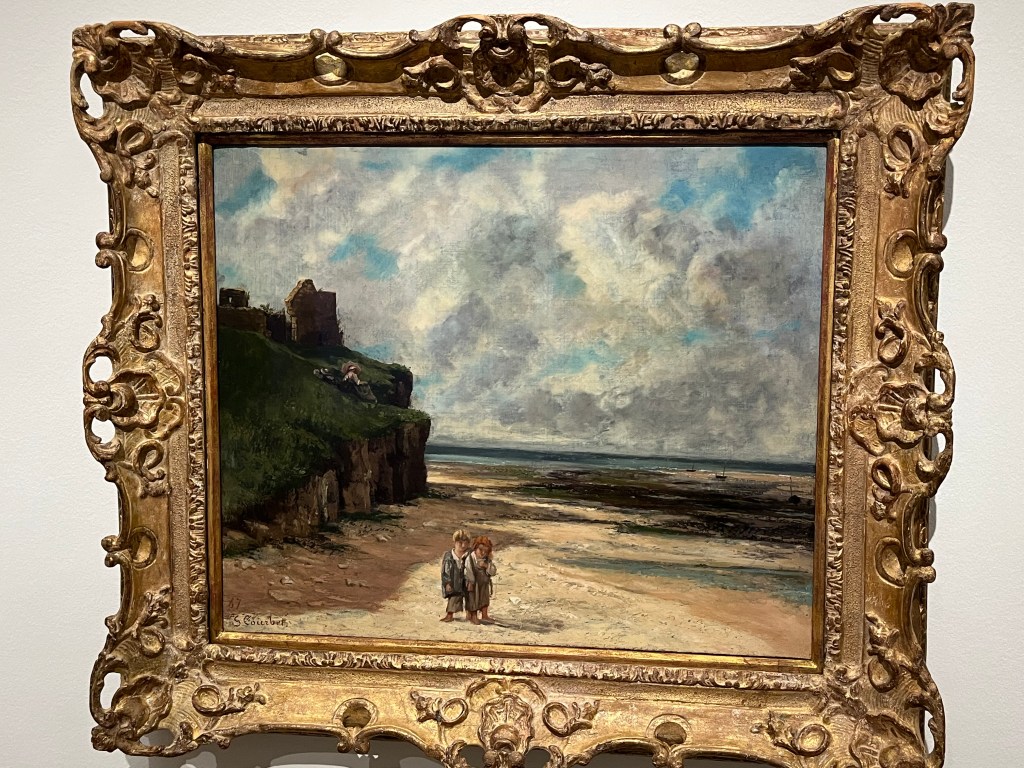
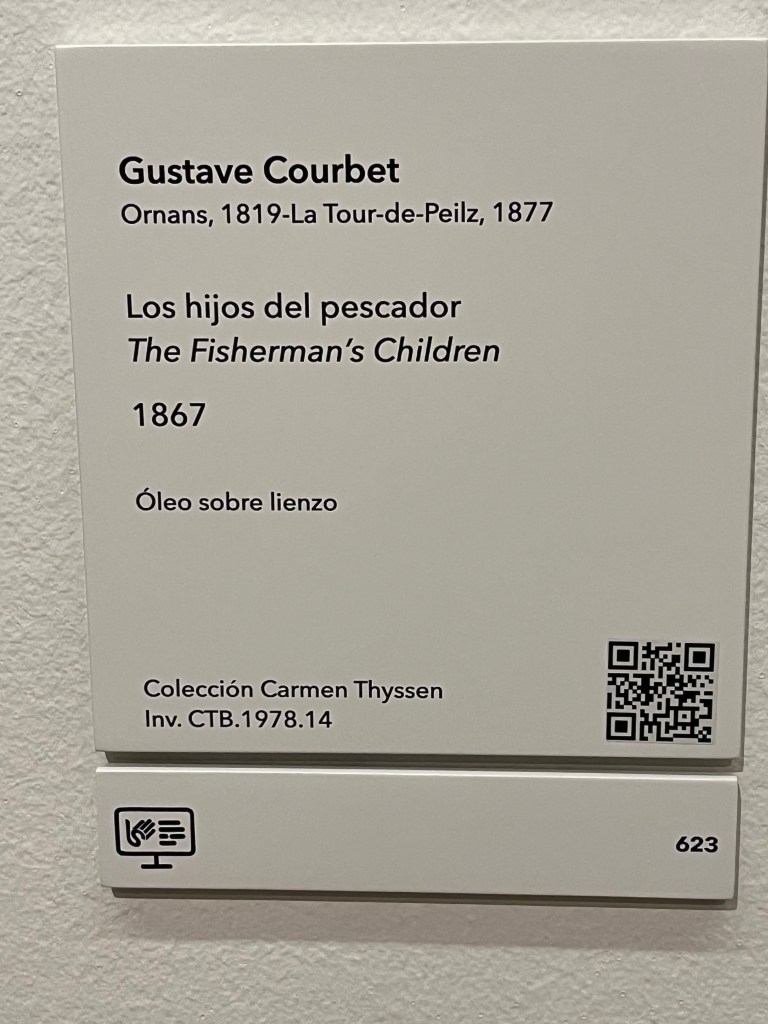

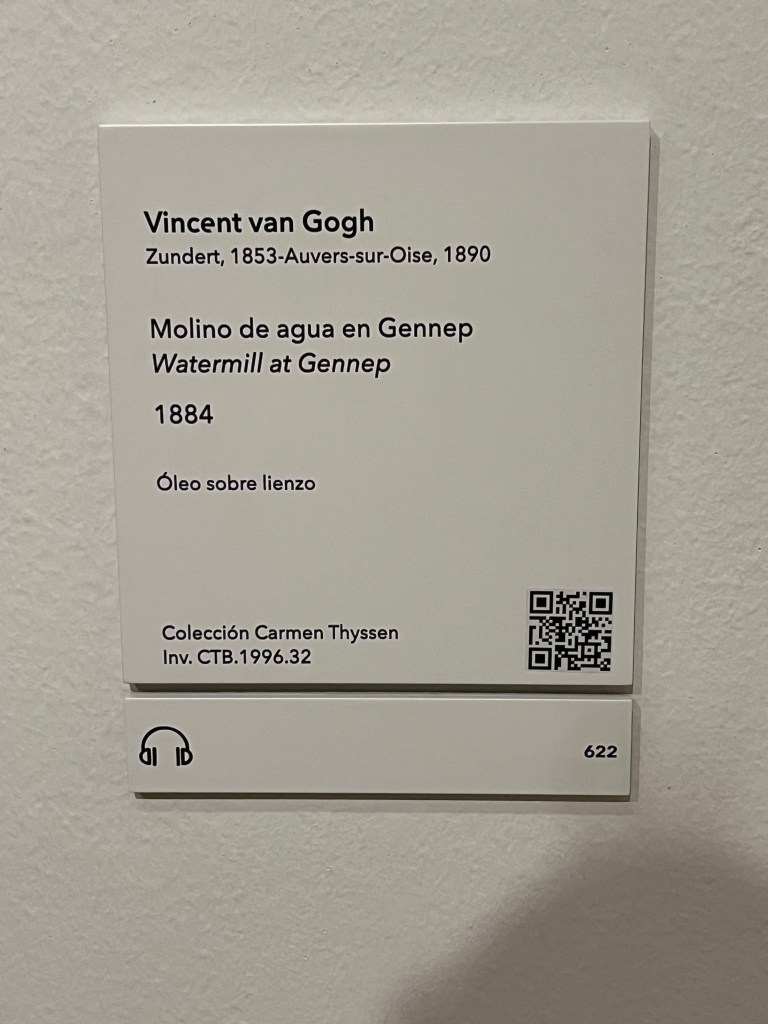
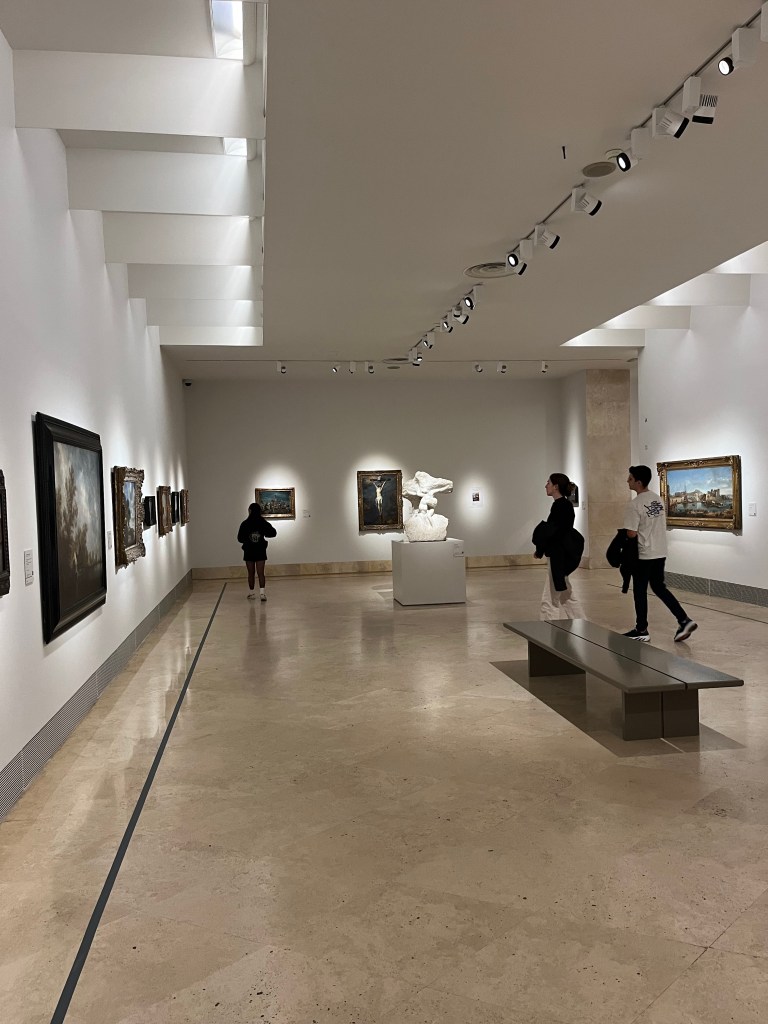
After spending a few hours at the Thyssen, I walked over to the Paseo del Prado past the Prado, where I’d spent an afternoon in 2013 admiring the Spanish Masters. I revisited the Royal Botanical Gardens before walking up the leafy El Retiro, which had formerly been a royal hunting ground. The area is full of upscale apartments and elegant bistros.

El Prado main entrance 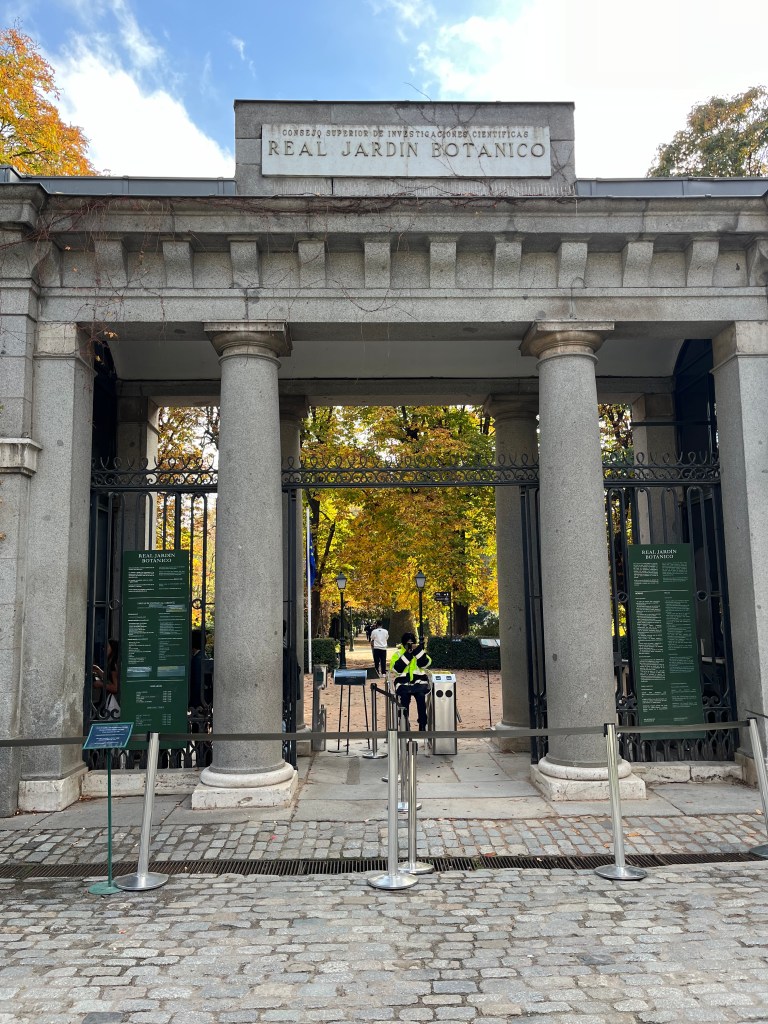
Royal Botanical Gardens 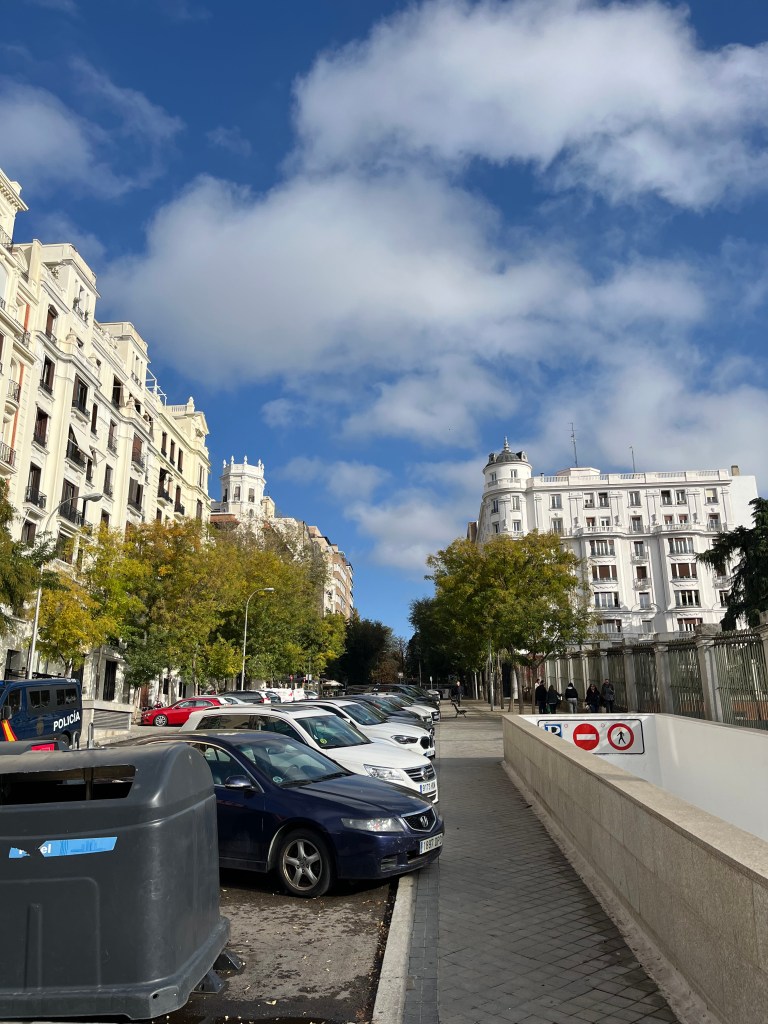
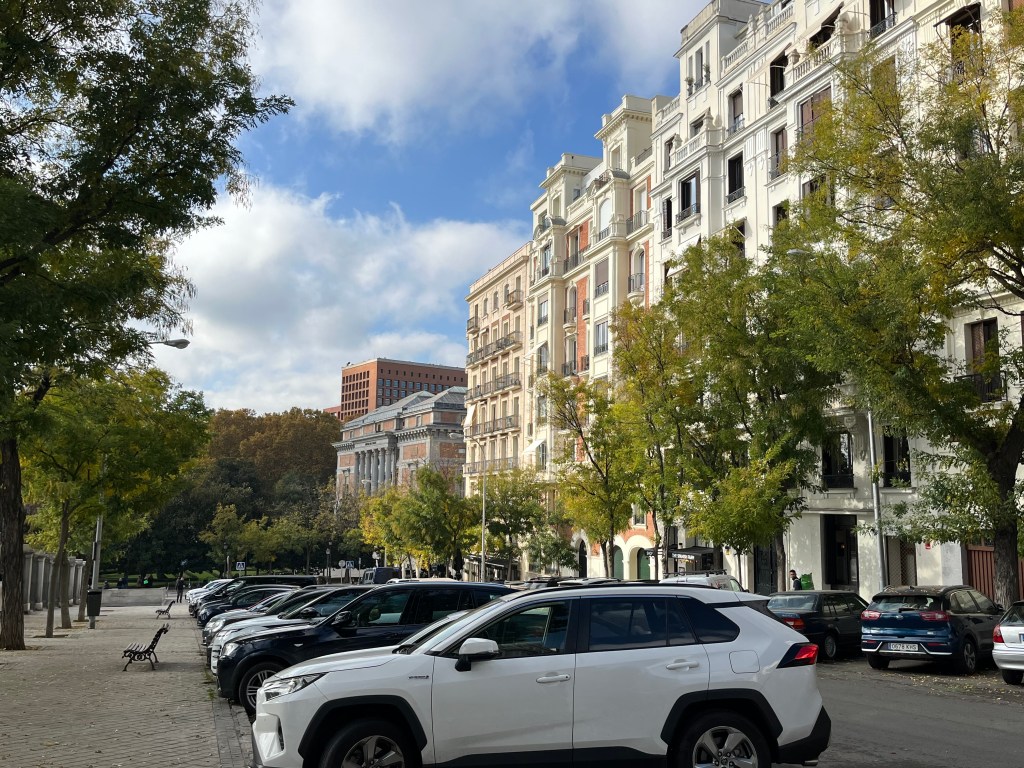

El Retiro I took the long way back to the hotel through the government quarter, passing the Army headquarters, government ministries and office buildings, and finally the Chamber of Deputies, the parliament. After almost eleven miles, I was ready for dinner at the hotel and an early bedtime.

Army Headquarters -
The Pennypack Preserve: a woodland trail with a tragic past
Last Saturday, while visiting my sisters in the Philadelphia exurbs, I suggested that we drive down to eastern Montgomery County to explore the Pennypack Preserve. As a child, I occasionally rode my old Schwinn 3-speed in that area, before the woods across from the Abington Memorial Hospital June Fete grounds were converted into an ecological trust. The whole area retains its rural and forested nature despite its closeness to the Philadelphia city line.
The day was dreary with intermittent rain as we made our way to the mid-19th c. bridge over the Pennypack Creek to join the Pennypack Trail.
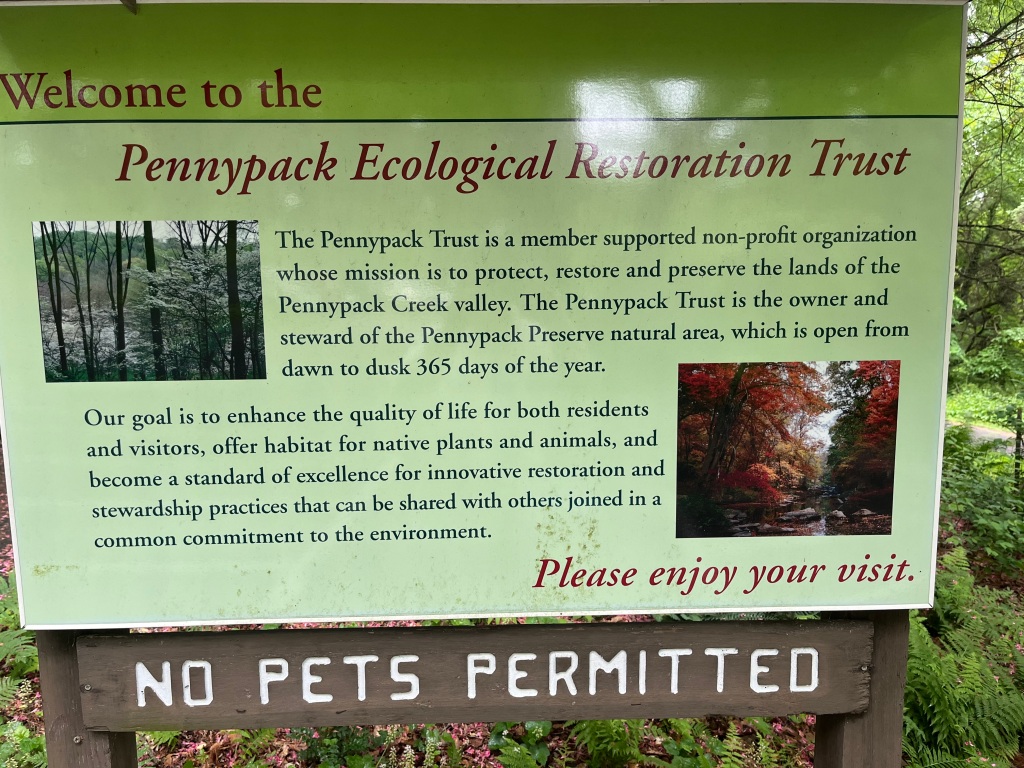
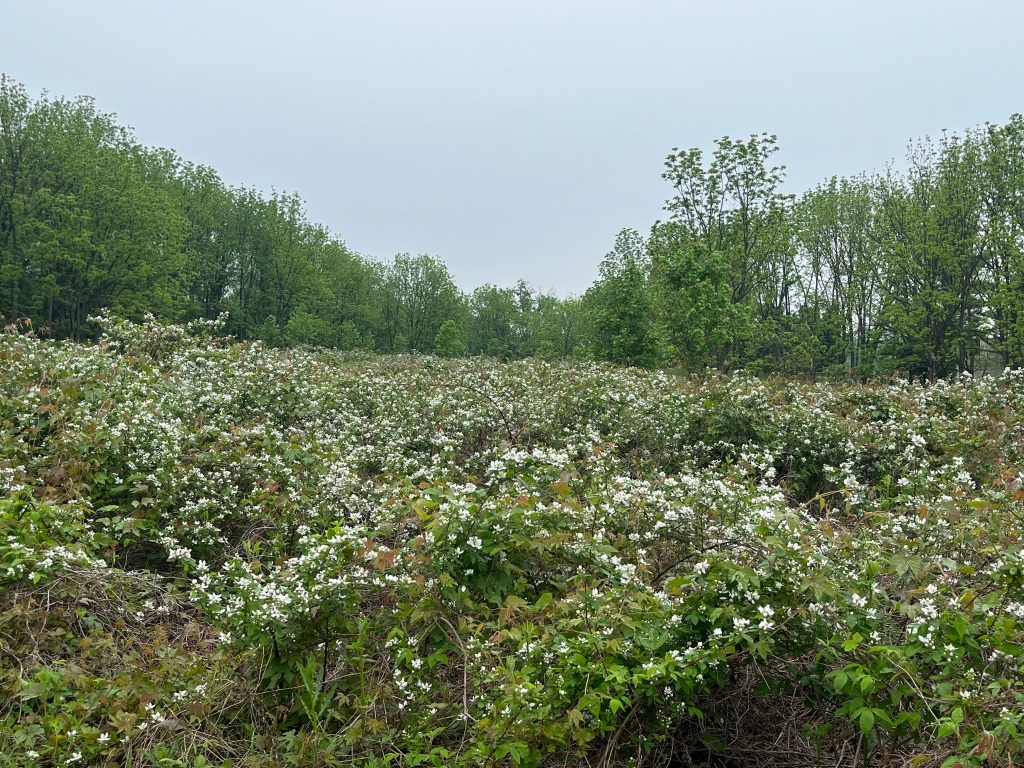
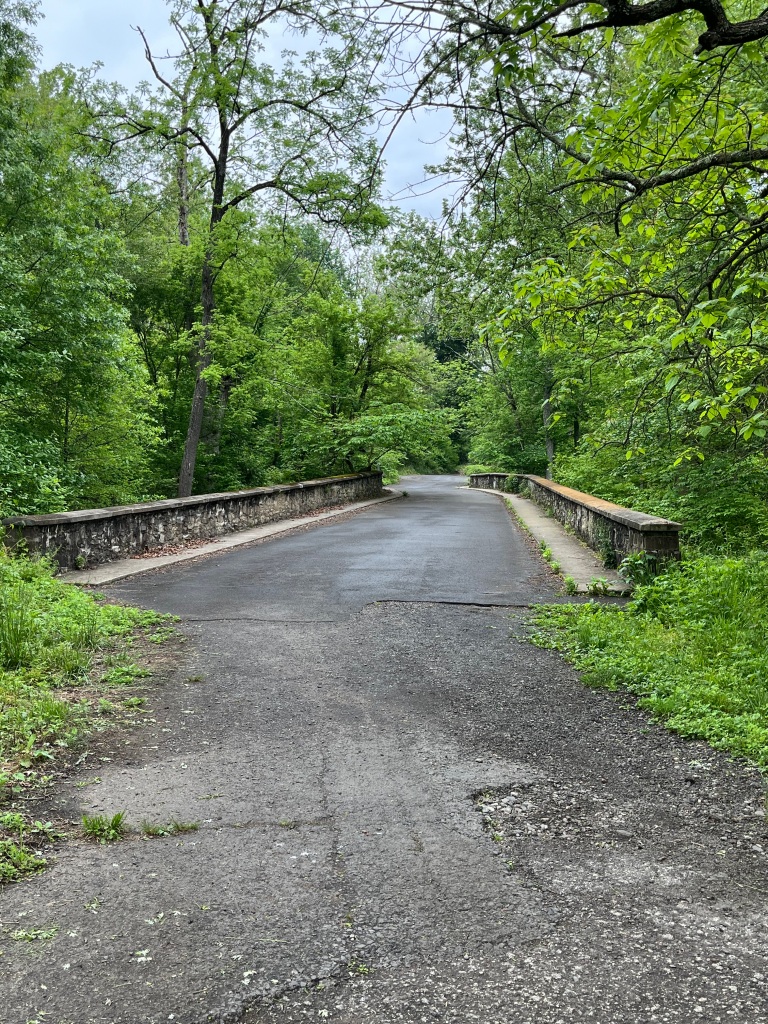

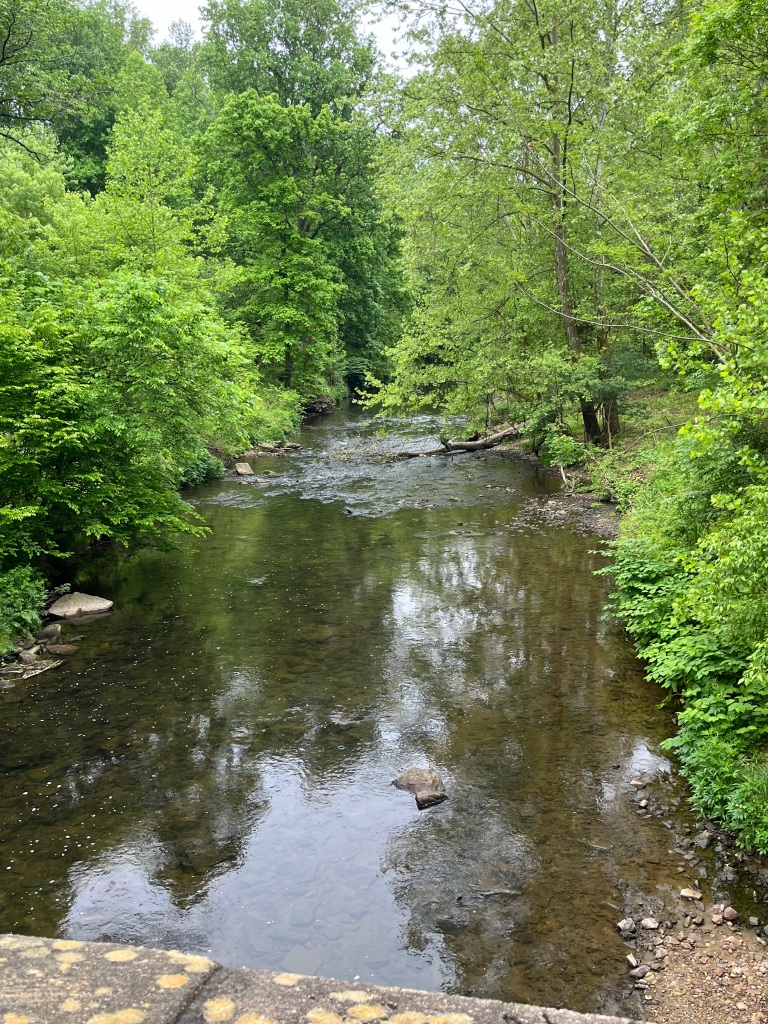

Our destination was the gulch a half mile north of the old stone bridge where, on December 5, 1921, two Philadelphia & Reading Railroad passenger trains collided in a horrific accident which claimed 26 lives and resulted in the prohibition of wooden passenger carriages. The signage provides an excellent overview of the tragedy. I’ve included shots of the gulch and the curve as well as some remaining telegraph poles from the day and the signal semaphore.
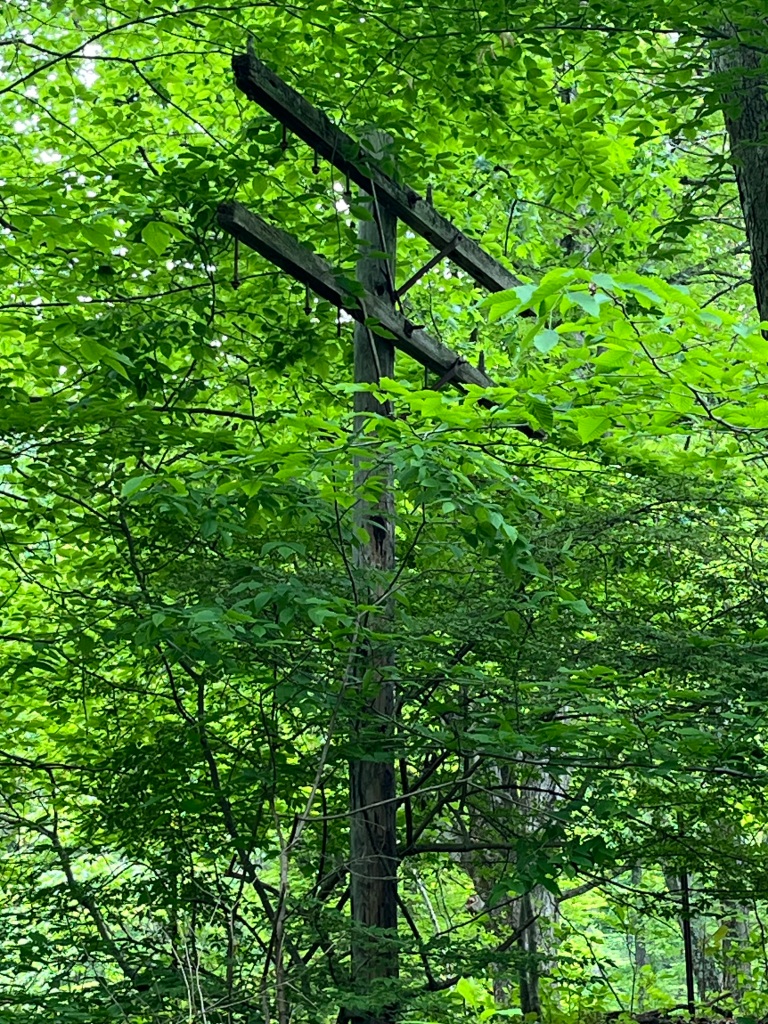
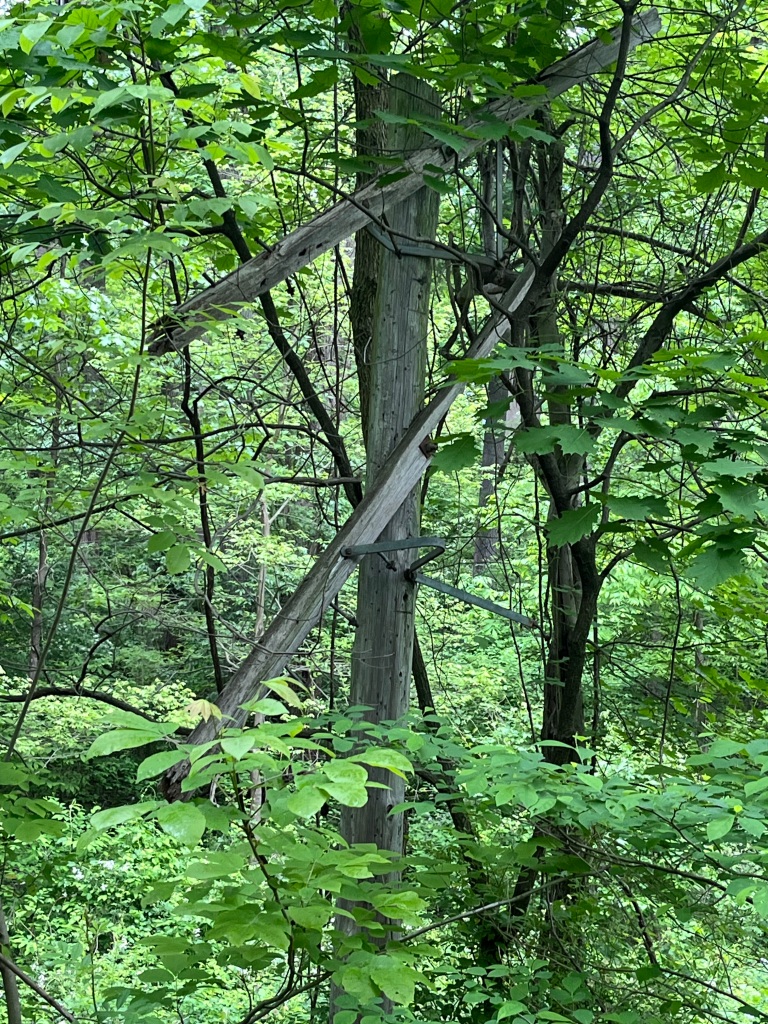
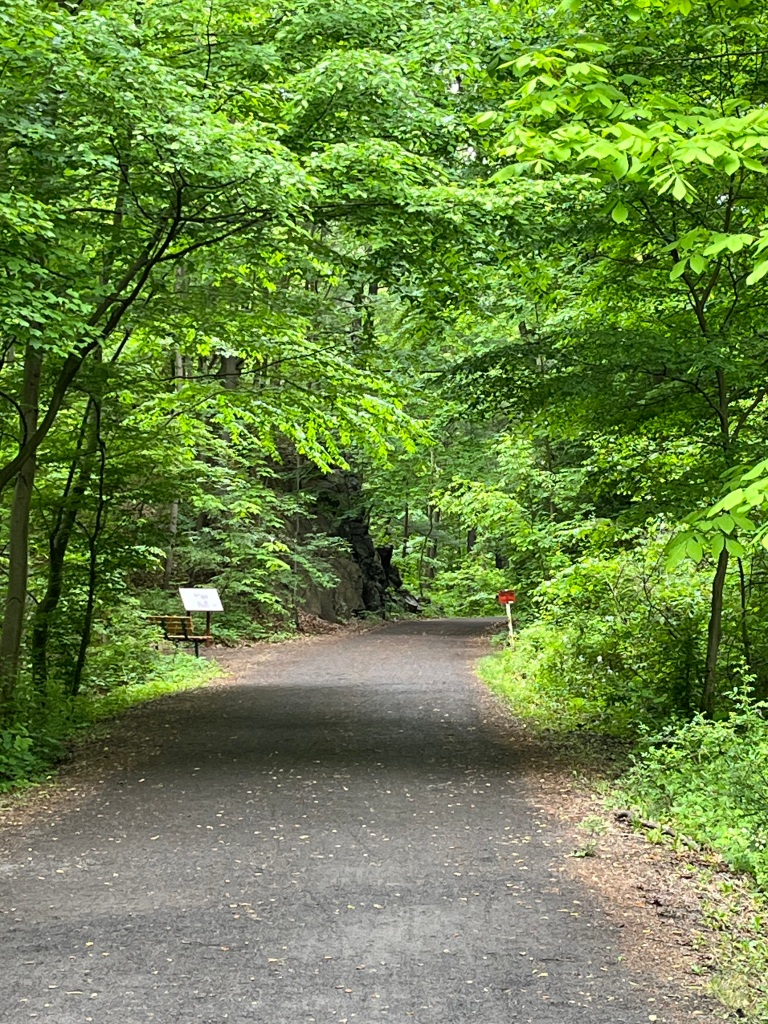
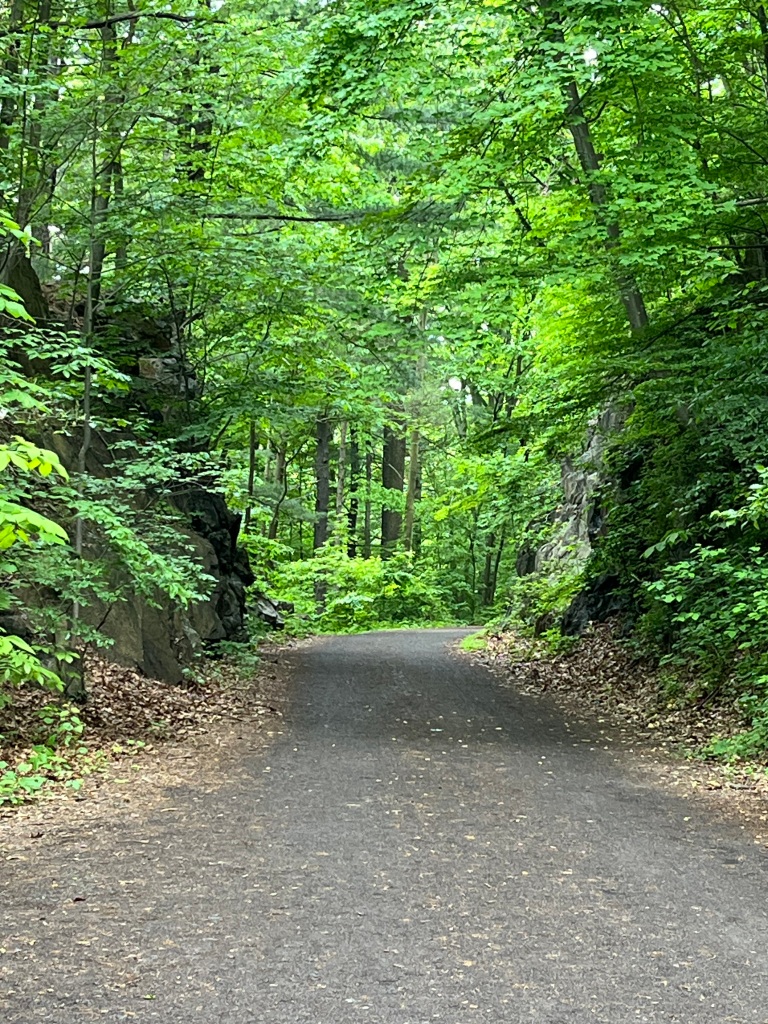
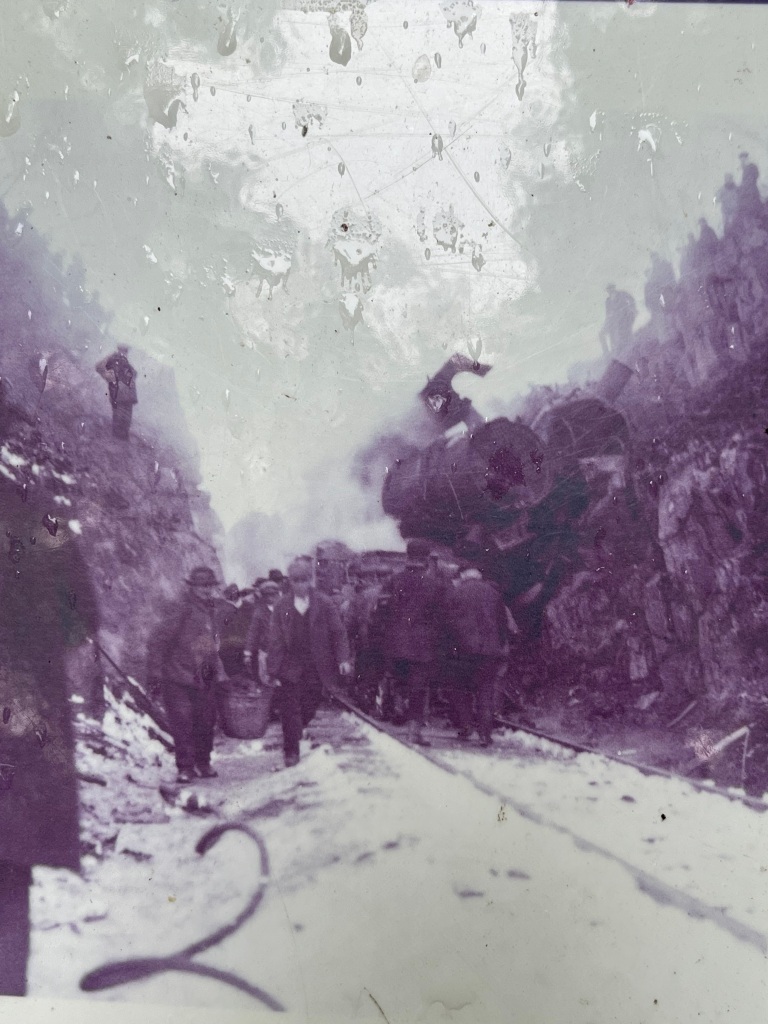
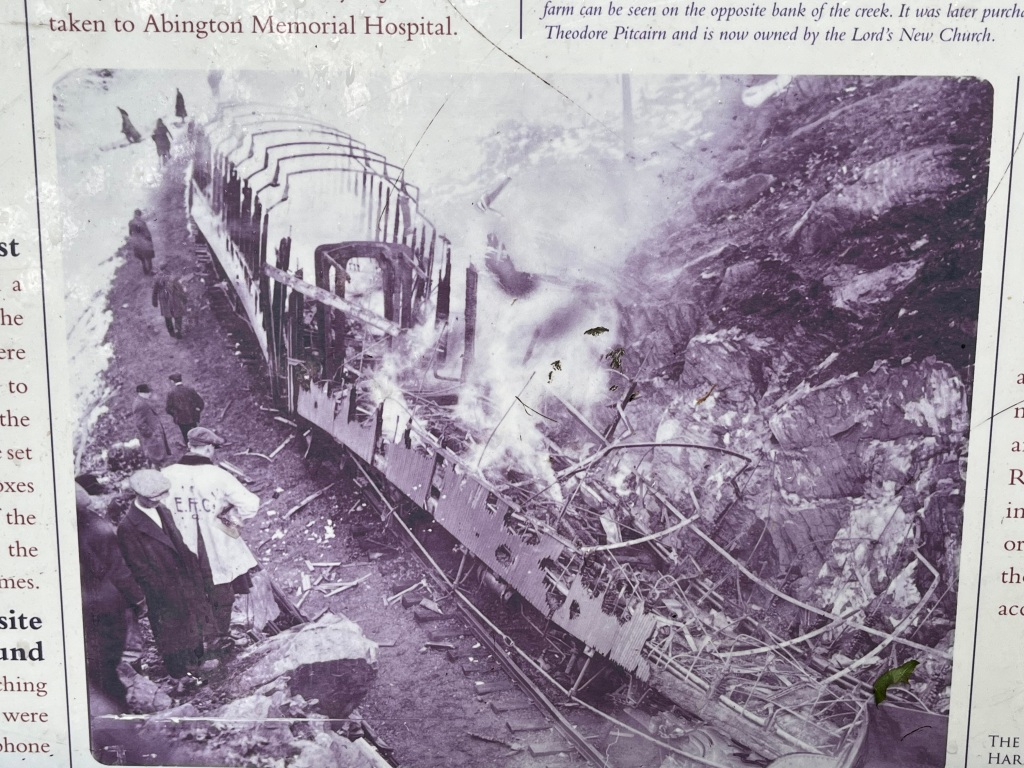
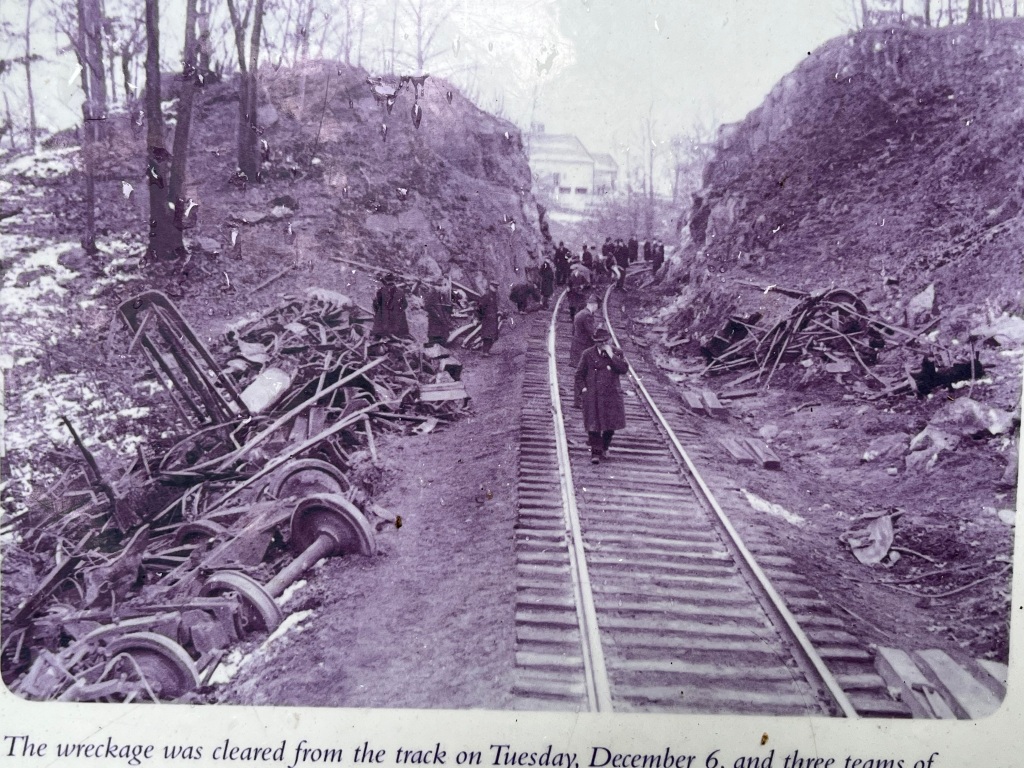


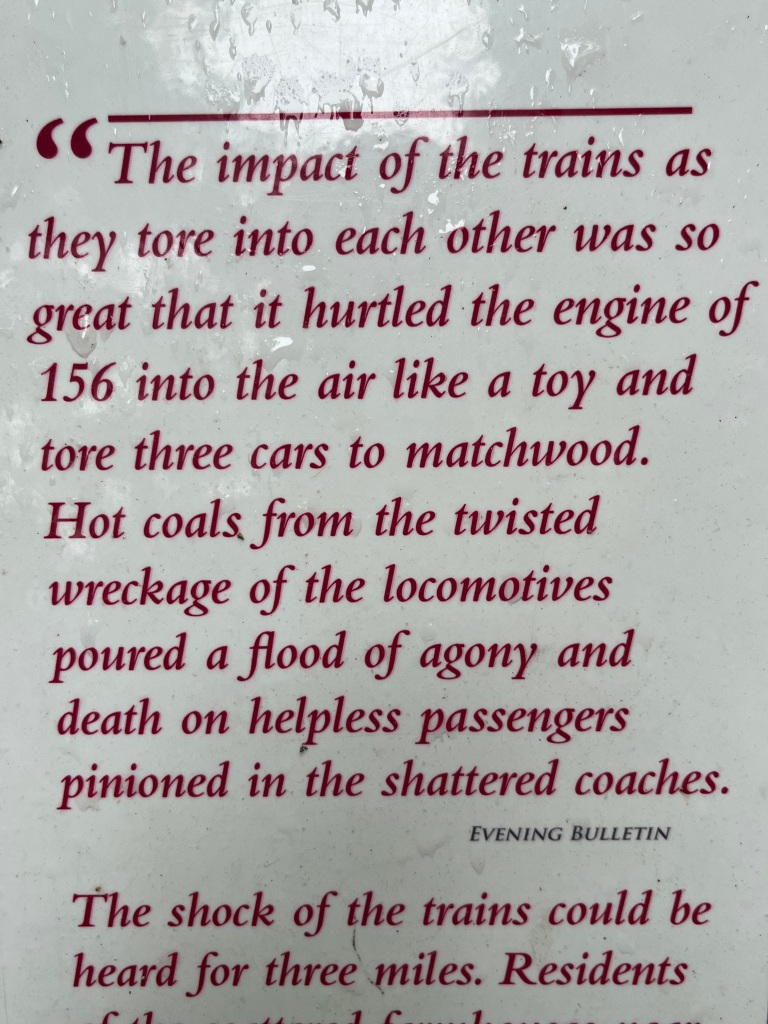
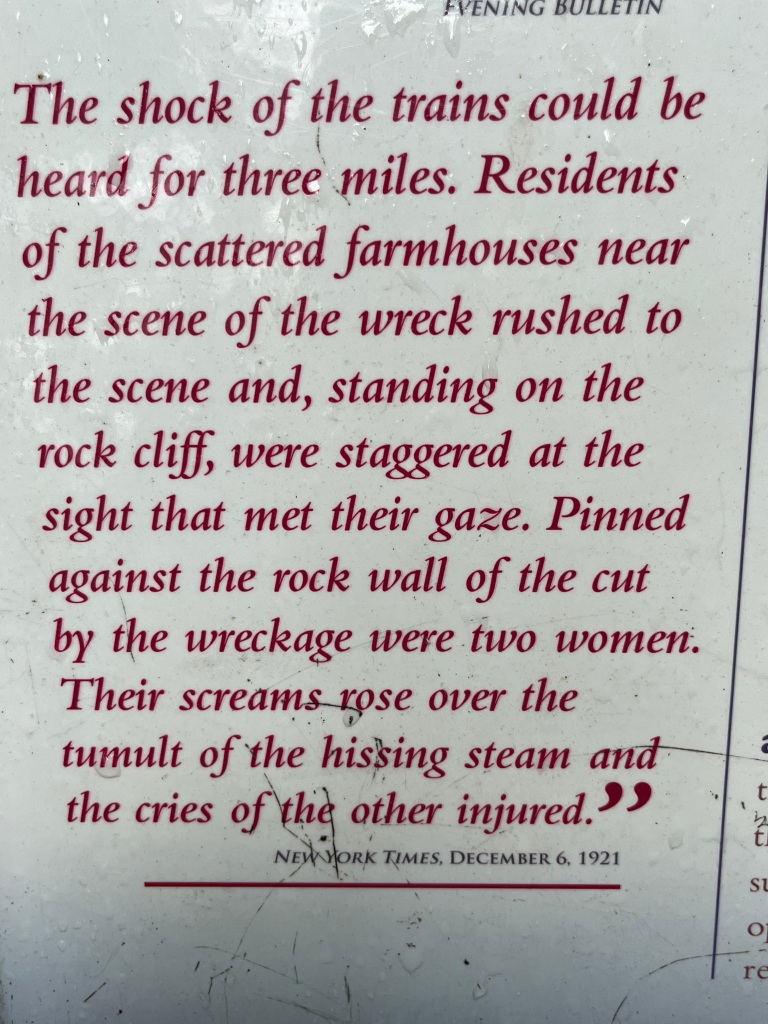

I only found out about the tragedy a year ago, and few people in the Philadelphia metro region have ever heard about it.
The old Bryn Athyn station, now repurposed as a post office, was where the engineers at fault received the written instructions from the stationmaster to wait on the siding a hundred meters north to wait for the daily milk train from Newtown to Philadelphia to pass. The engineers assumed that it was safe to return to the main track since they hadn’t read the daily update informing them that an unscheduled express train was a few hundred meters behind the milk train. When the stationmaster saw the train move forward, he ran after it frantically yelling at them to return to the siding, to no avail. Knowing what was about to happen, he called the local fire department and ambulance to head to the gulch.
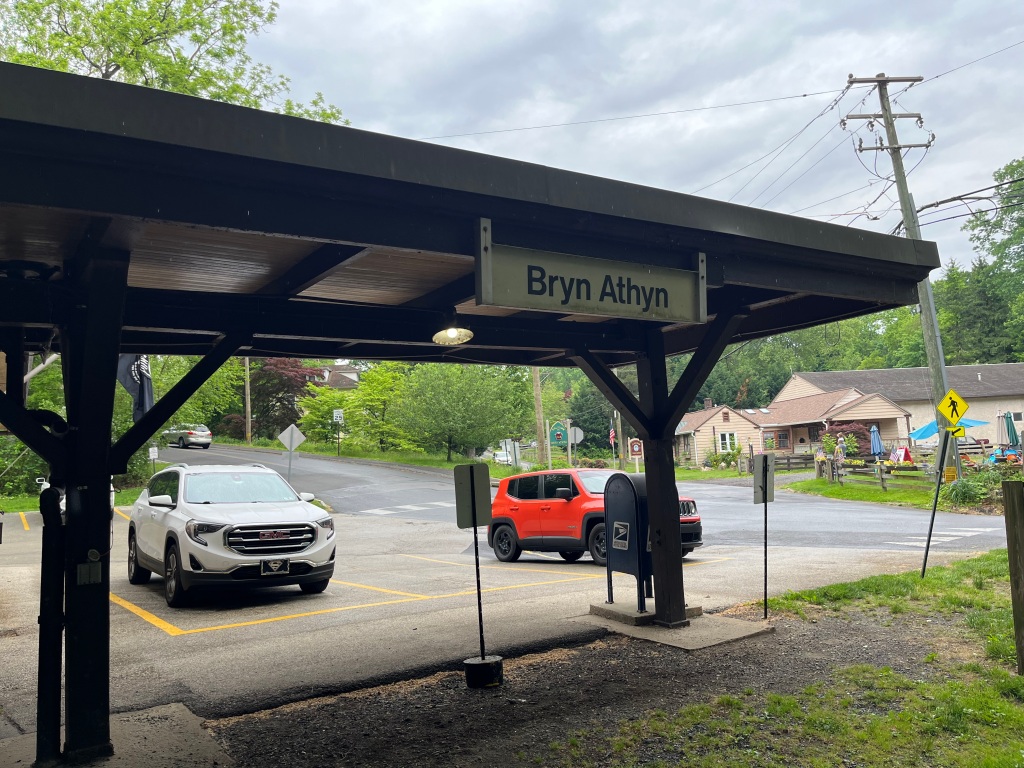
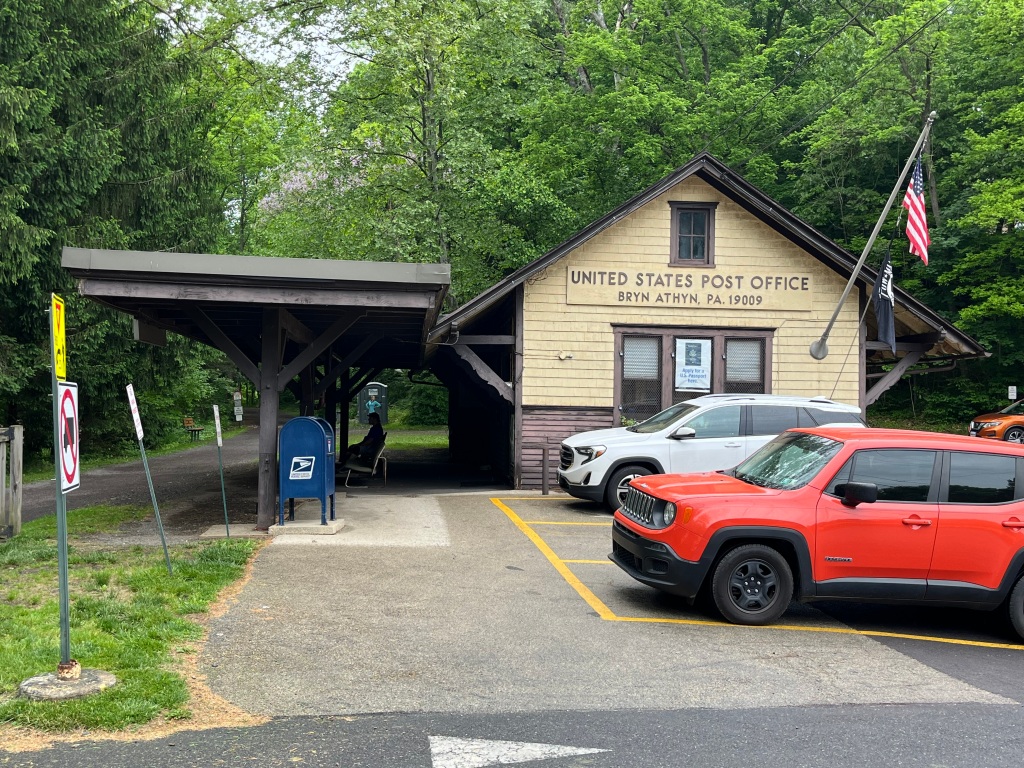
Former Bryn Athyn station 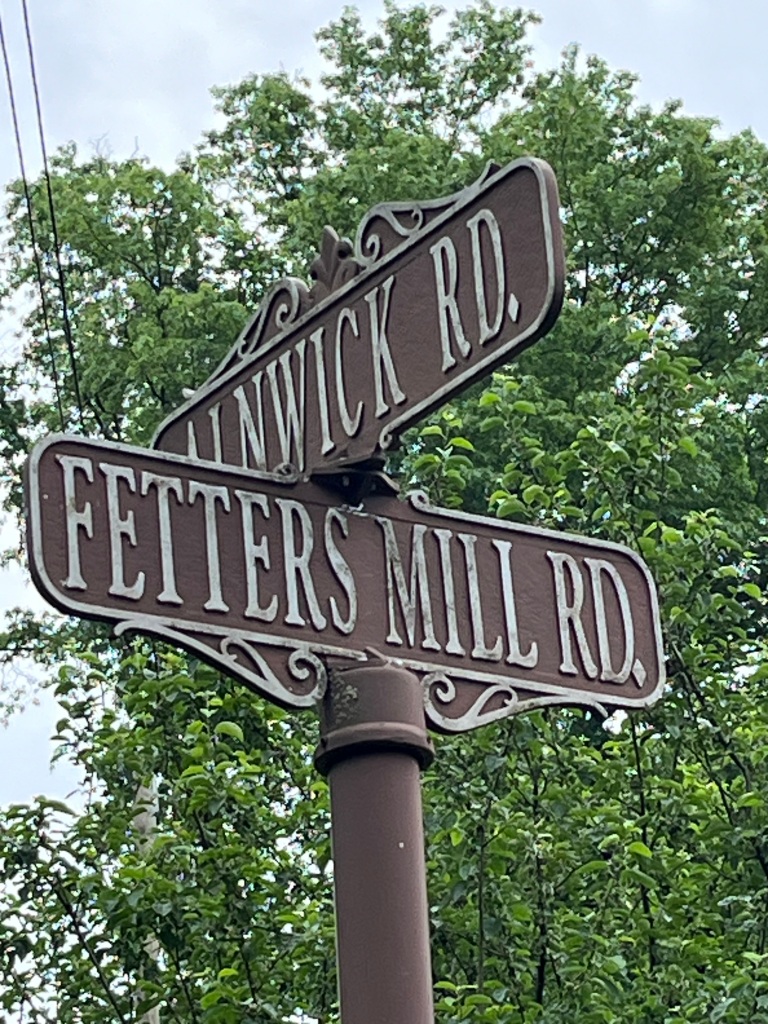
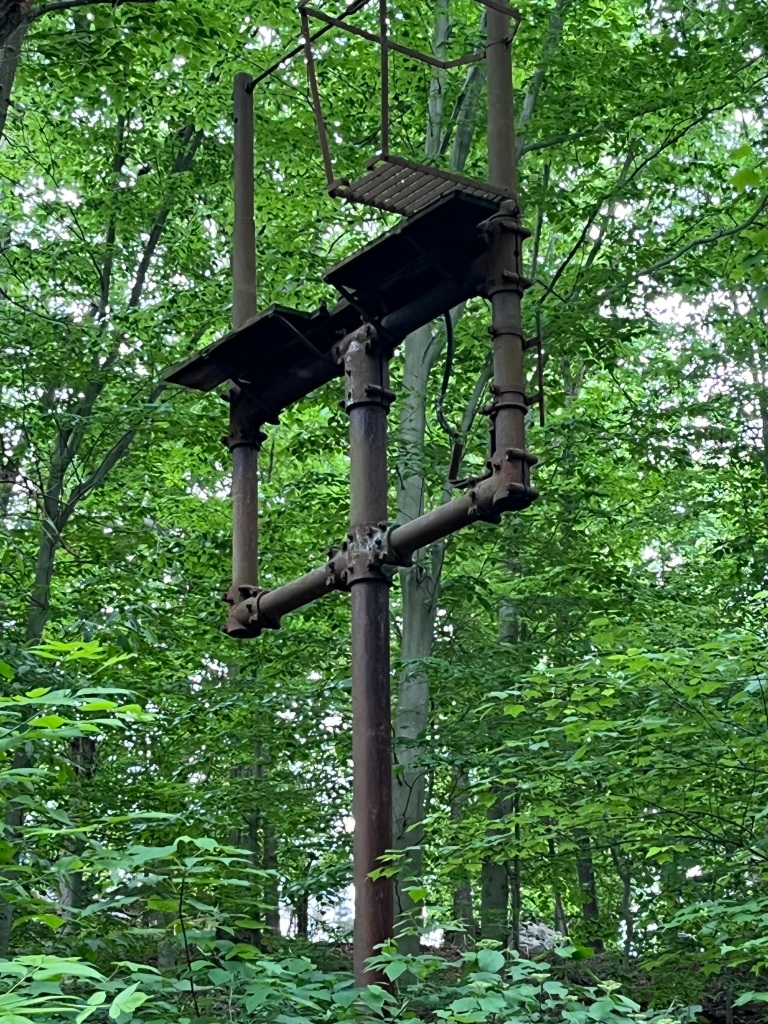
Old semaphore 
Stone houses along the creek 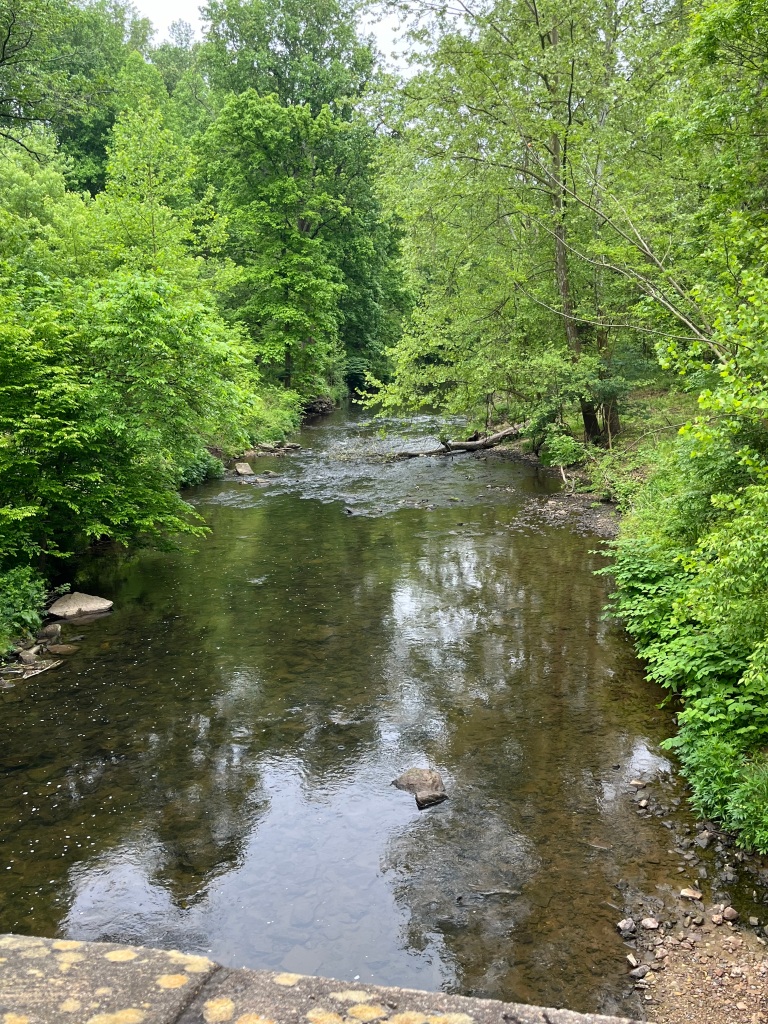
Pennypack Creek This video recounts the tragedy in a comprehensive way. The narrator has the classic Philadelphia suburban accent.
Returning to the visitor’s center and our car, the rain picked up a bit. We met two college guys who were fishing. When I asked them if there were trout in the creek, they said no-only crappies. When we saw them later as they headed to their car, they excitedly reported that they had indeed caught a trout and showed us the picture. Since it’s a catch and release creek, the photo is their souvenir. I brought them surprisingly good luck.
As we crossed the meadow I was able to catch a pic of Cairnwood and the top of the Bryn Athyn Cathedral, which I wrote about in 2022. The preserve is a real gem in the midst of the suburbs.
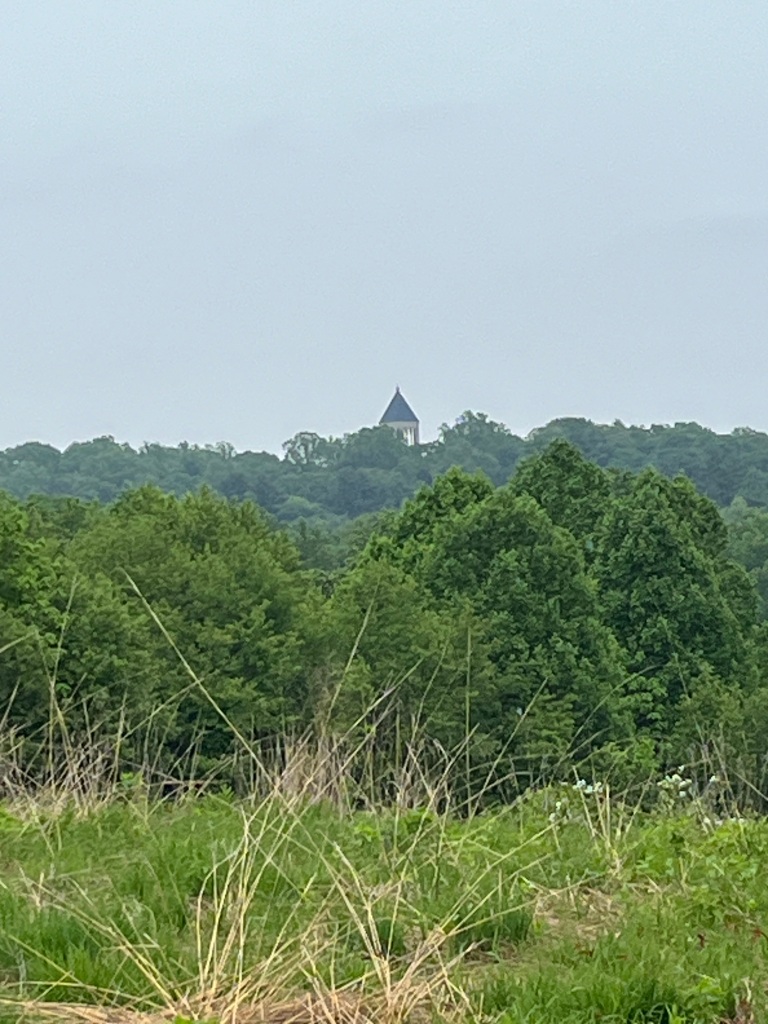
Cairnwood in the distance 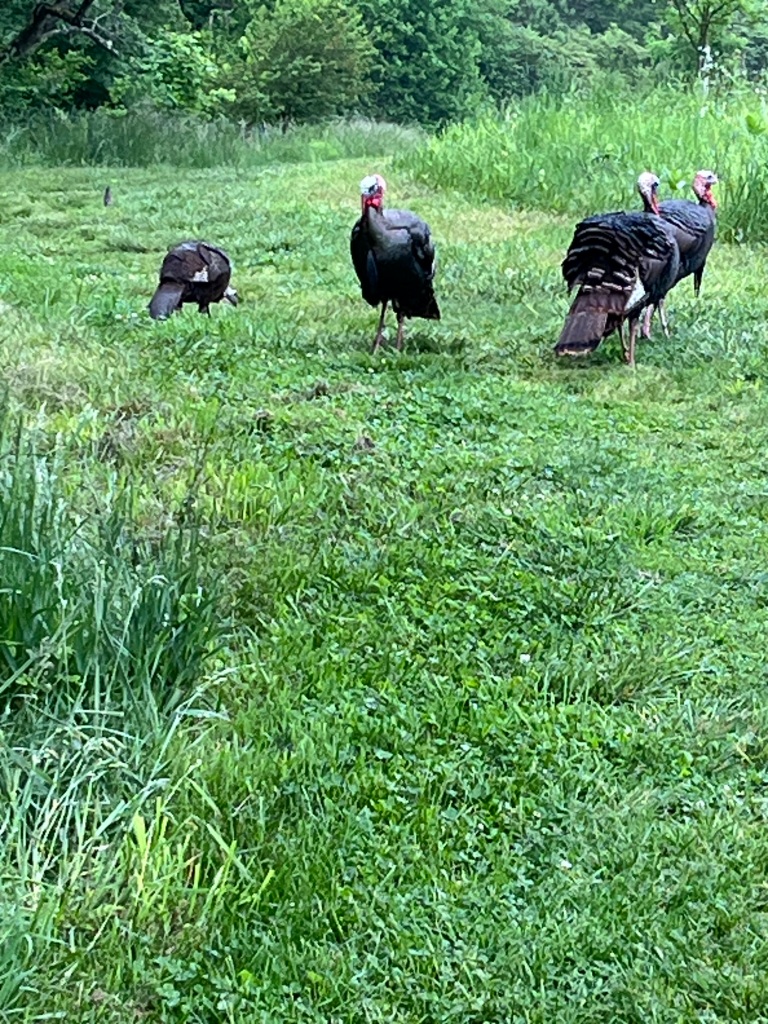
Wild turkeys 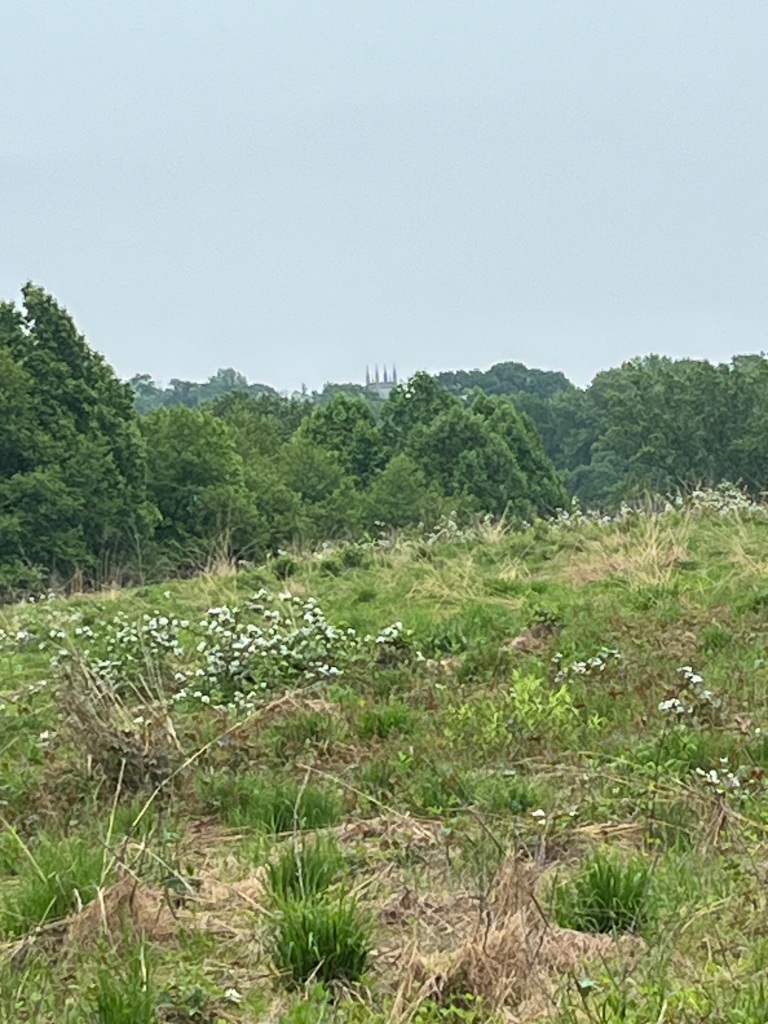
A glimpse of the gothic tower of Bryn Athyn Cathedral -
Heading Home: May 8, 2024
I awoke to a cool morning, so I went for an early walk on Victory Day, a national holiday celebrating the end of WW2 in Europe. I snapped a few pics on my walk
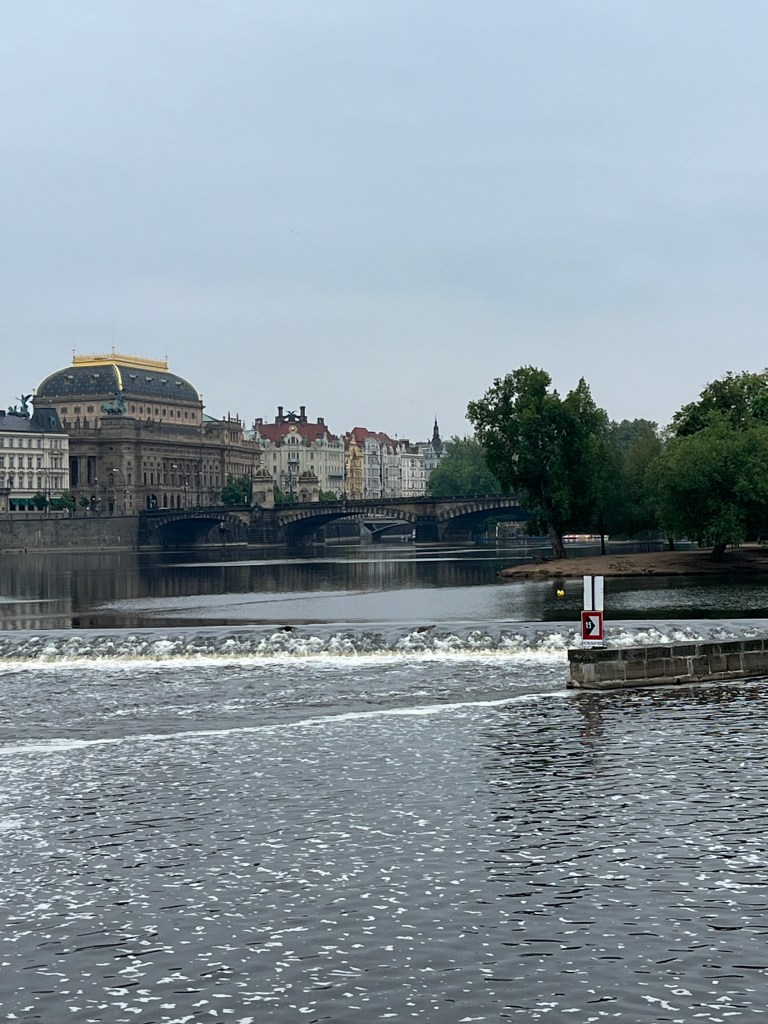
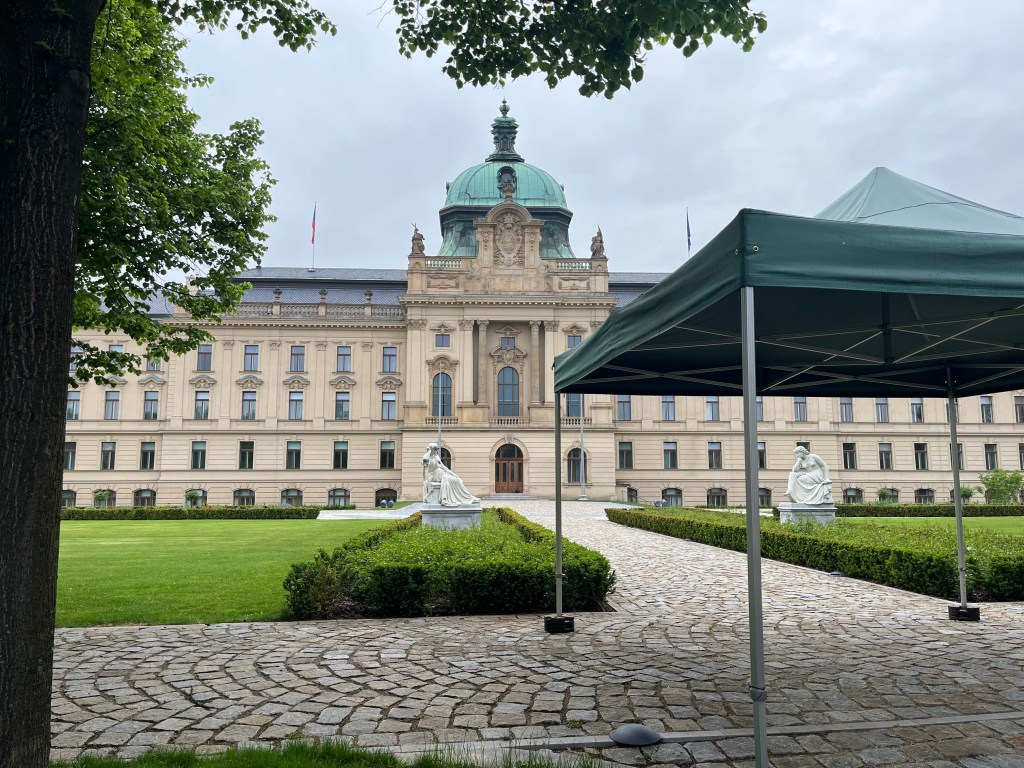

My return flight is through Paris CDG and then back to Nashville. Check-in and security at PRG was super fast, and I’m now sitting in the business lounge waiting for my flight.
Concluding my 16th trip to Europe, I can recap my impressions for this latest visit.
Two nights were enough for Amsterdam. Even in April it was crowded. I can’t imagine what the summer will be like. I know mine is a minority view; but I’m the type who prefers Madrid over Barcelona and Siena over Firenze.
The German cities I visited were all new to me. I’ve spent time in Bavaria and Hesse, but never ventured north or east, to the former DDR.
Münster is a city few visit, but it’s a beautiful and charming old town. Hamburg was impressive and full of great museums and parks. Berlin was fascinating, with such a juxtaposition of new and old, freedom and authoritarianism. It’s now the largest city in the European Union and is a dining and walking paradise. And Potsdam is a must-do side trip.
I was surprised to discover Leipzig’s charm and vibrancy. It’s doing well financially and has an incredible cultural patrimony for its size. It’s another hidden gem that few Americans visit.
Dresden is an elegant city, precisely rebuilt in the past 30 years. I wished I had booked a third night. A bit more touristy than Leipzig.
Finally, Prague is as beautiful as it was when I visited in 2001, although the number of tourists has swelled and there must be a hundred times more restaurants and shops than I remember from my last trip. Since it was unscathed during both world wars, its ancient and Baroque architectural legacy is intact. Discovering hidden tourist-free neighborhoods like Nový Swět is a special treat.
There are three European countries I haven’t yet visited: Norway, Greece and Albania. I’ve heard great things about Albania over the years. Now I have to decide which time of the year is best for visiting all three.
Thanks to all those who have been following my blog.
-
A Rainy and Chilly Day in Prague: May 7, 2024
As readers of my older posts know, I always find the small European washing machines a bit hard to decipher, especially when written in Czech. A little Google translation led me to discover that the Gorenje machine doubles as a dryer. The wash cycle was two hours and the dry cycle was three in this very energy-conscious continent. I’m glad I got an early start.
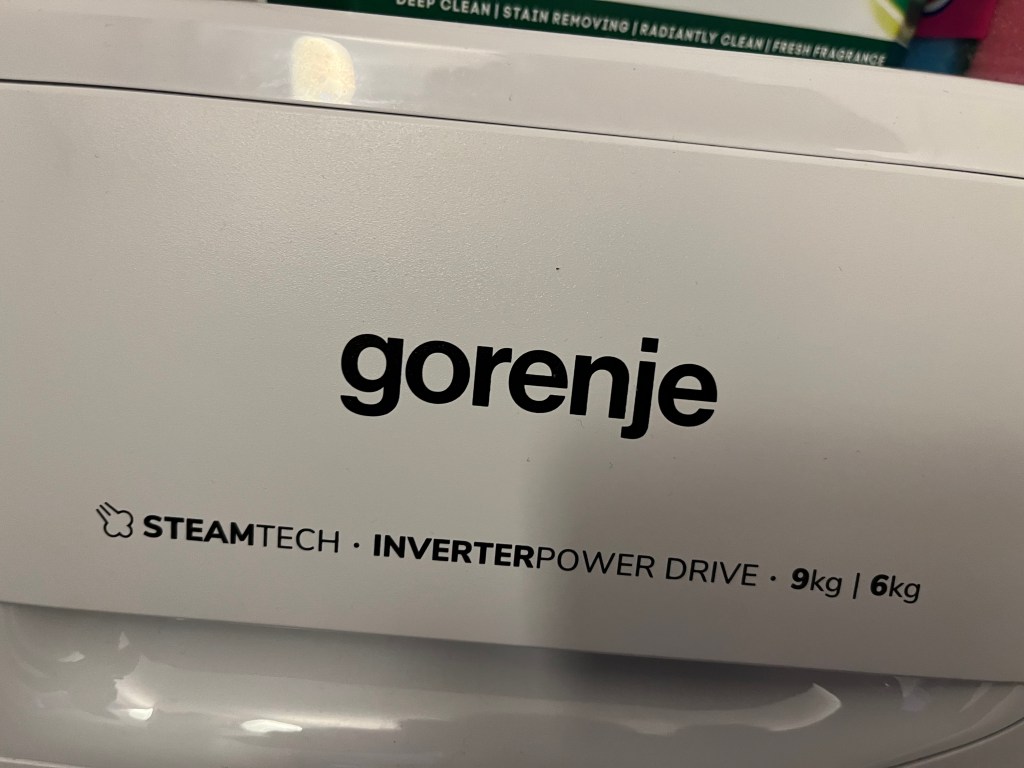

After throwing the clothes in the dryer cycle, I decided that this was a museum day, so I walked over to the Malostranská metro station for the quick ride to the Muzeum station. I didn’t want to navigate through masses of umbrellas.
There was a long line to get into the National Museum, so I checked their website and saw that they had automated ticket machines, so I walked right in and had my ticket in 30 seconds. I suppose tourists are afraid to use the automated version.
The special exhibition was “Baroque Art and Life in Bohemia and Bavaria” and it was well curated.

View of Wenceslas Square looking west from the museum 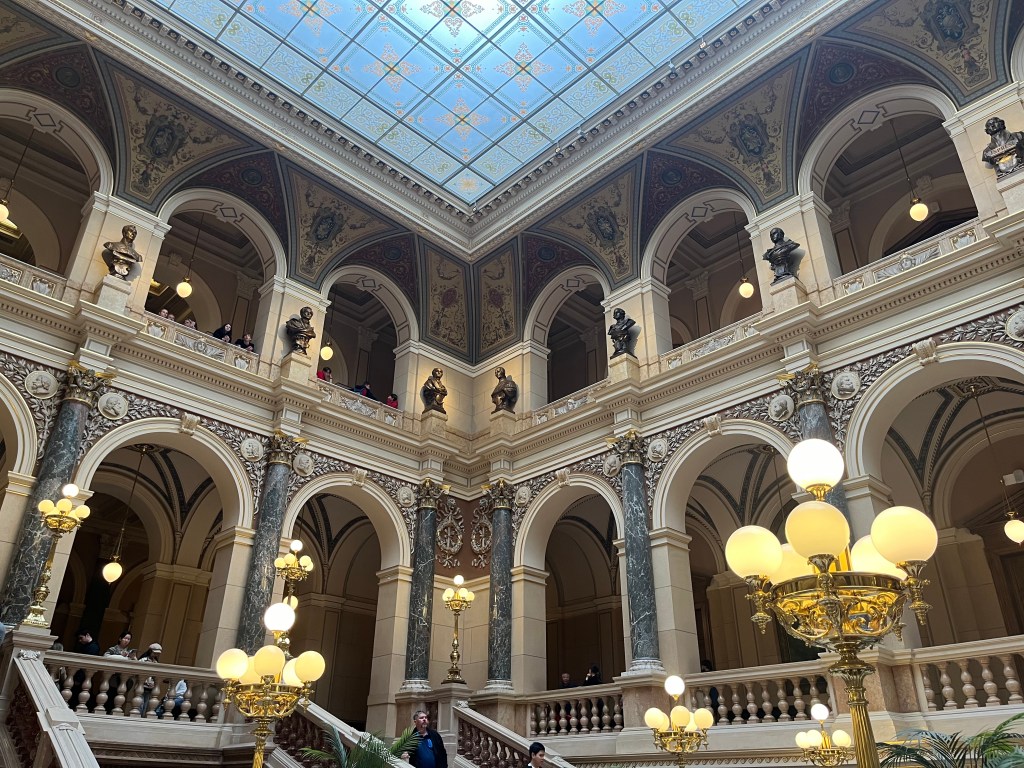
Interior views: 1 
2 
3 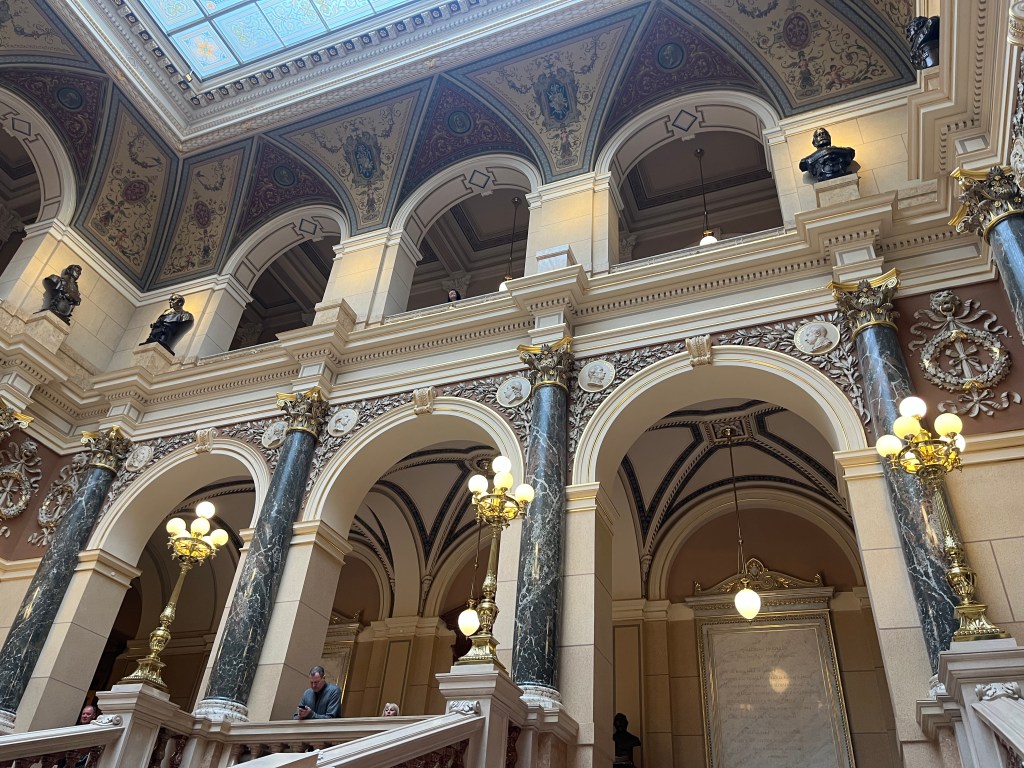
4 Here are some of the works on display plus information in English:
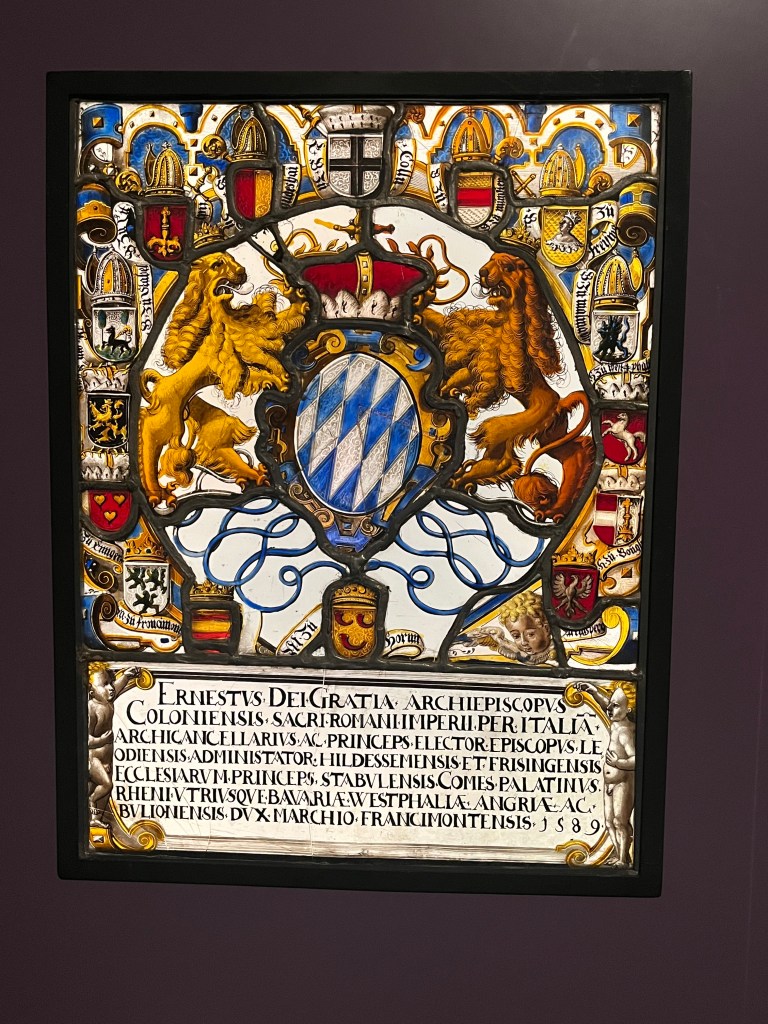
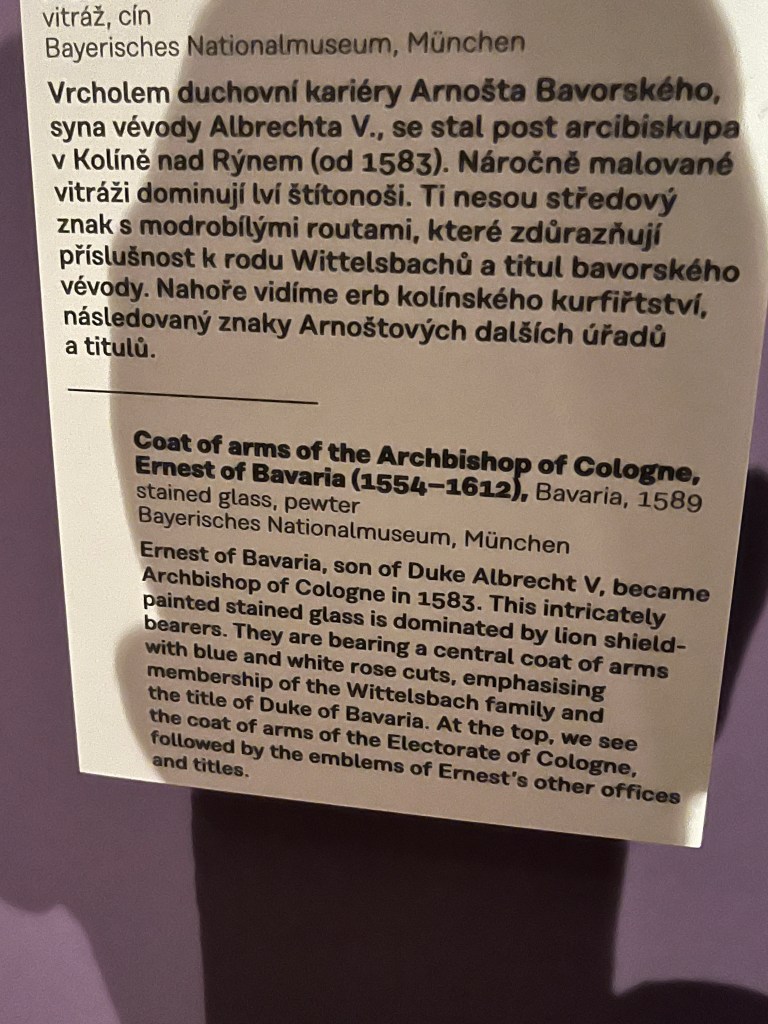
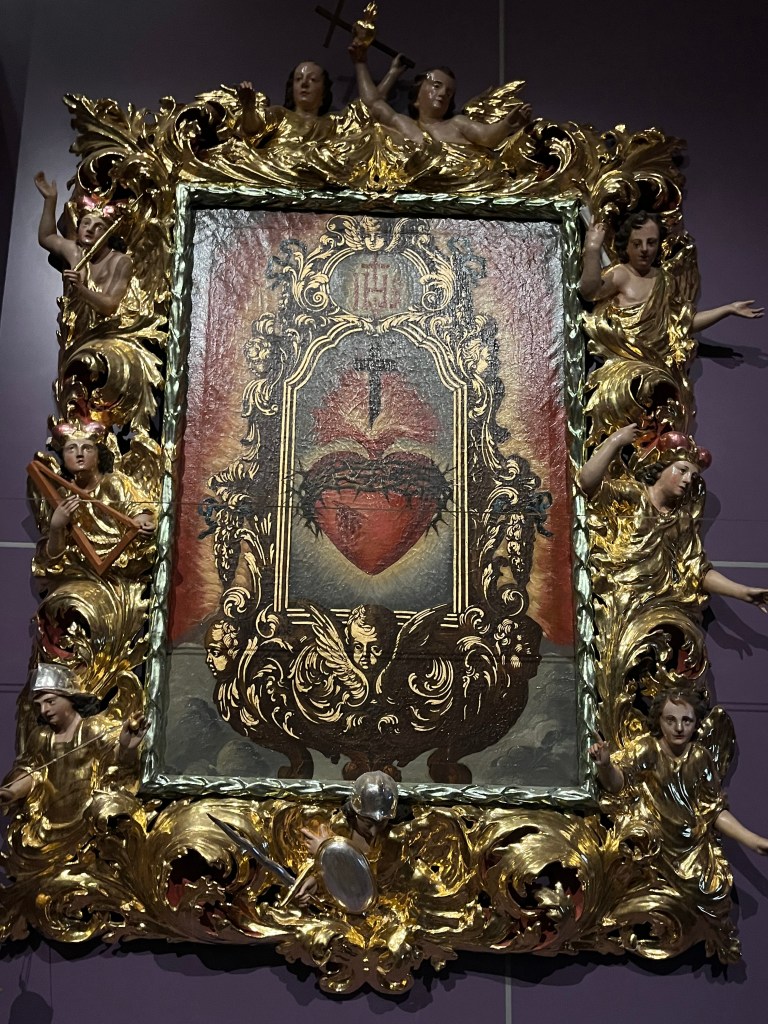


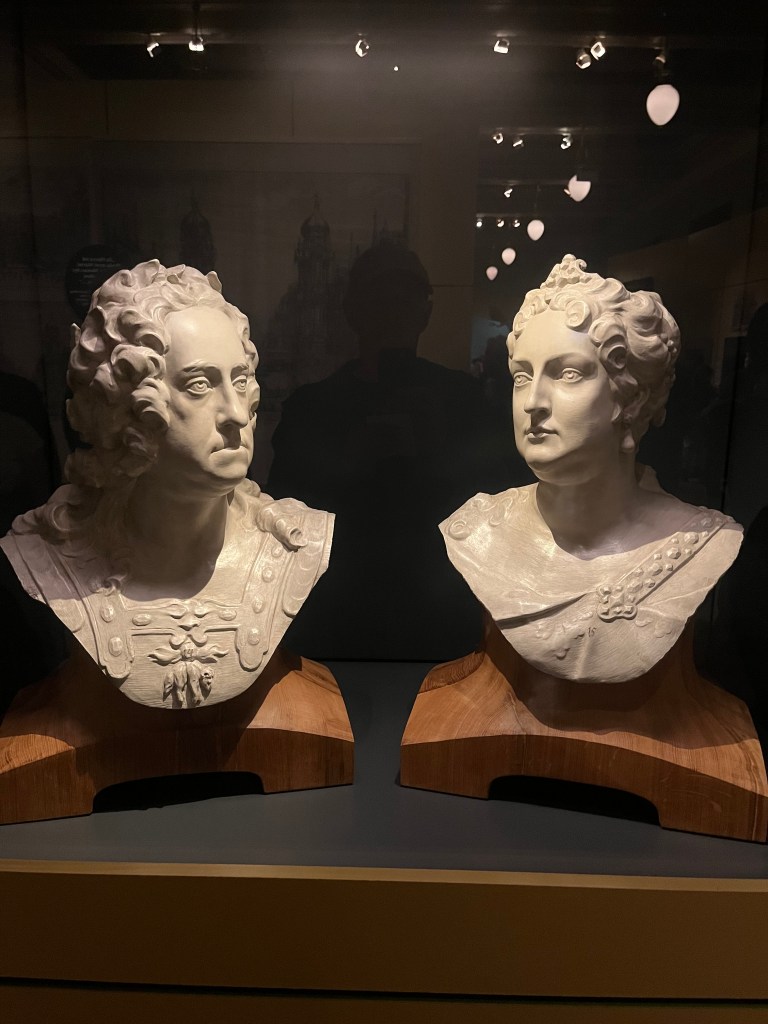



The third floor held a permanent natural history and rocks and minerals collection. There were thousands of minerals. I could’ve spent an hour there.
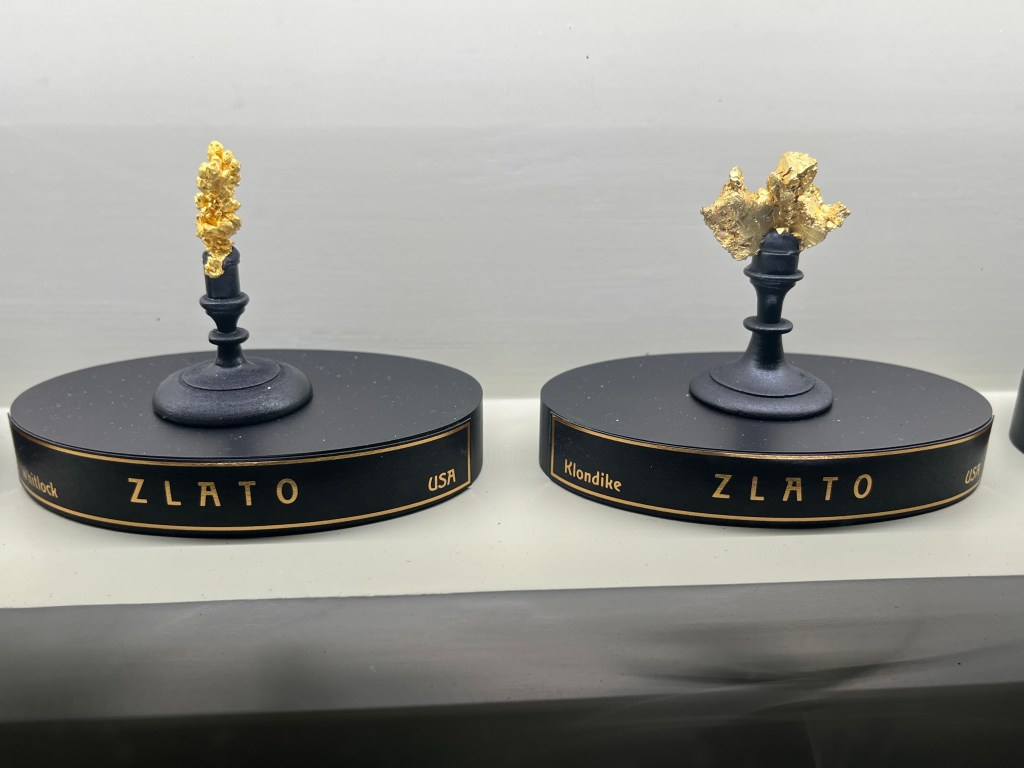
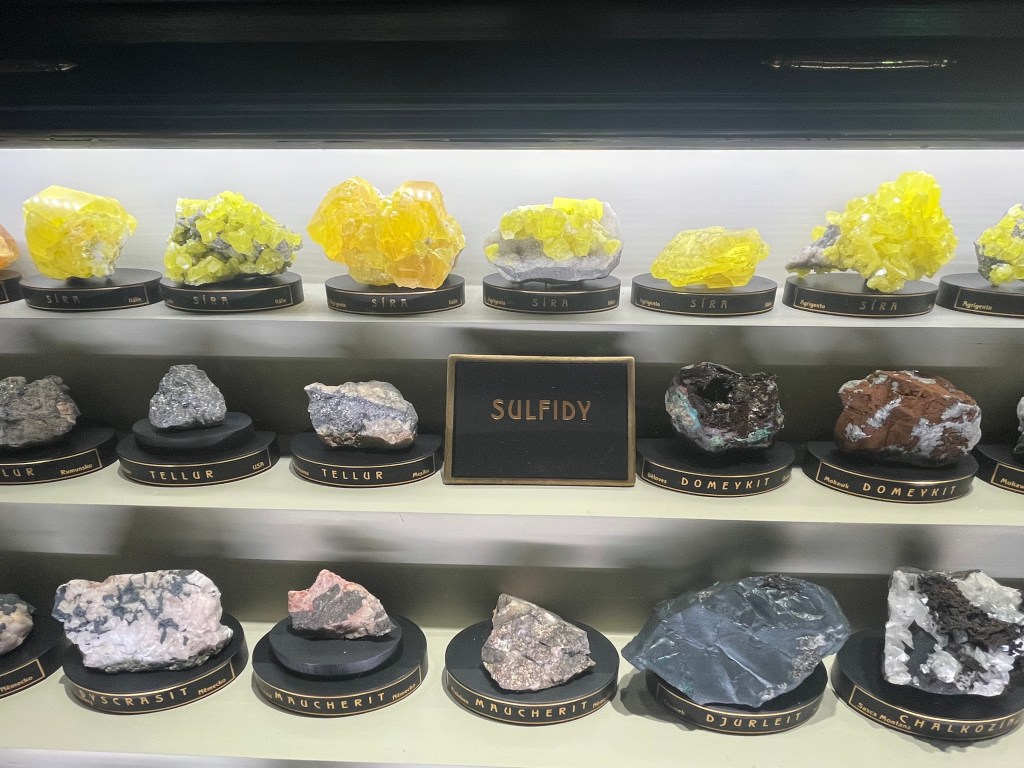

Finally, the second floor had a gallery devoted to the decade of the 1950s, during the most totalitarian period of Communist rule.


Political commissar teaching 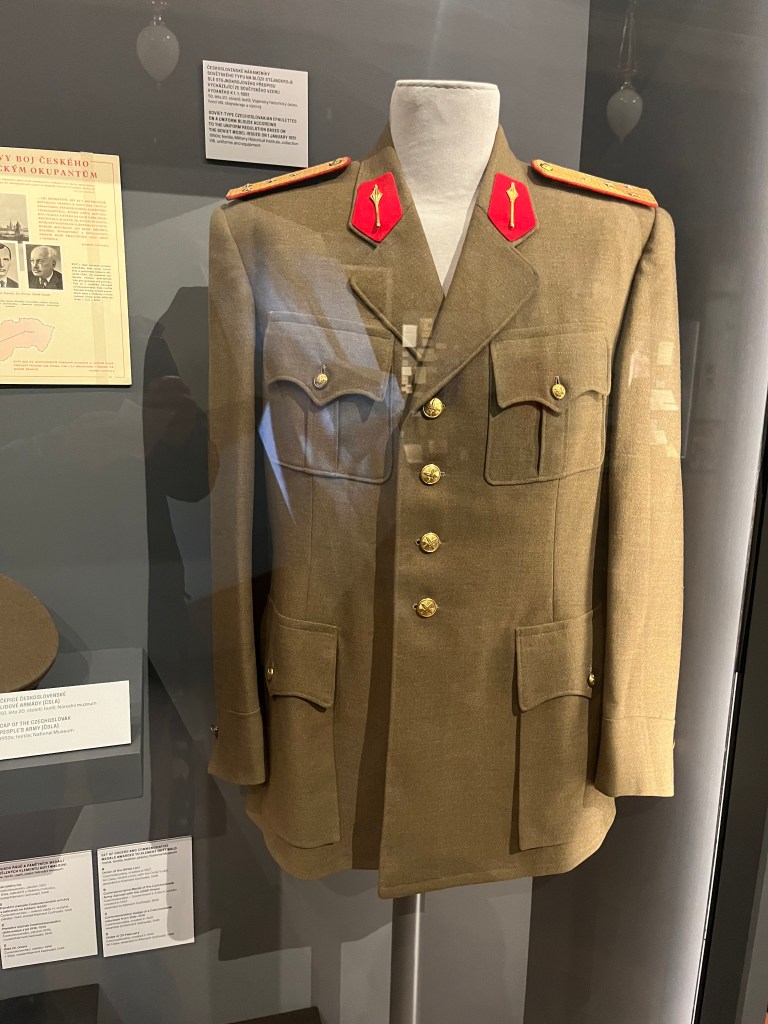
Officer’s uniform 
Czechoslovak People’s Army headgear & decorations 
The model proletarian 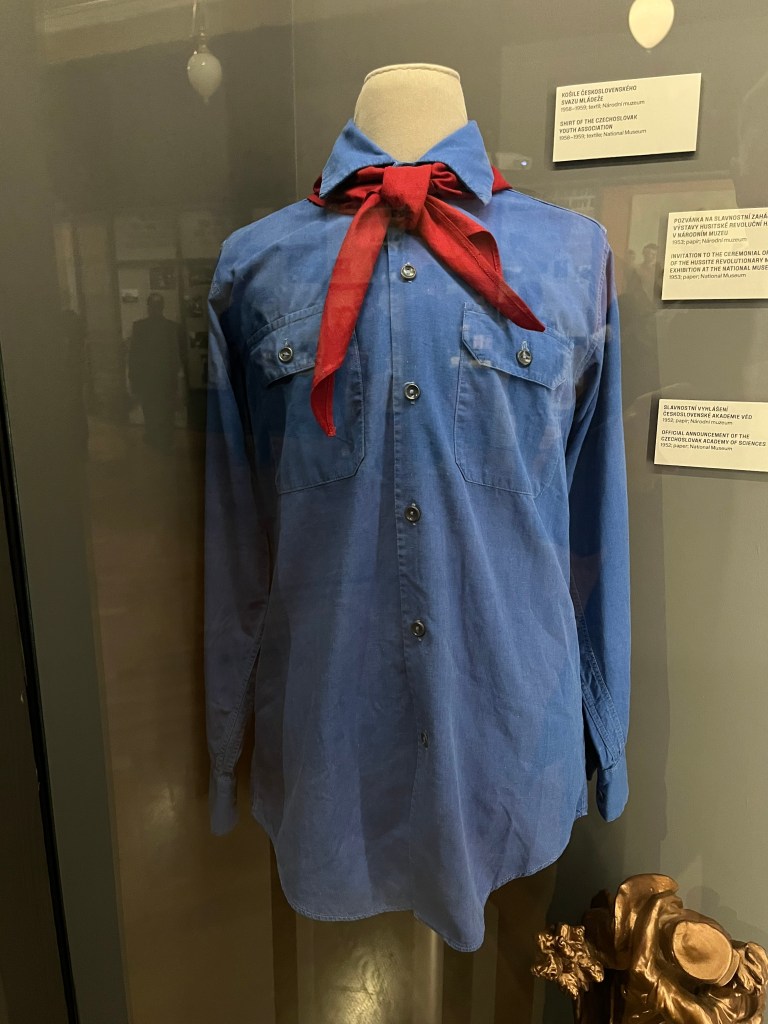
Young Pioneers uniform 
Building a new society 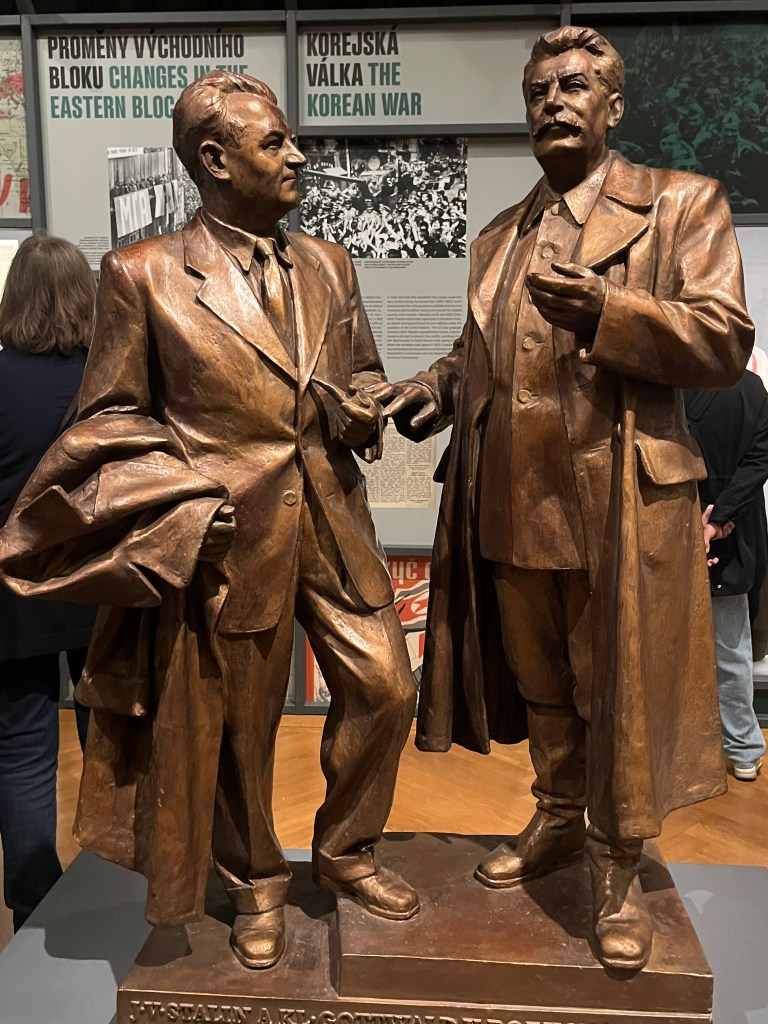
Klement Gottwald (L) with Comrade Stalin I decided to trek up the big hill and walk through the Nový Svět neighborhood in the rain and have a very late lunch at a charming bistro that I noticed on Sunday; but, alas, it was closed. So I popped into a surprisingly good local Czech place instead.
Rainy days are good for museums and churches, the latter of which Prague has a countless number, generally of the Baroque variety. Like Wagner’s operas though, a little bit of Baroque goes a long way. Nonetheless I decided to enter the Loreto monastery, a place I’ve photographed and walked past both this week and in 2021.
I forgot what a big thing relics once were. From fingers to fingernails, from bones to shriveled feet, the number of these macabre fragments, often encased in gold or crystal, boggles the mind. The Loreto’s small museum was worth the visit. I even left an amusing note in the guestbook. When I was on my way out, it had already closed and the sextant unlocked the gate for me.


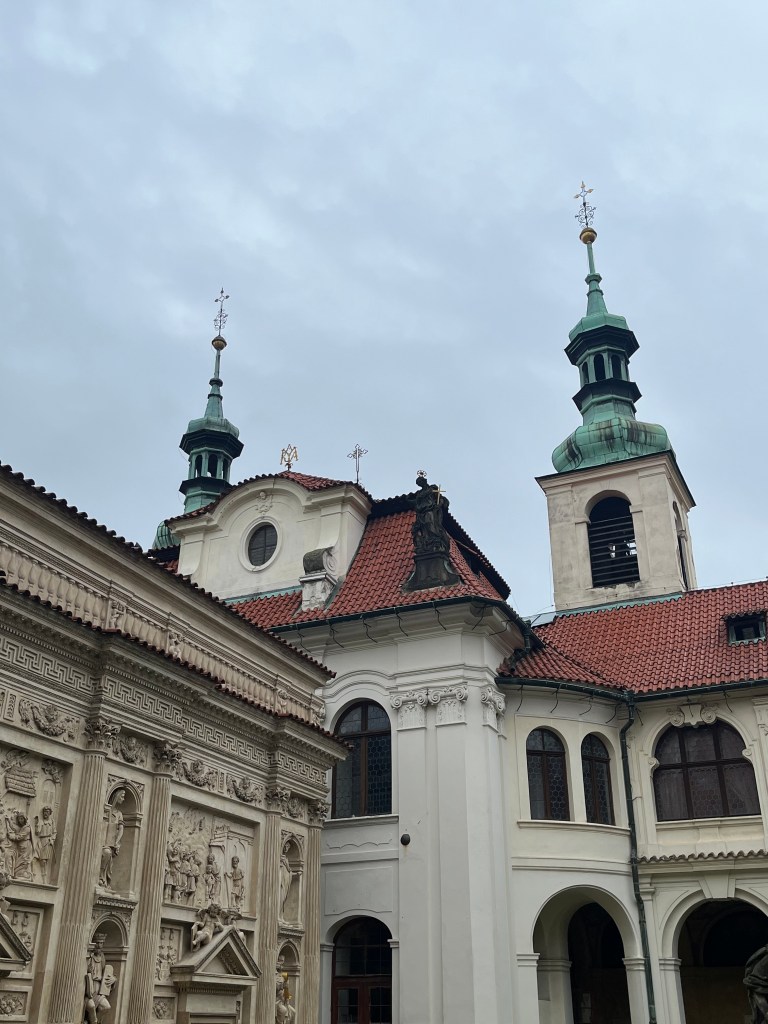
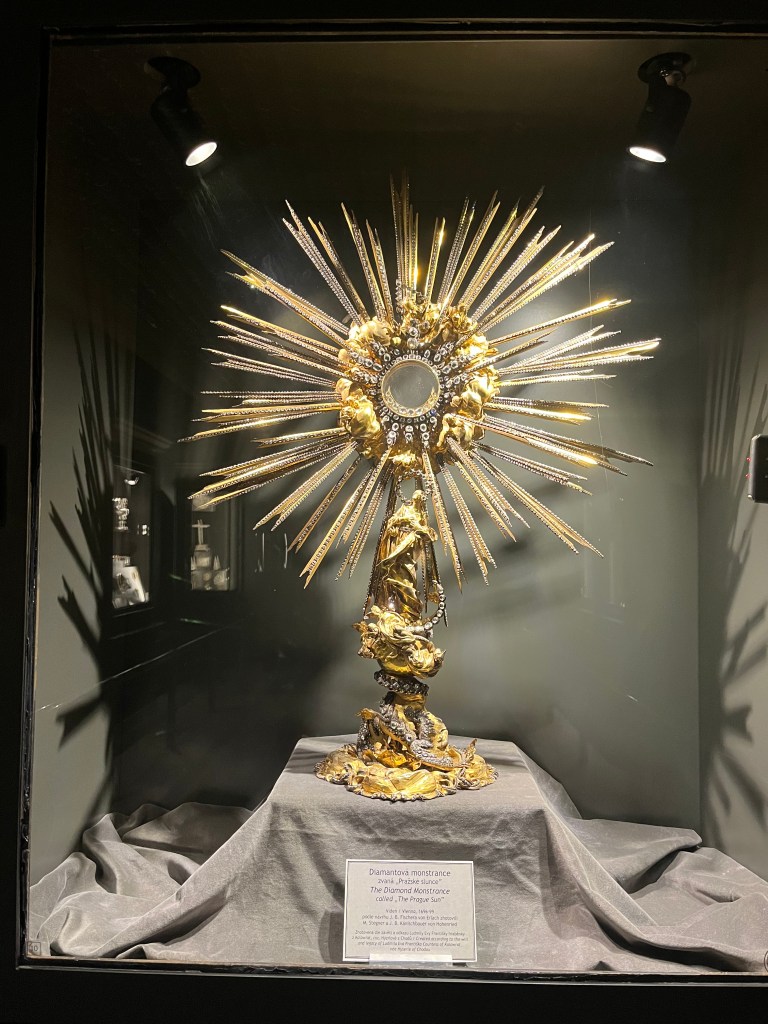

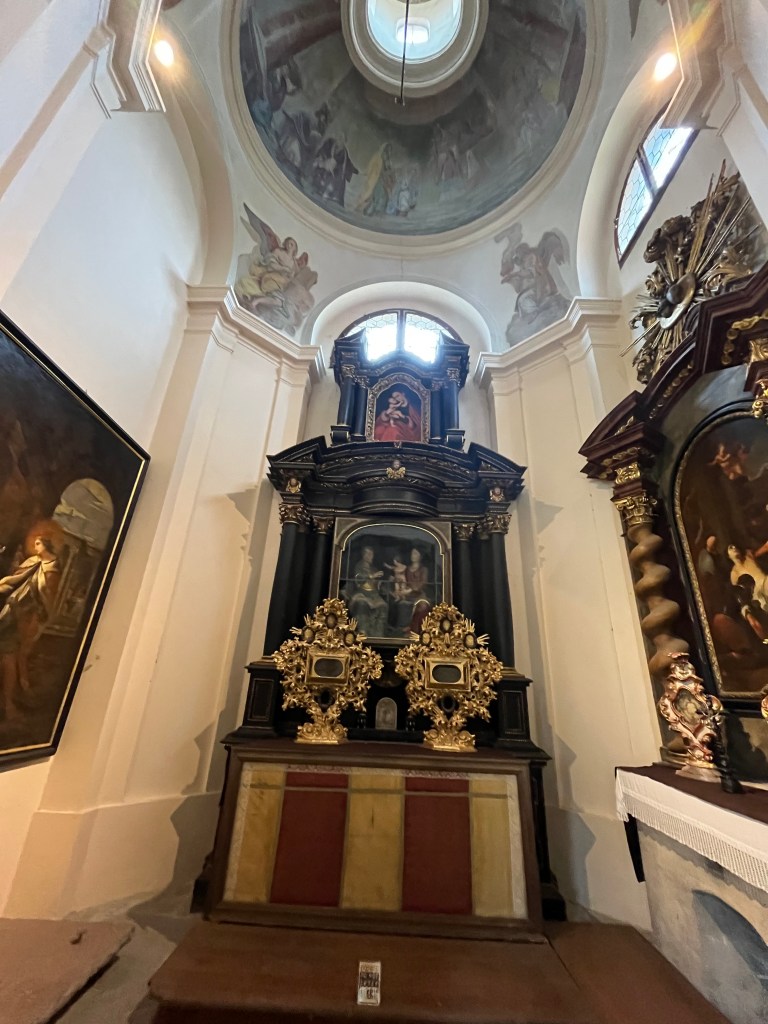

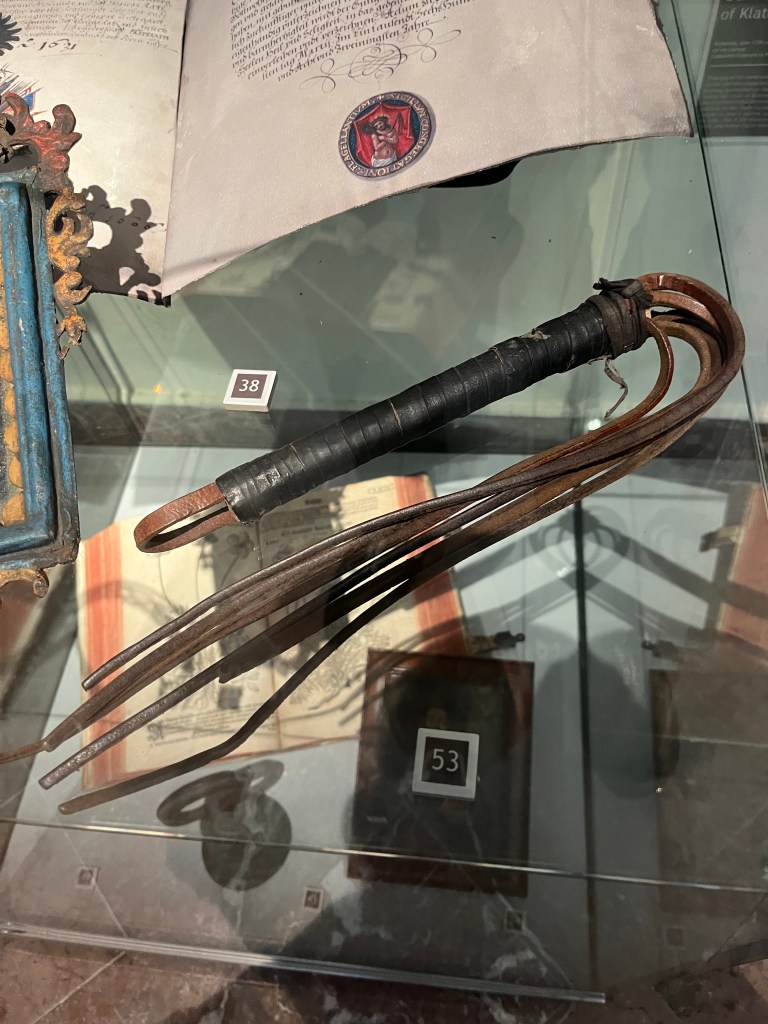

I imagine the last exhibit would induce excitement in some quarters, not necessarily of the penitential sort.
From Nový Svêt I got a nice pic of the distant St Vitus Cathedral before popping into the Baroque Church of the Virgin Mary, Mother of Perpetual Help.


I’ll probably hang around the neighborhood tonight since I fly back tomorrow. At least I’m leaving at a civilized hour!
-
A Return Visit to Lidice: May 6, 2024
When traveling, I sometimes indulge in “dark tourism” out of my great curiosity about the effects of wars and authoritarian governments. When I first visited Prague a few weeks after 9/11, I ventured out to see Lidice, the site of an infamous massacre that the SS perpetrated on a small village on June 10, 1942 following the assassination of SS Reichsprotektor and Hitler protégé Reinhard Heinrich at the end of May. His assassination was planned by British intelligence, who trained Czech operatives in covert operations and parachuted two of them into the Prague region. Operation Anthropoid was the name of the venture. The 2015 movie Anthropoid is worth watching.
Hitler was enraged by the loss of Heydrich and ordered that any town suspected of harboring the assassins or accomplices be razed to the ground and its inhabitants killed. The SS fingered the village of Lidice for annihilation, even though there was no evidence that the townspeople had hidden any of the operatives.
On June 10 the SS descended on the town of 503. All men and boys over the age of 15 were shot by firing squads. Several men who were away that day were later arrested and executed. 187 women and 88 children were sent to concentration camps. The women were placed at Ravensbrück. 83 of the children were gassed at Chełmno. Only a few survived the war.
The SS then blew up the town’s buildings, killed all the animals and plowed the fields under, literally wiping the village off the face of the earth. The well publicized reprisal caused an uproar in the Allied countries.
This afternoon, the site was lushly green and pleasant. There were no tourists. I was the only visitor to the museum, which started with a ten-minute film. Afterwards I toured the exhibit, which featured photographs of many of the victims from early 1942 before the massacre. The following pics are from the museum and adjoining grounds.

I find this simple sign ominous 
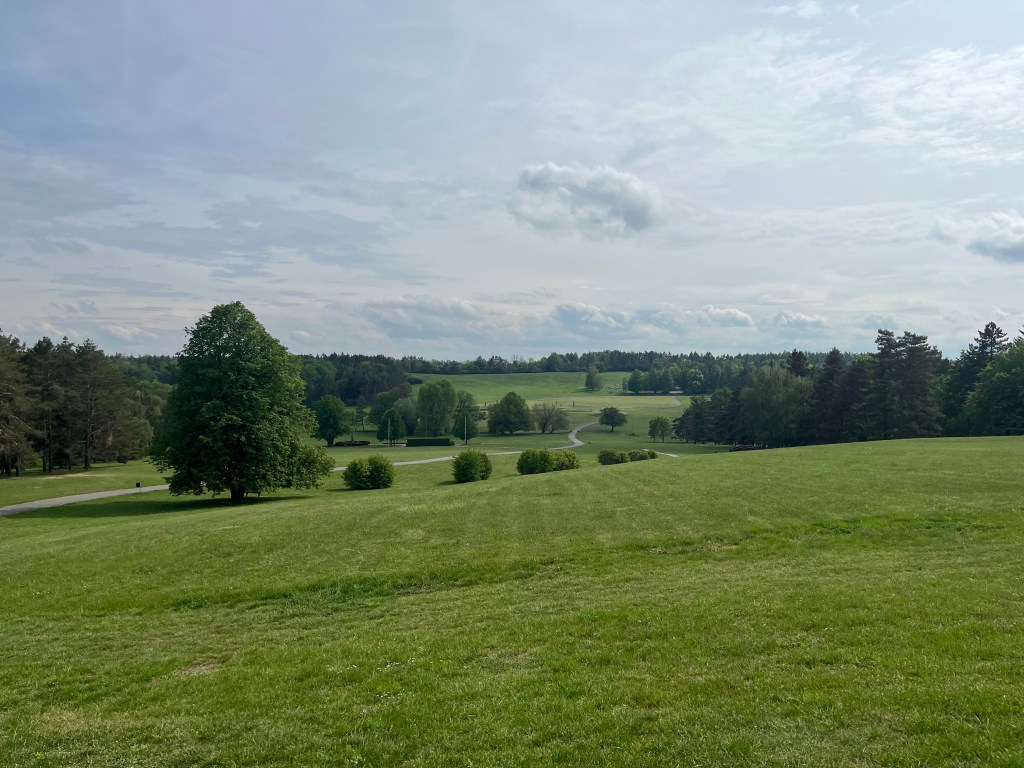
Site of the village 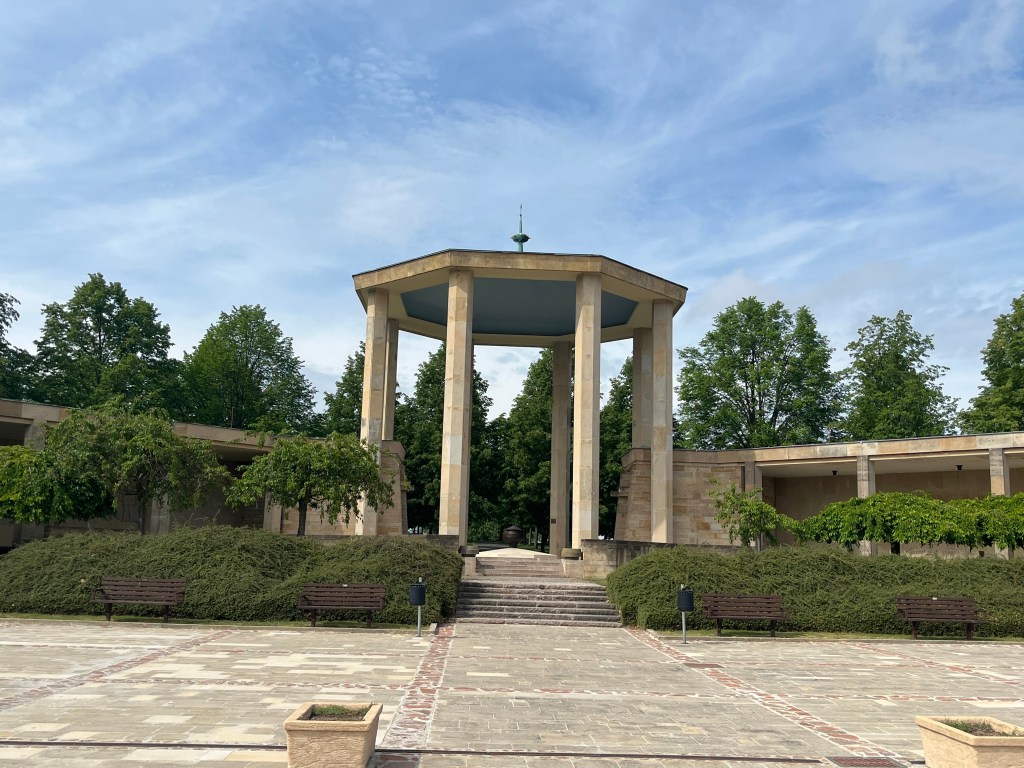
The museum and rotunda 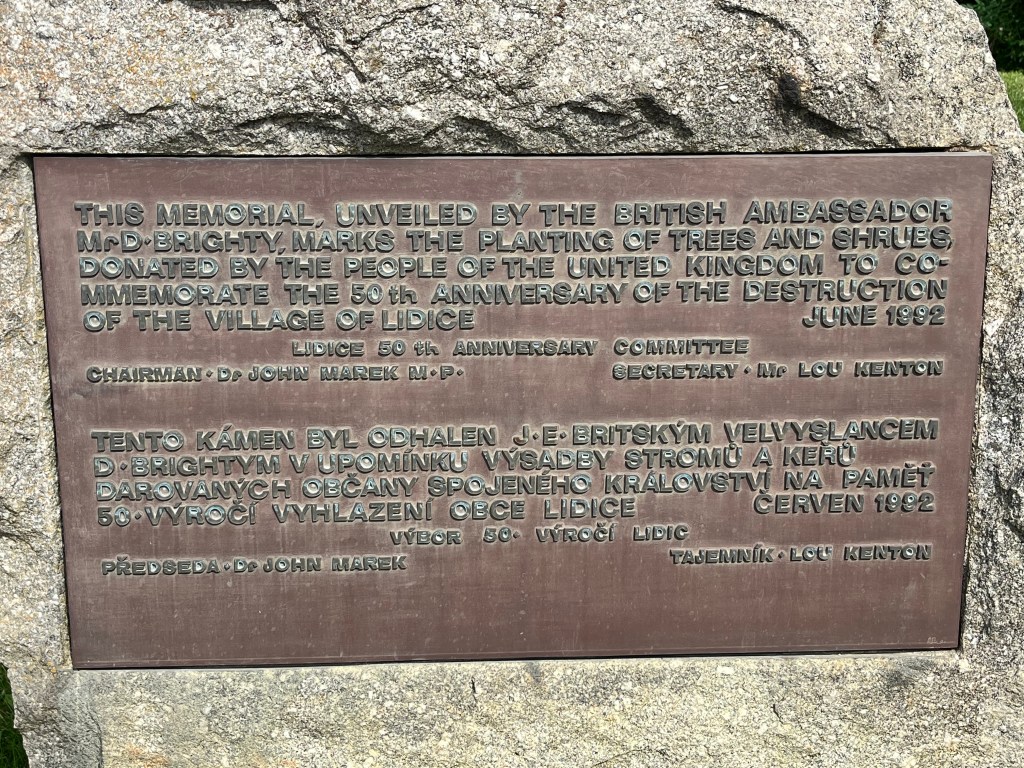
Memorial plaque 
Lidice schoolchildren 
The surviving doors to the village church 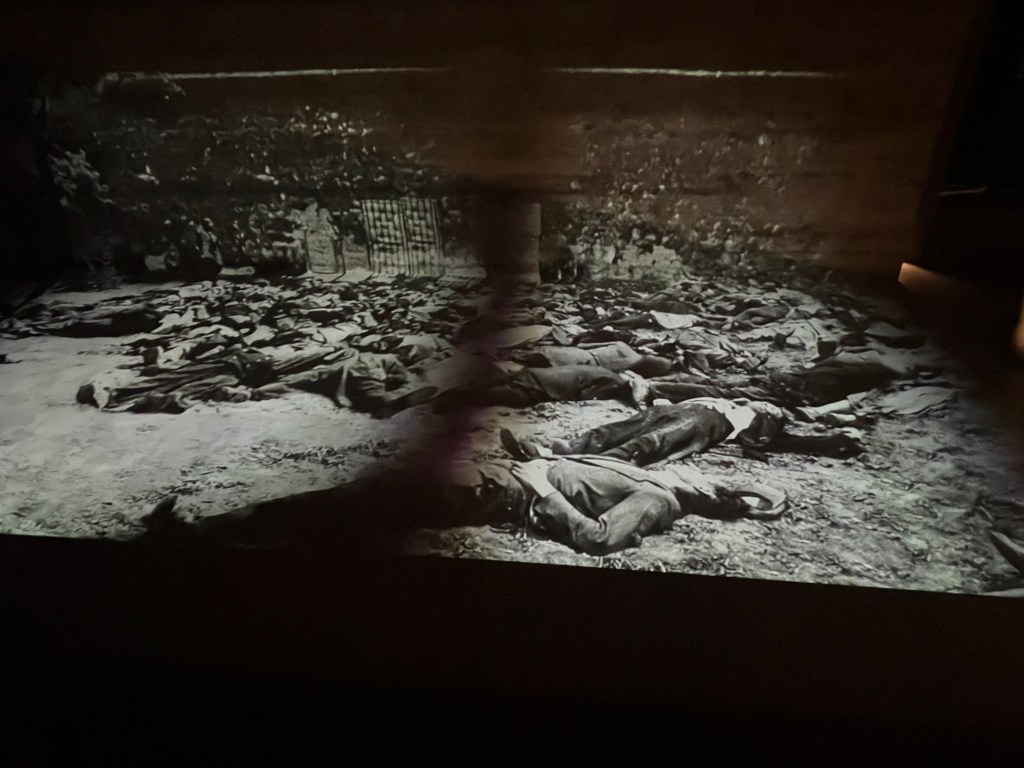
German photograph of executed men After the museum visit, I took a long walk through the same memorial fields that I’d taken in October 2001. Again, except for two local couples walking their dogs, I was the only visitor. The memorial statue to the children was heart-rending and emotional, just as it had been 23 years ago.
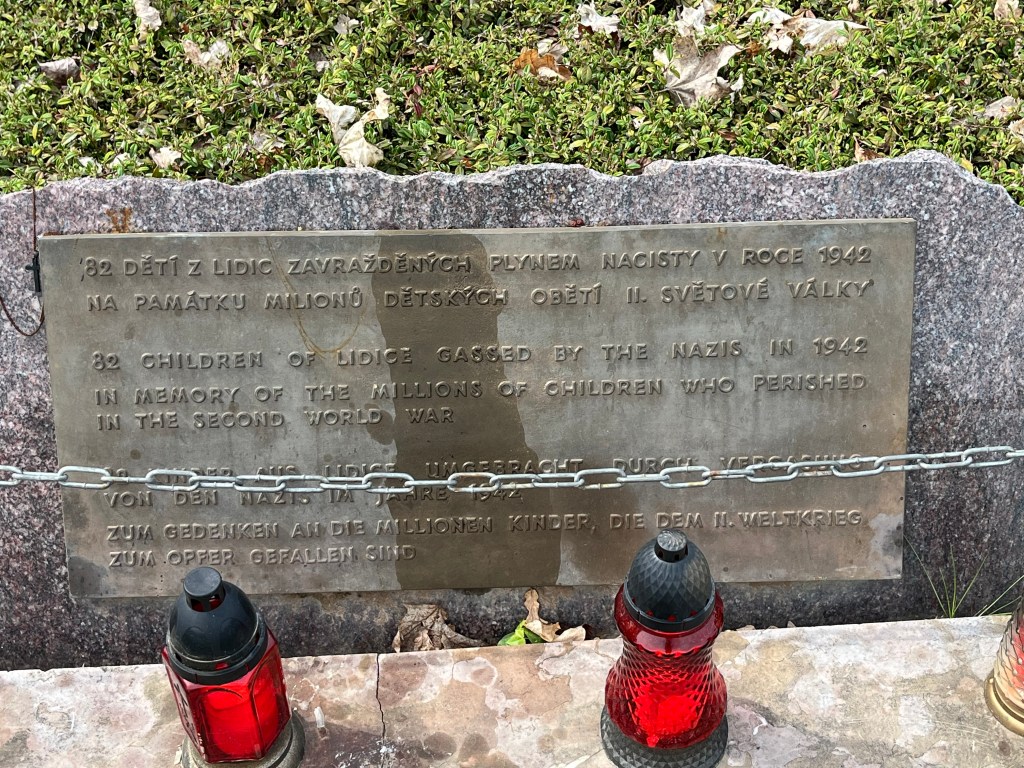
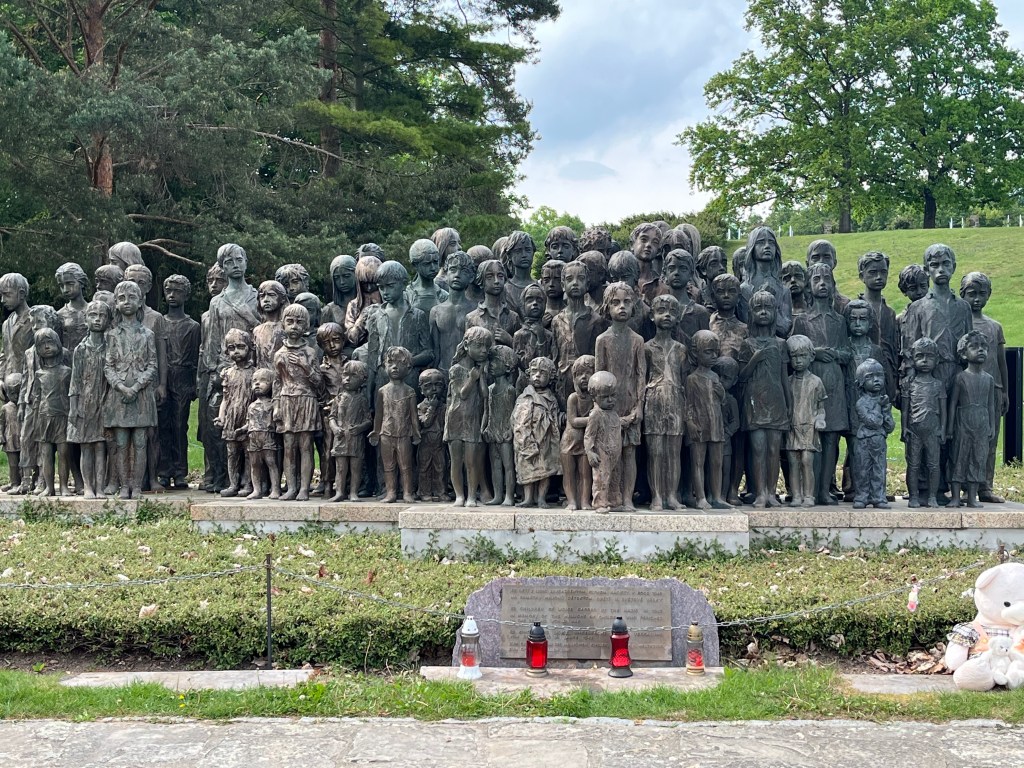


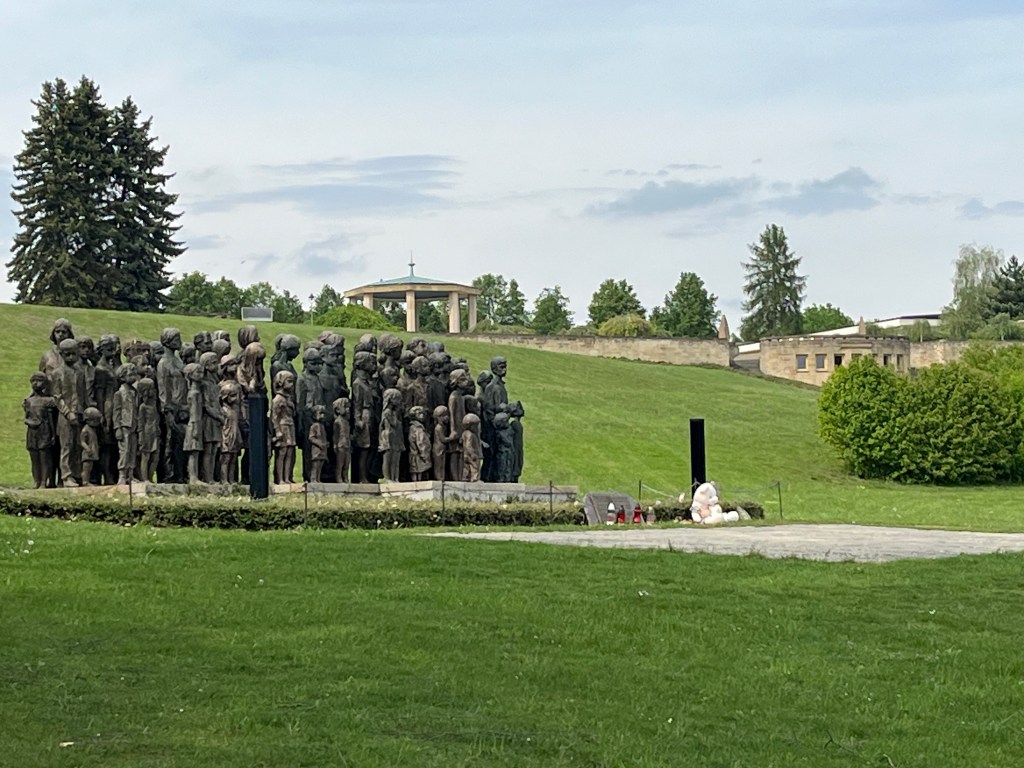
Looking back towards the museum Next, I walked to the site of the village church, a memorial at the burial ground of the village’s murdered men, and then to the only remains of one of the village houses.

Men’s burial dite 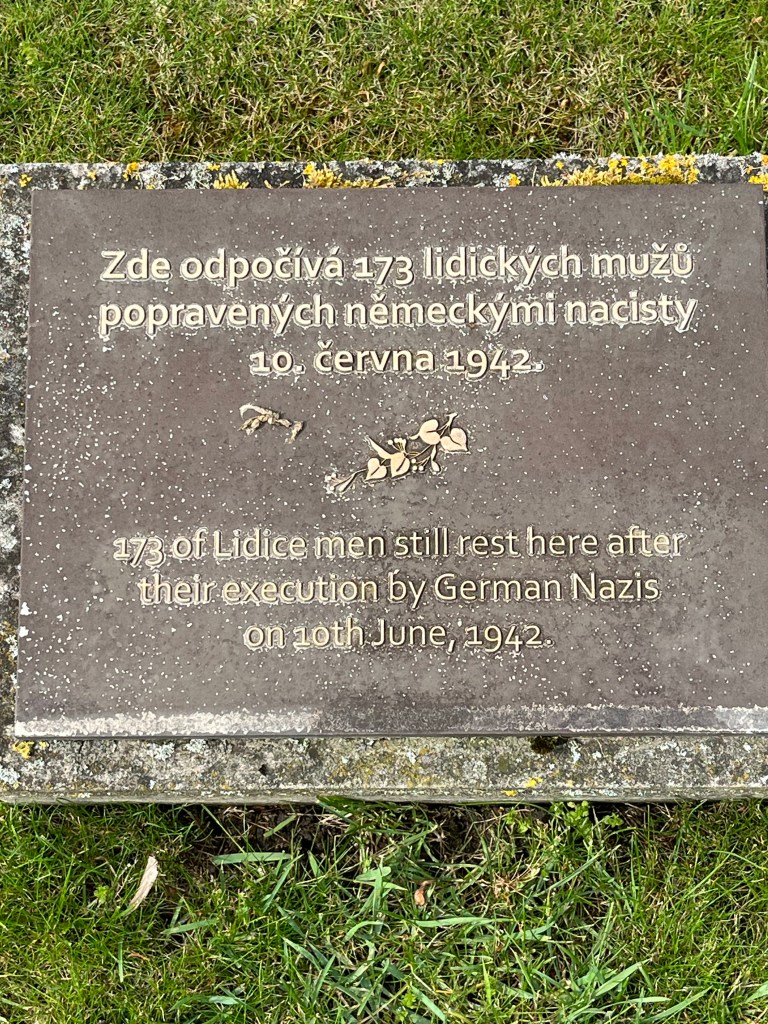


Memorial to the women of Lidice 
Sole remaining ruins of a village house 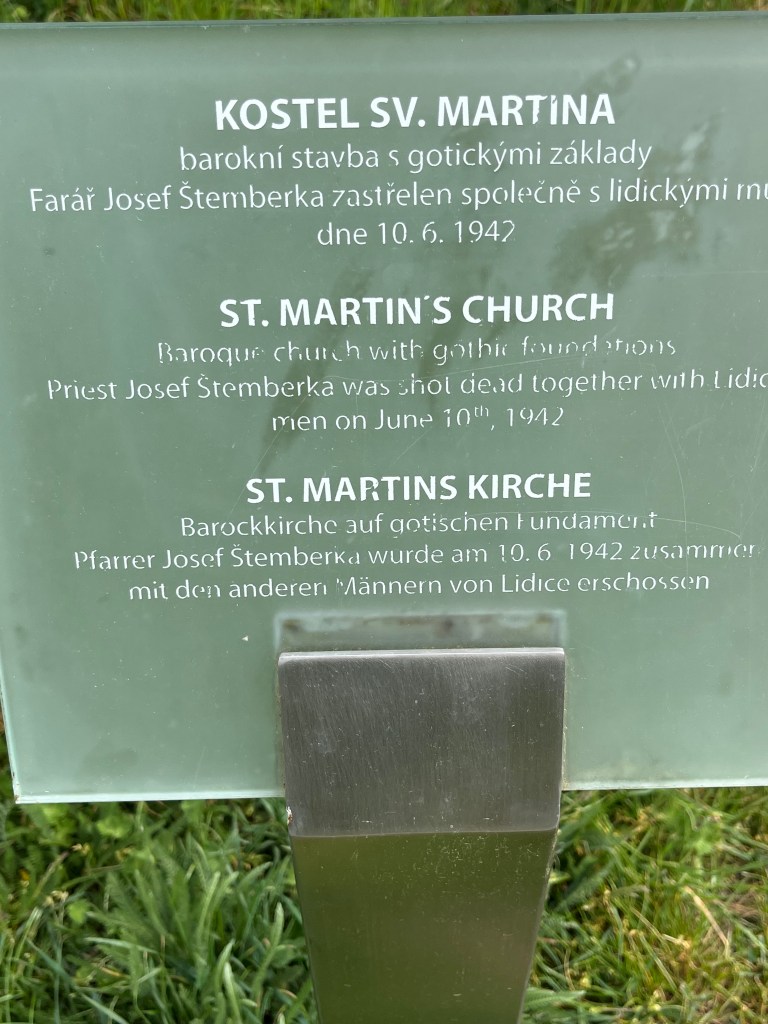

Site of St Martin’s Church 
View from the church site 
The rebuilt Lidice in the distance For most, foreign travel is about enjoying new cities and delighting in other cultures. In my 16 trips to Europe, I also wanted to encounter the darker side of history, of the terrible inhumanity that has occurred in the past and which still continues. I was deeply moved by this visit to an otherwise bucolic countryside. After viewing the children’s memorial, I had to walk into the woods and dry my eyes. I shudder just writing about it.
-
Prague Day 2: May 6, 2024
After a coffee, I struck out across the Charles Bridge to check out Staré Město and Nové Město before the crowds emerged. I was able to take some pictures of the statues and views from the bridge, including Prague Castle up on the hill.

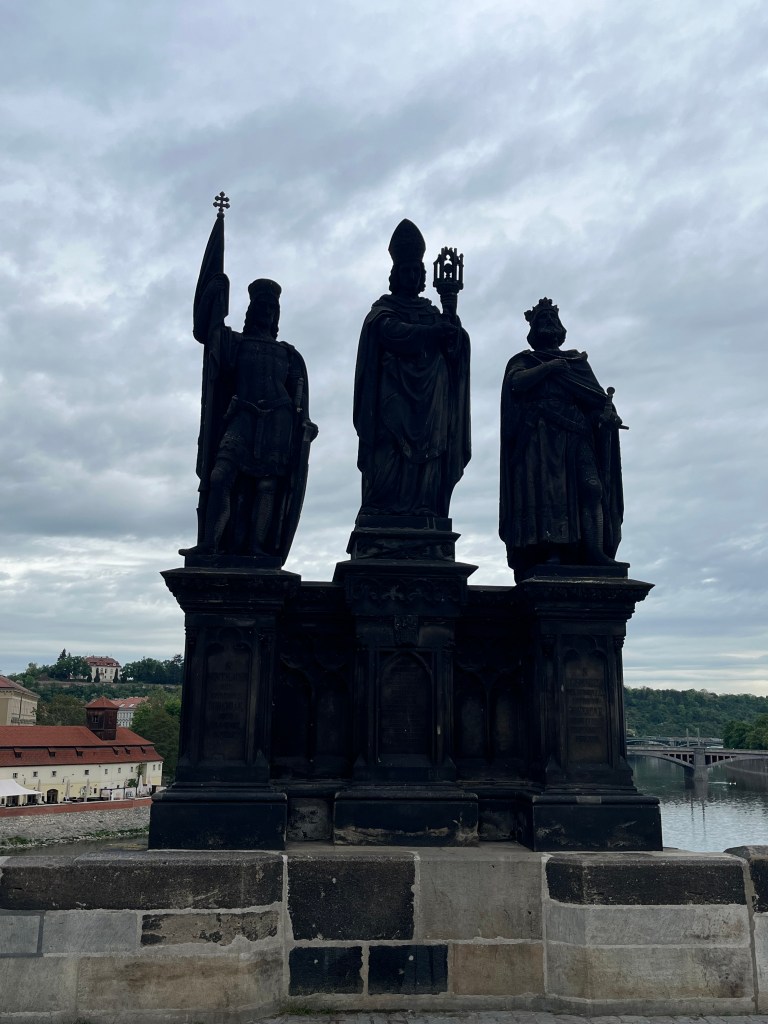
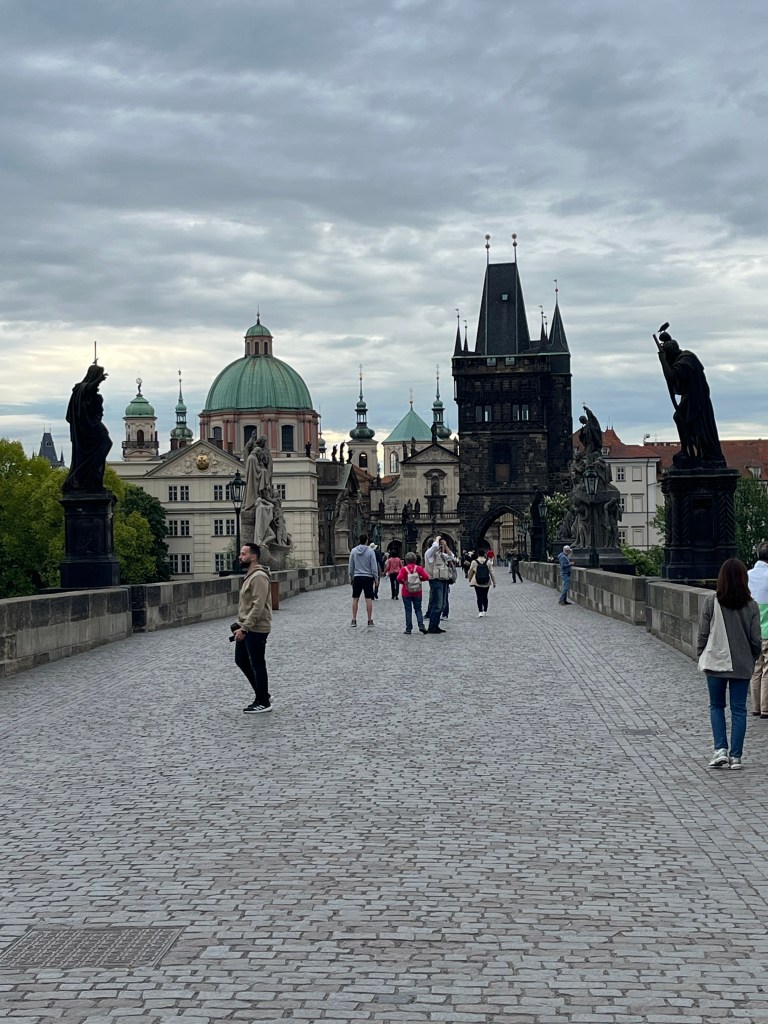



Powder Gate 1475 After passing through the Powder Gate I meandered through the narrow streets, filled with kitschy tourist shops and mediocre restaurants, including several Starbucks (of course). I soon found myself on Václavské Námesty (Wenceslas Square) where I stepped into a charming coffee shop, Paul, established in 1889, for a flat white and a tiny pastry. As I made my way east to the equestrian statue of St Wenceslas and the Museum, I eyed a discreet monument to Jan Palach and Jan Zajic, two Czech students who immolated themselves in an act of protest against the Soviet-led Warsaw Pact invasion in August 1968 which ended the liberalizing Prague Spring.

Paul 
Marker for the two students 
St Wenceslas 
National Museum 1880s Next I made my way to Wilsonova St., where the main train station is located across from a statue of Wilson, who seems more serene here than at home.


I’m a fan of European sidewalks, which are a welcome relief from the brutalist reinforced concrete that is universal in the US.

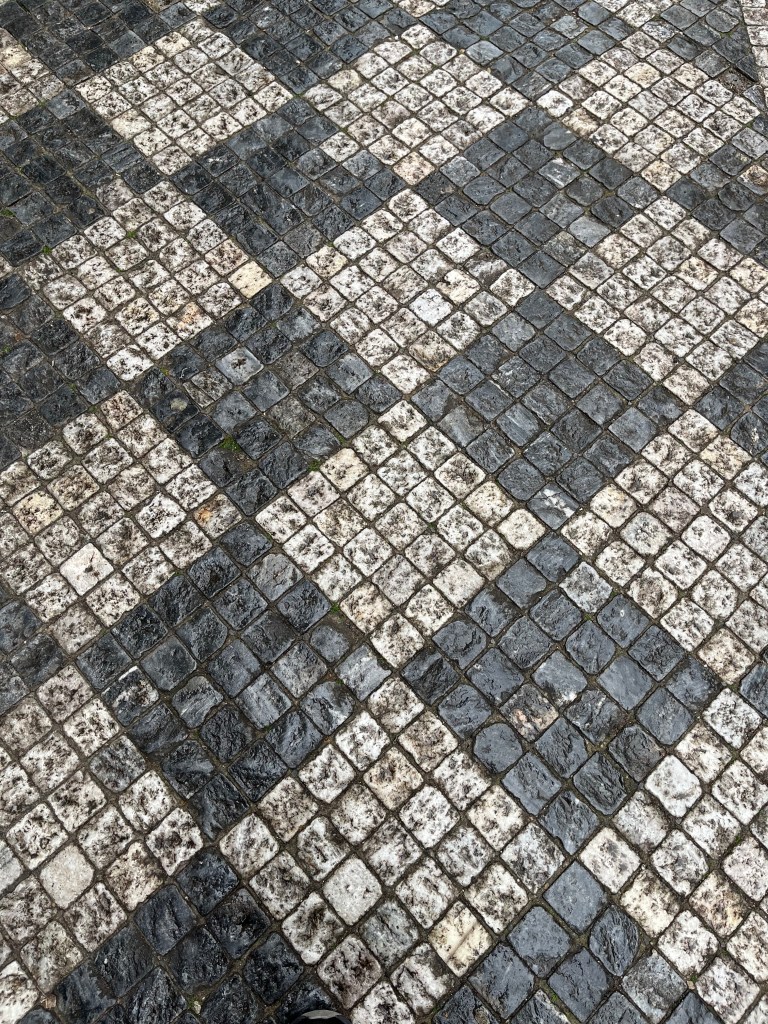

It was time to head back to the Airbnb so I headed west through Old Town as the crowds began to build. I noted a few interesting restaurants on side streets which I photographed for possible dinner choices.
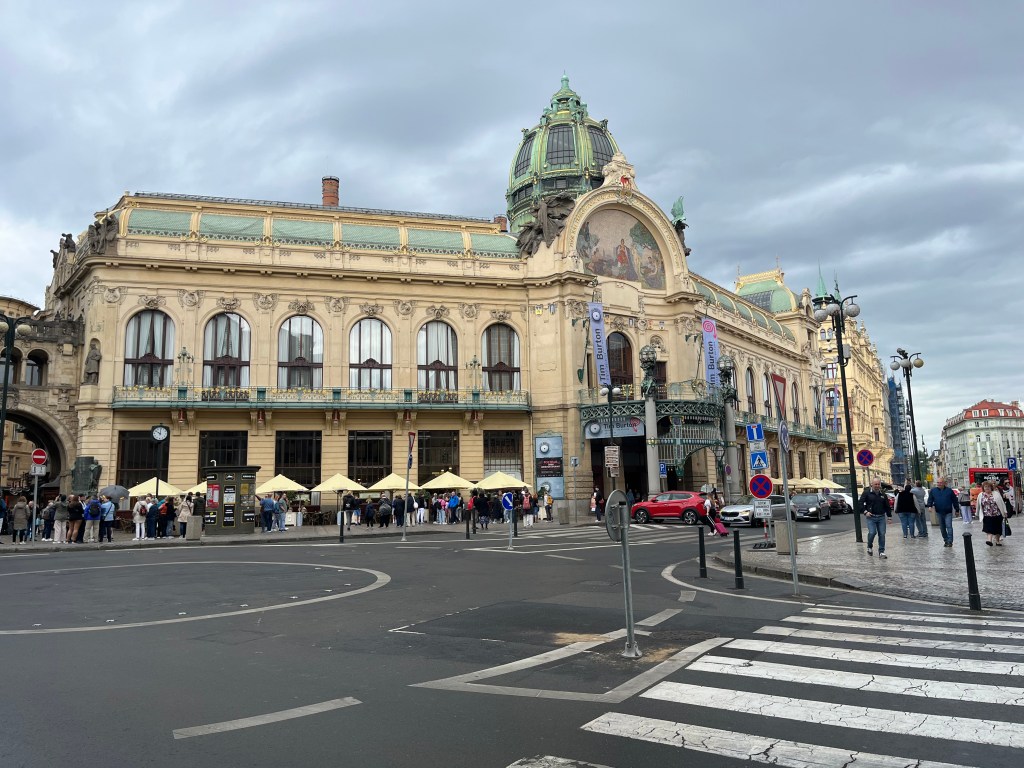
Art Deco Municipal House 
Czech National Bank 
Entrance to St Jacob Cloister 1690 
St Jacob Cloister steeple 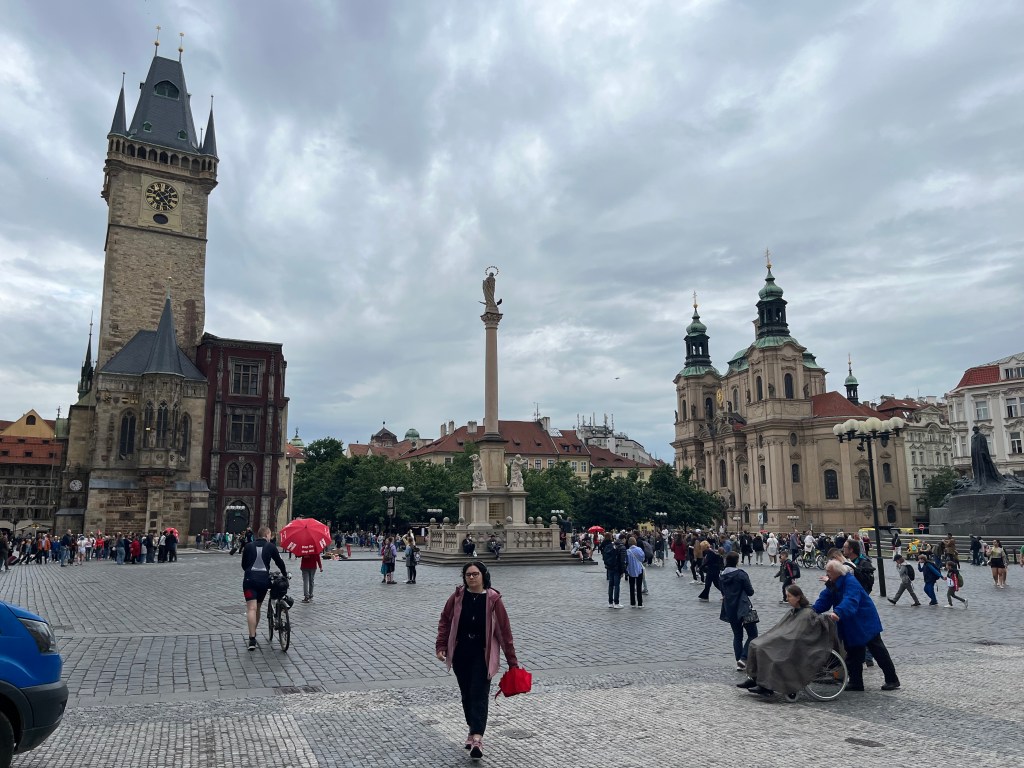
Old Town Square 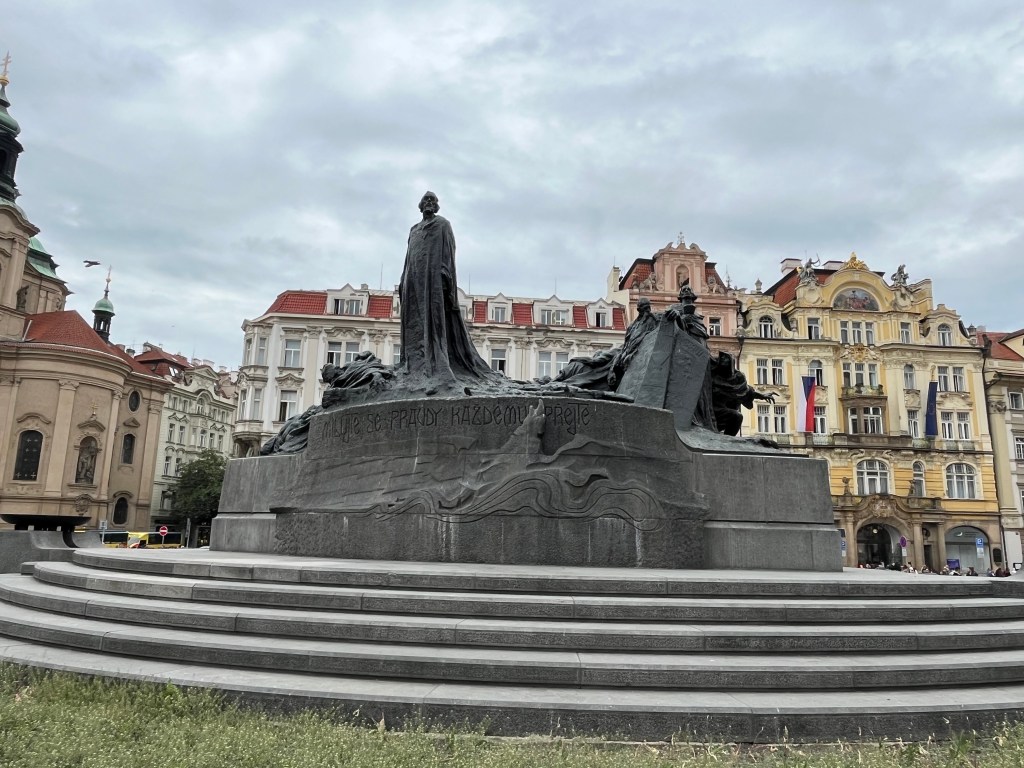
Monument to heretic Jan Hus, burned at the stake in 1415 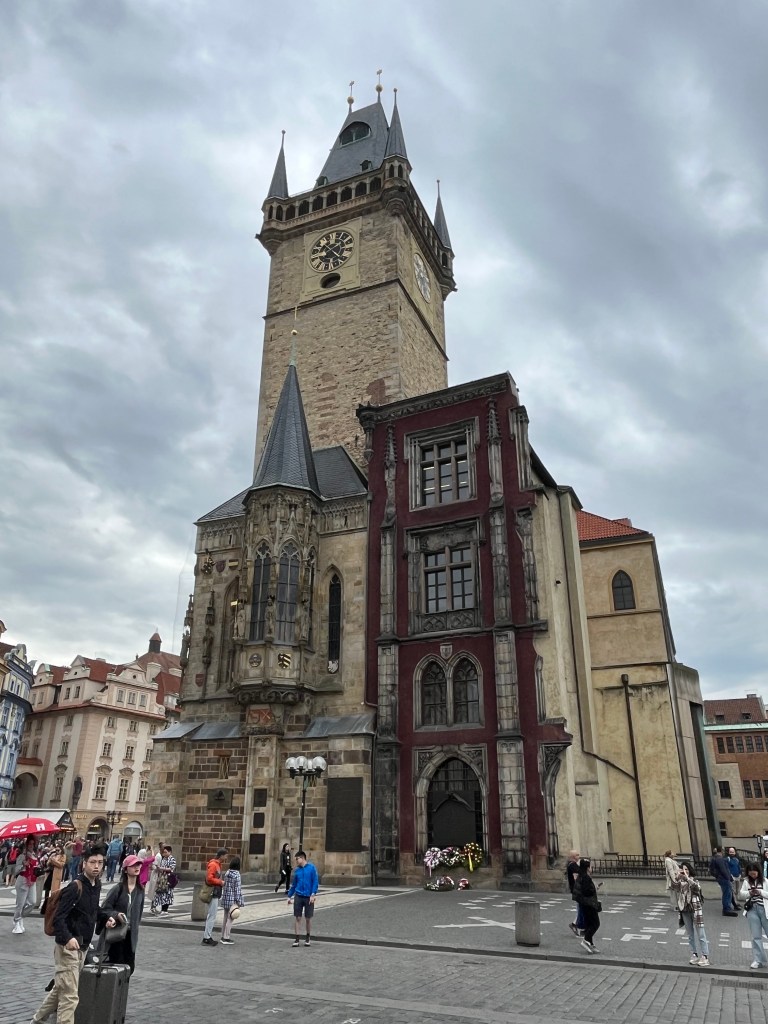
Old Town Hall Tower 
The iconic Astronomical Clock on Old Town Hall 15th c. The St Nicholas Cathedral, erected in the 14th c., is also known as the Hussite Church, which is pretty ornate for a Protestant church since it was formerly a Catholic cathedral.




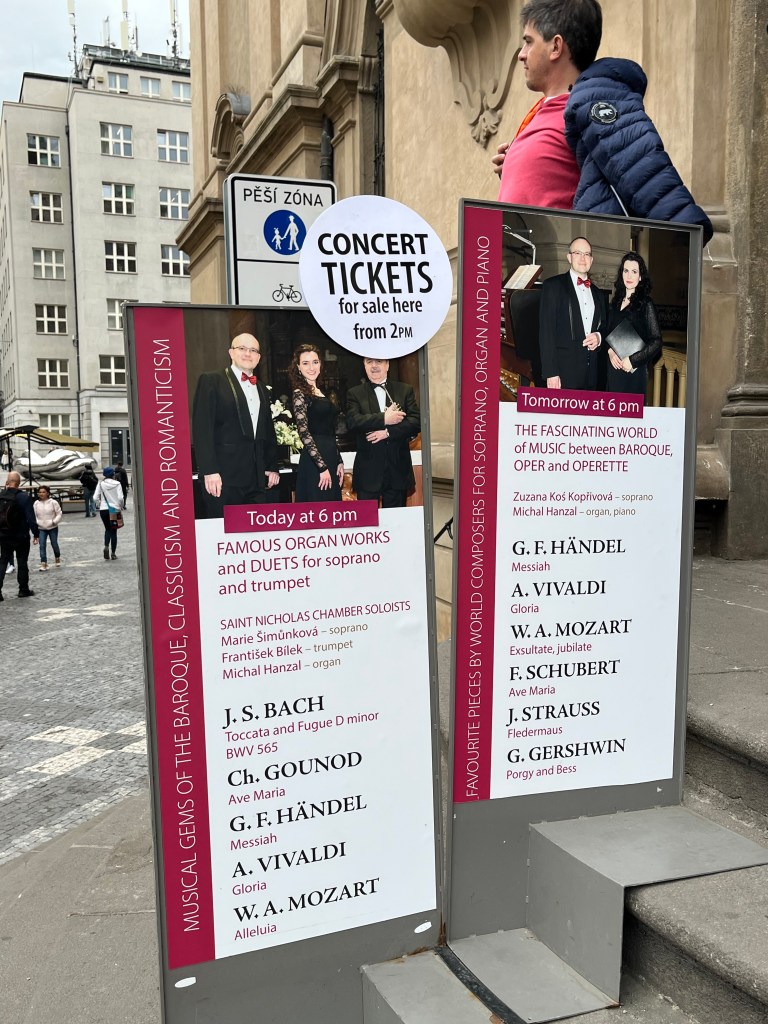
I may try to attend one of the Baroque music concerts while I’m here.
The number of historic churches and palaces in Prague can become mind-numbing, but this morning’s walk-about covers the highlights. With the crowds surging, it was time to make my escape from Staré Město after logging five miles on my morning walk.
In the early afternoon I decided to journey out to Lidice by metro and then a 20 minute bus ride into the Bohemian countryside. I’d visited it in early October 2001 and wanted to see if any changes had been made. I’ll describe the visit in a separate post.
When I returned to Prague I walked back into Nové Město to try out Vinograf, a cool wine bar that I’d passed earlier. I tried some of their wines and had two appetizers which were delicious. I then headed back to my Airbnb to hang out for the evening. I may travel to Brno tomorrow by train to see a little bit of Moravia. I clocked 11 miles today.
-
Dresden to Prague: May 5, 2024
This morning I went for another walk around the Altstadt and visited the Staatliche Kunstammlungen to view the religious objects on loan from St Vitus Cathedral in Prague. There were a number of macabre reliquaries with actual pieces of flesh and fingers from saints. The exhibit also featured a small collection of icons and metal busts of prominent Bohemian nobles and bishops. It was coincidental that I was heading to Prague later that day.

Museum interior staircase 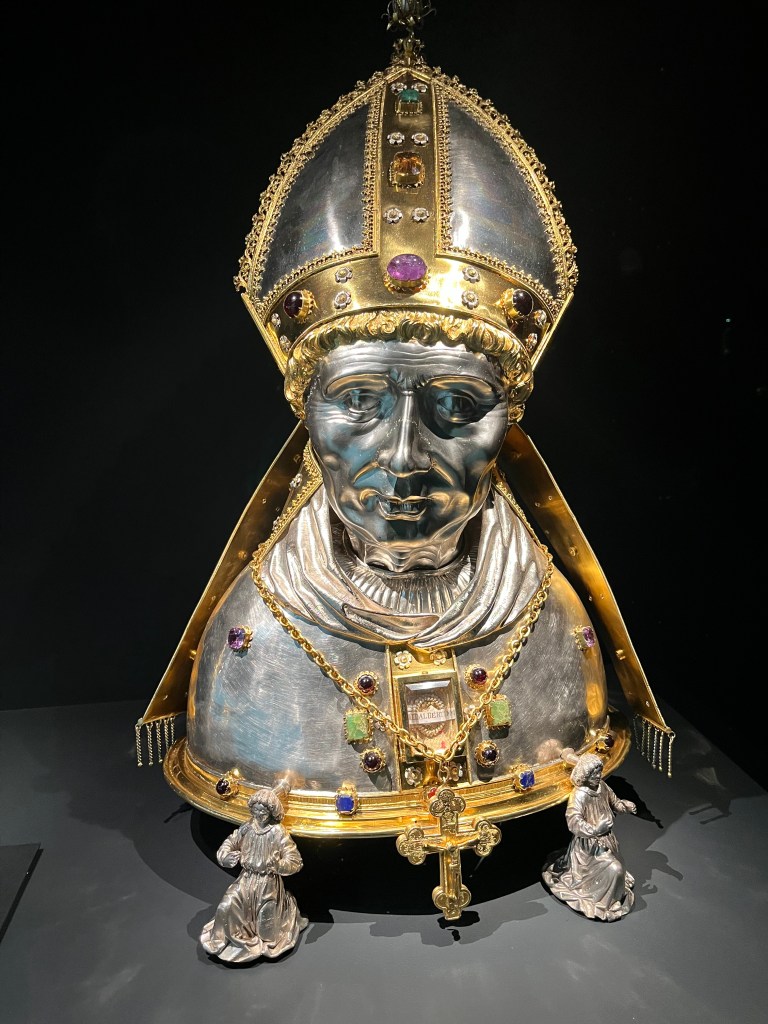
St Adalbert late 15th c. 

Reliquary bust of St Wenceslas 15th c. 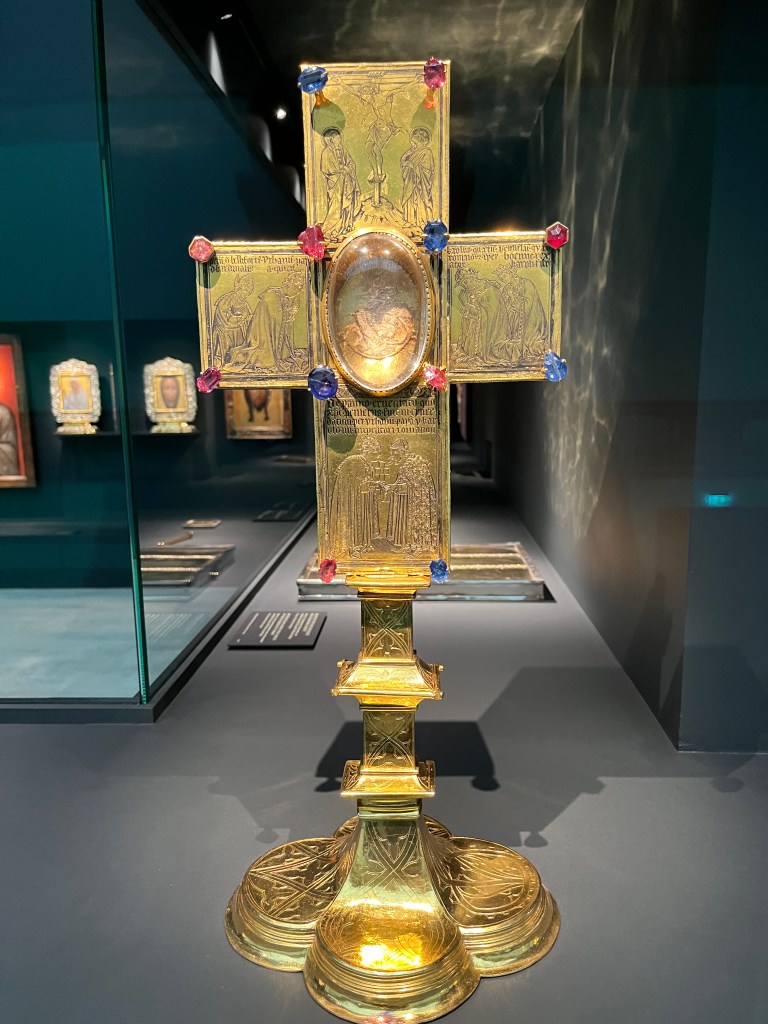
Golden Cross Prague 1369 
Jesus 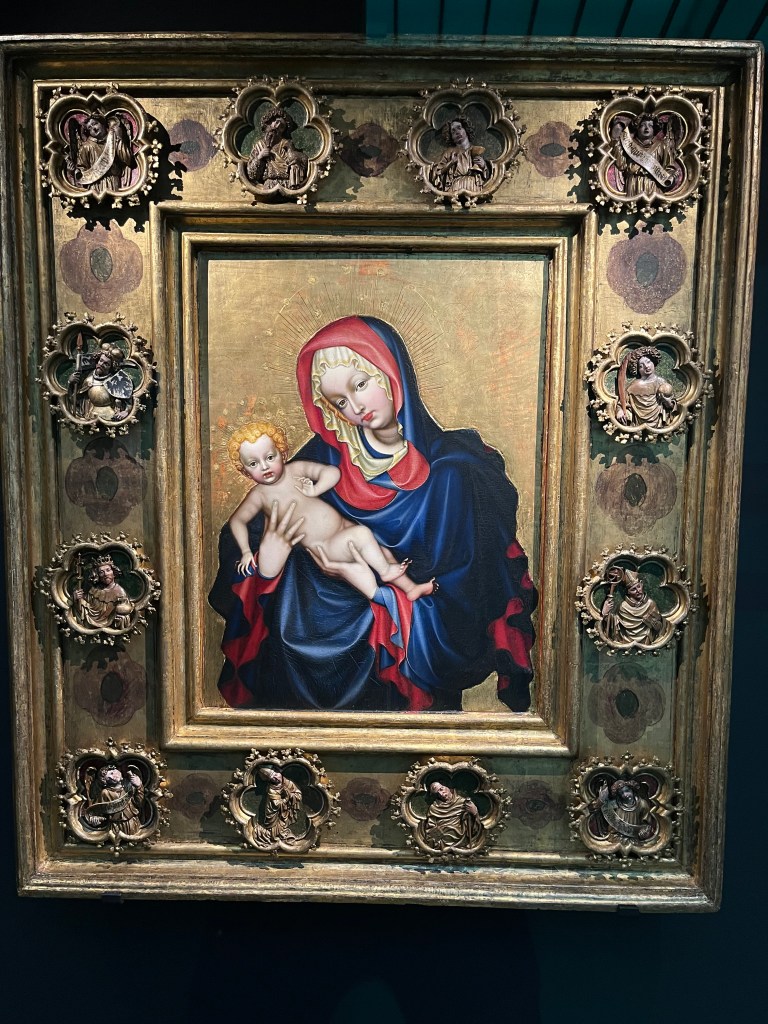
Madonna and Child 
Antique Meissen porcelain destroyed in the 1945 bombing and restored by Japanese experts After checking out from the excellent Gewandhaus, I grabbed the tram to the Dresden Hbf and waited for the train to Prague, which arrived on time. With my injured right bicep, I have to be super careful taking my luggage down from the overhead rack or else! Fortunately, I’ll have flight attendants to help me on my return to the US.
For the duration of my trip so far, I’ve been in flat terrain, so it was nice to see some hills and crags once we crossed the Czech border.


The trip was about two hours and I was able to grab an Uber to my Airbnb in Mala Strana, coincidentally the same neighborhood on the Vltava near the famous Charles Bridge where I stayed in fall of 2001. My driver spoke perfect English and offered that the Czechs are growing tired of the 400,000 Ukrainian refugees, many of draft age, who are receiving benefits from the Czech government. He said there are a million in Germany and 900,000 in Poland. What irks the Czechs is that so many are draft dodgers. Apparently, the military age men have to return to Ukraine if they want to renew their passports, where they’ll most likely be sent to the front. One learns a lot from drivers.
My Airbnb is perfectly situated in a remodeled old building in Malá Strana, a few meters from the Charles Bridge. After unpacking and icing my right bicep, I walked up the steep cobblestones hill to revisit the Hradčany (Castle) district, which was mercifully free of tourists later in the day. I knew that Staré Město and Novo Město would be thronged with tourists.
Ascending the hill, I noticed a number of changes over the ensuing 23 years. First off—the weed stores. I hadn’t realized that pot was now legal in Prague. Also, the tourists. Of course, I last visited shortly after 9/11 so the city was fairly empty. I’ll revisit the flat Old and New Towns in the morning before the narrow streets become impassable. That said, Prague is still the unrivaled jewel that I remembered.
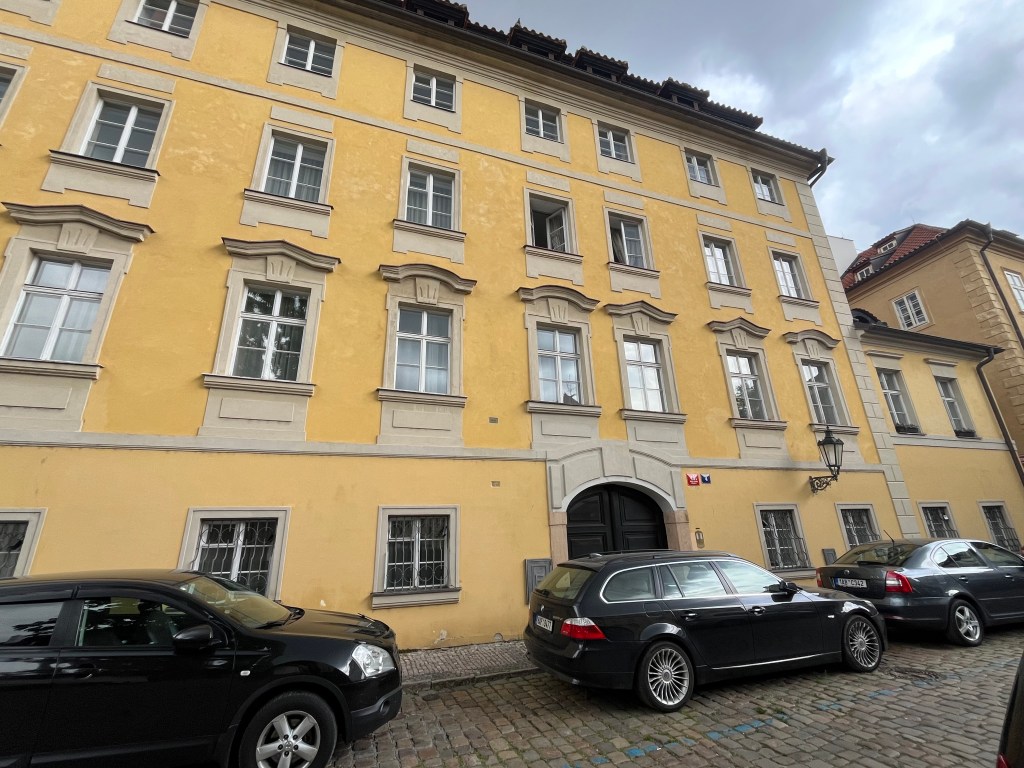
My building 
Old mill around the corner 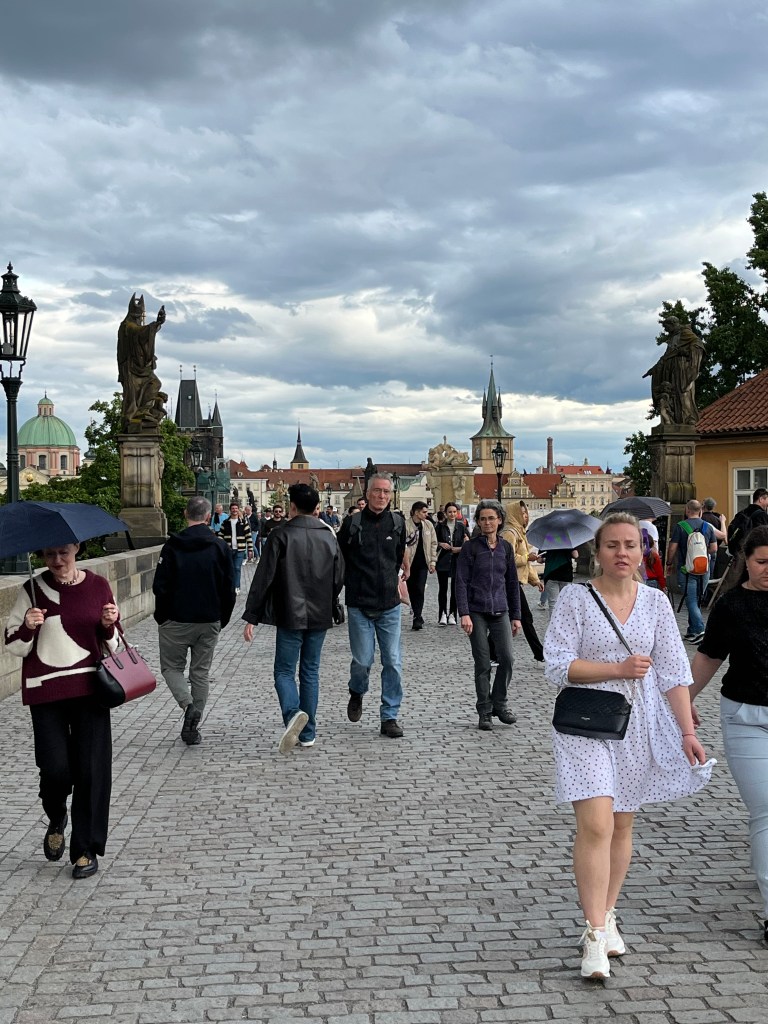
Charles Bridge looking east towards Staré Mêsto As I walked across the plaza near Prague Castle and its Gothic masterpiece, St Vitus Cathedral, the crowds thinned significantly. The castle was rebuilt by Emperor Charles IV, who was a prolific Hapsburg builder, in the 1540s and is the residence of the Czech president.
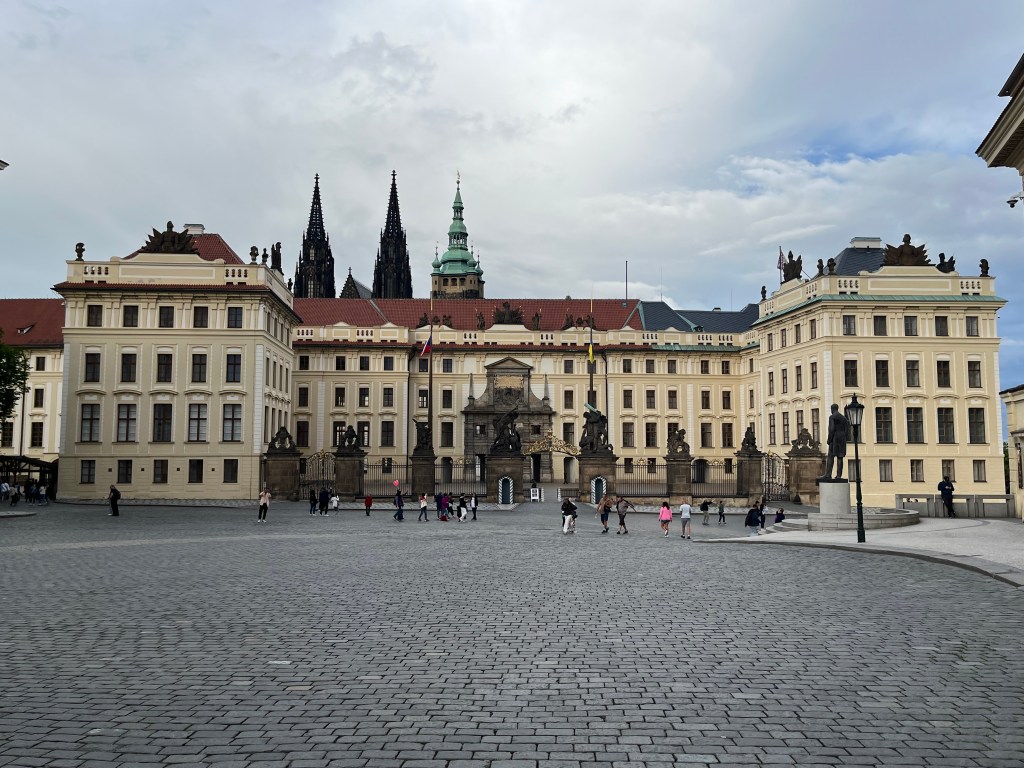
Approaching the castle 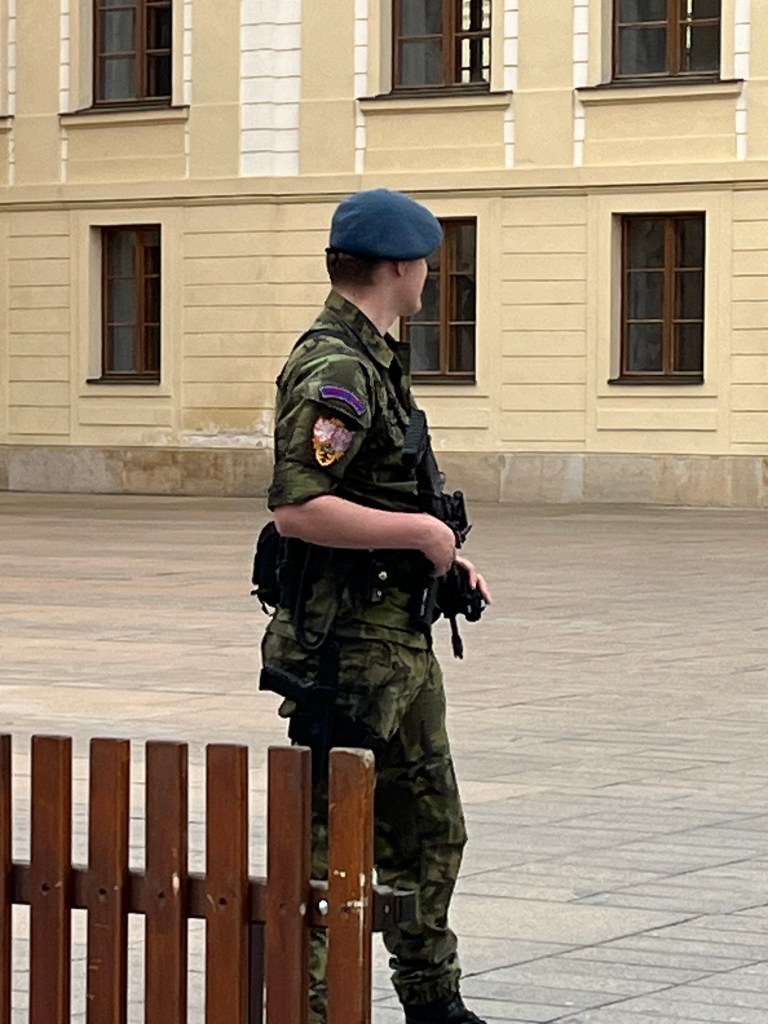
Armed guards 
1614 Matthias Gate 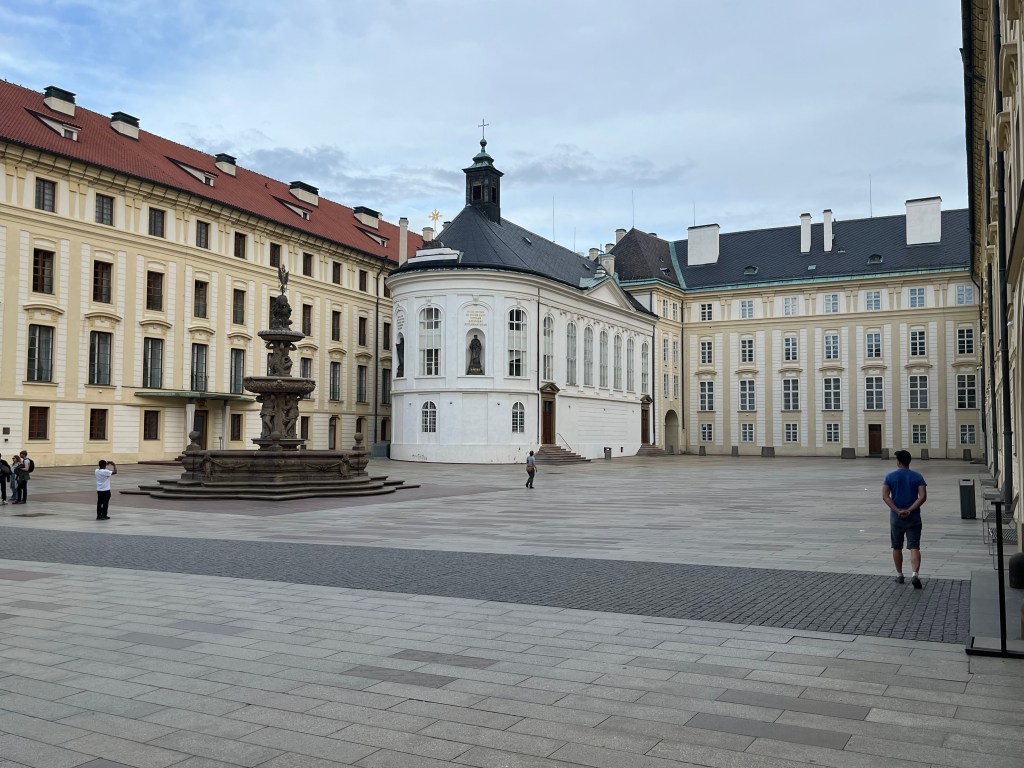
Inner courtyard 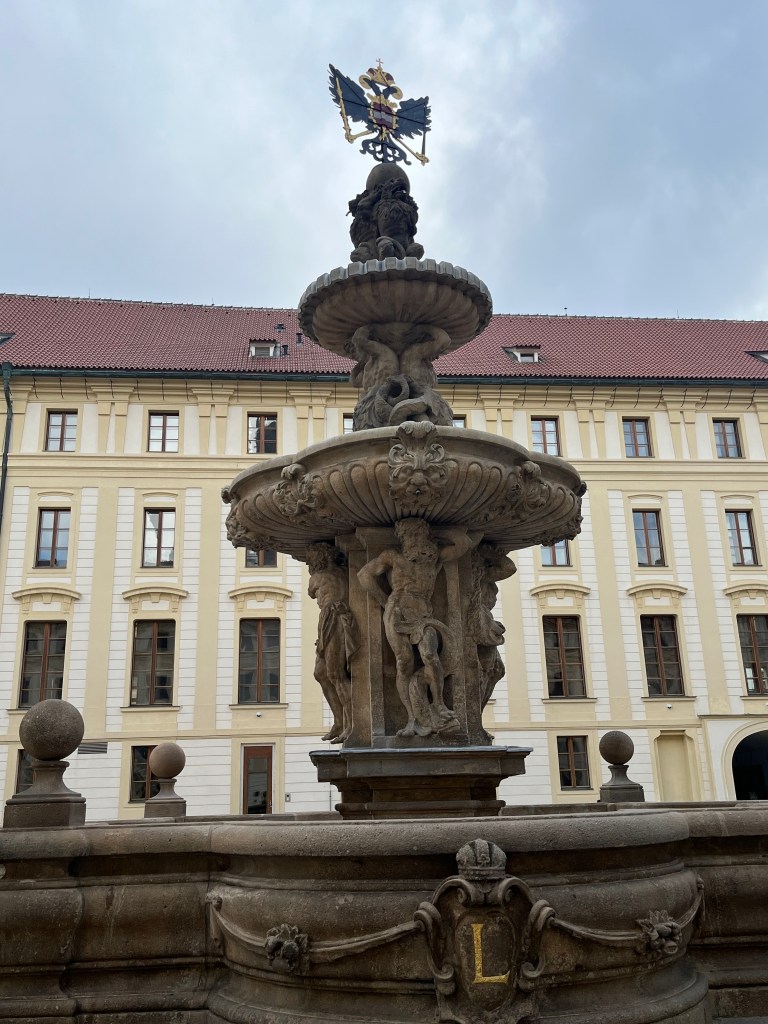
1686 Leopold Fountain topped by the Hapsburg imperial eagle 
Chapel of the Holy Cross 
Inner courtyard 
Twin west spires of St Vitus begun 1344 
The Renaissance Great South Tower 
Flying buttresses 
View from the Hrad 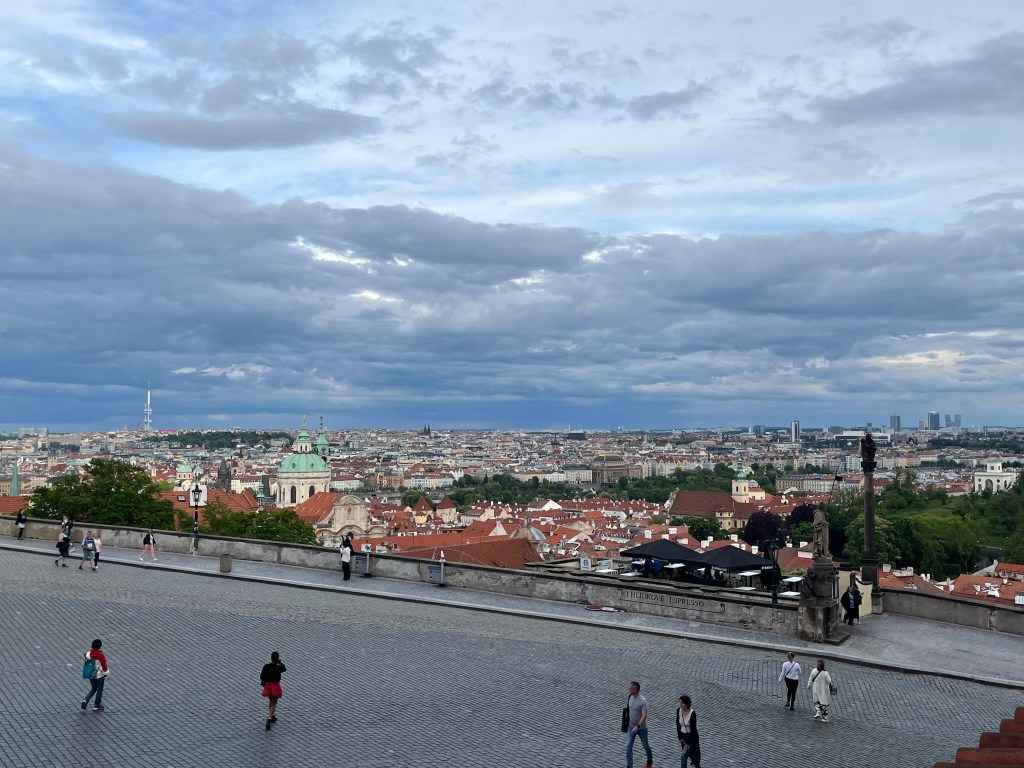
Panorama The Czechs are famously anticlerical, especially after the Reformation. Much of this stemmed from centuries under Austrian rule, especially Maria Theresa in the 18th c., who was part of the passionately Catholic Hapsburg dynasty. Despite that, the post-1918 Czechoslovakia, and even the Communists, left the dozens of grand churches and palaces unscathed as part of the national patrimony. After the 1989 Velvet Revolution that overthrew the totalitarian state, the new Czech Republic, after its amicable divorce from Slovakia in 1994, lavished funds on the restoration and maintenance of its medieval and baroque core, which has paid enormous dividends as Prague has become one of Europe’s foremost tourist destinations.
Beyond the castle lies a sloping plaza surrounded by Hapsburg area palaces which are now museums and government ministries. A few hundred meters to the west lies the hulking Ministry of Foreign Affairs, Toskánsý Palác, finished in 1691, where Foreign Minister Jan Masaryk fell from a third-story window to his death, a favored Russian tactic even to this day. The communist coup d’etat of 1948 dispelled the promise of a democratic post-war Czechoslovakia.

Royal Gardens entry 
Signage 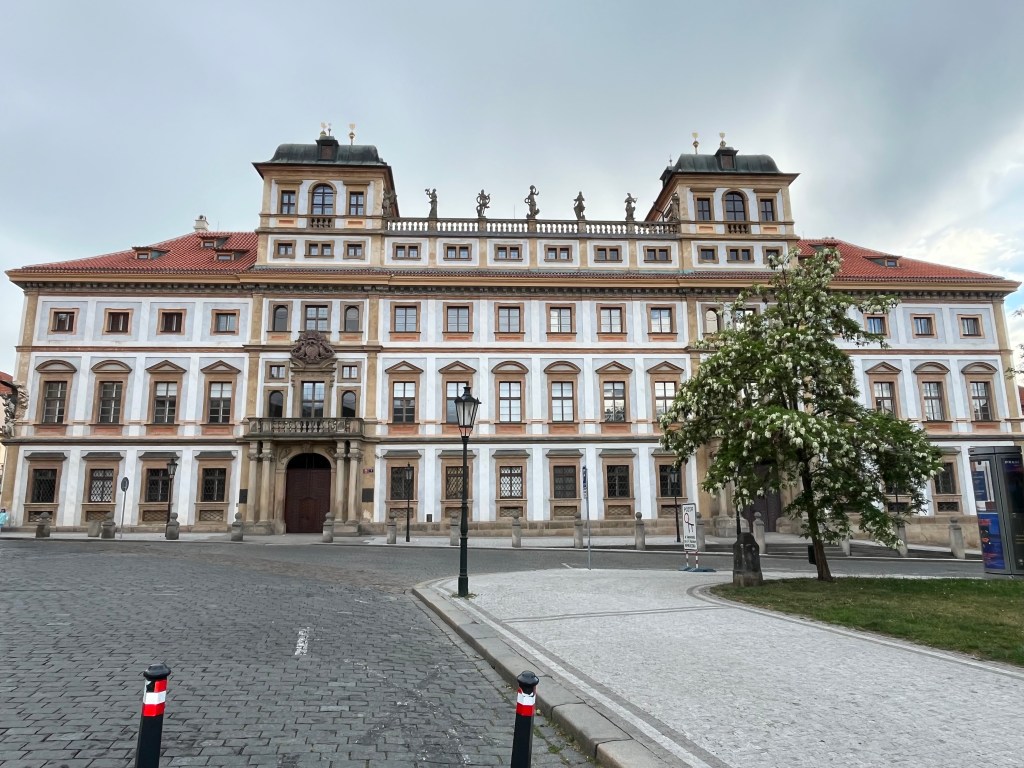
Martinic Palace 
Splendid little gate detail 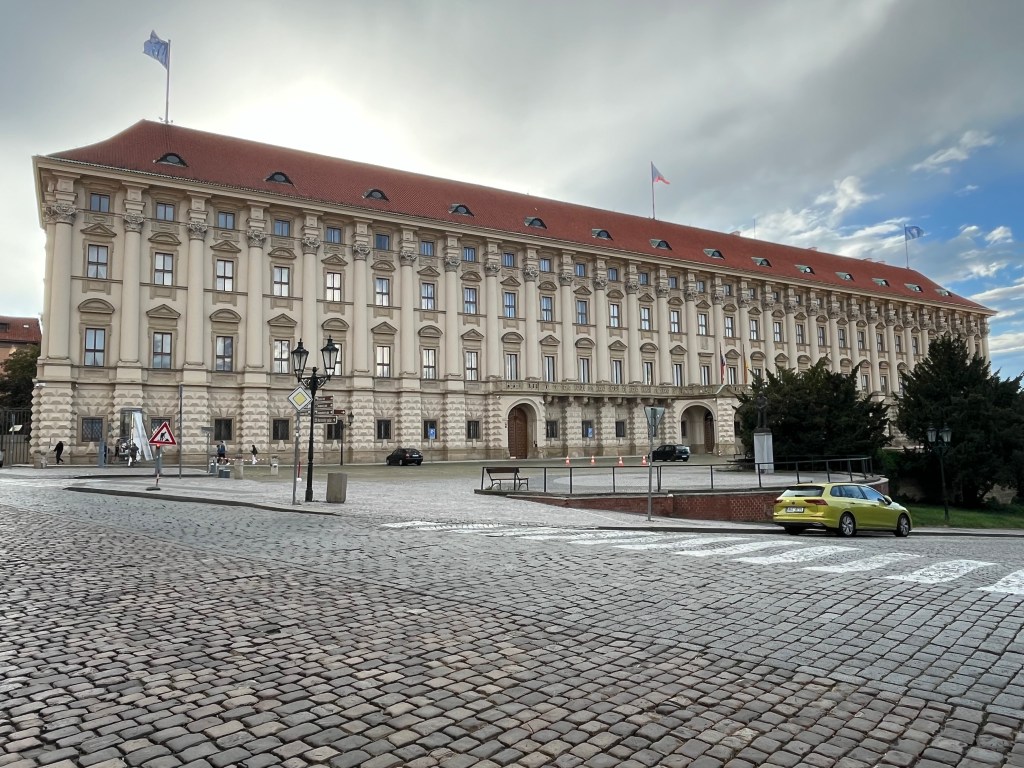
Ministry of Foreign Affairs After so many years, I still remembered this particular area, especially the baroque 17th c. Loreta and my favorite ancient neighborhood down the hill, Nový Svět, where the astronomer Brahe lived. It’s one of the most atmospheric places in Europe and is largely off the tourist track. I didn’t encounter any tourists until I was leaving. There, an Italian couple from Milan were concerned about a drumming noise coming from a parked VW. We had a lovely conversation about my three trips to Italy and conditions around Europe today.




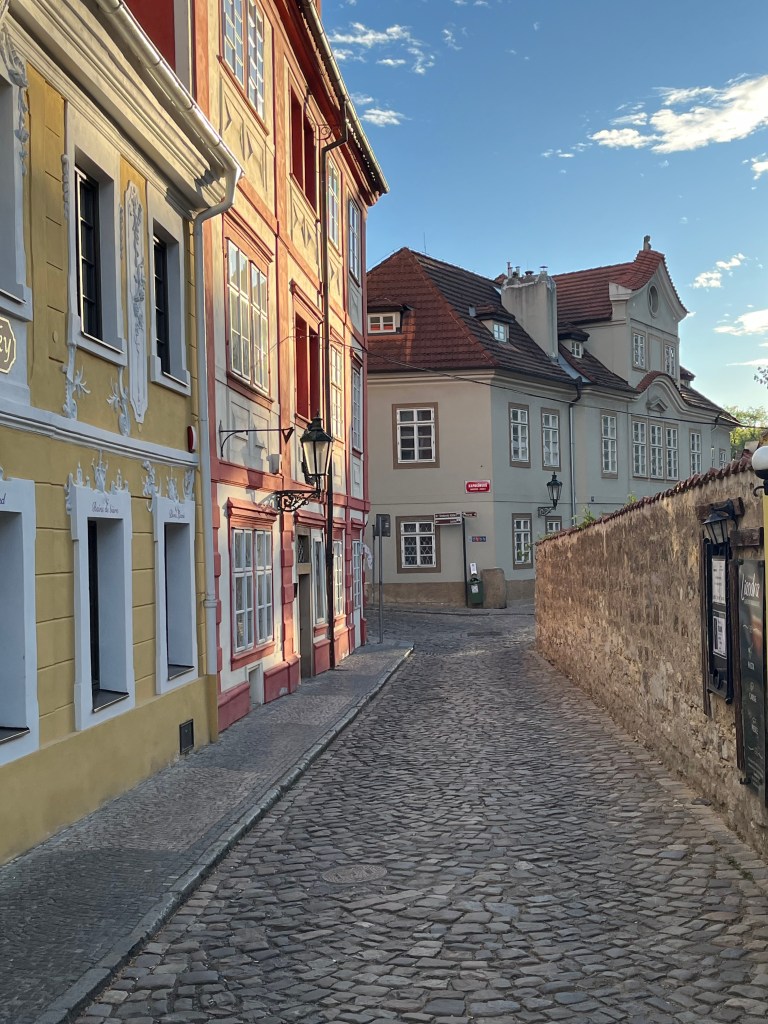
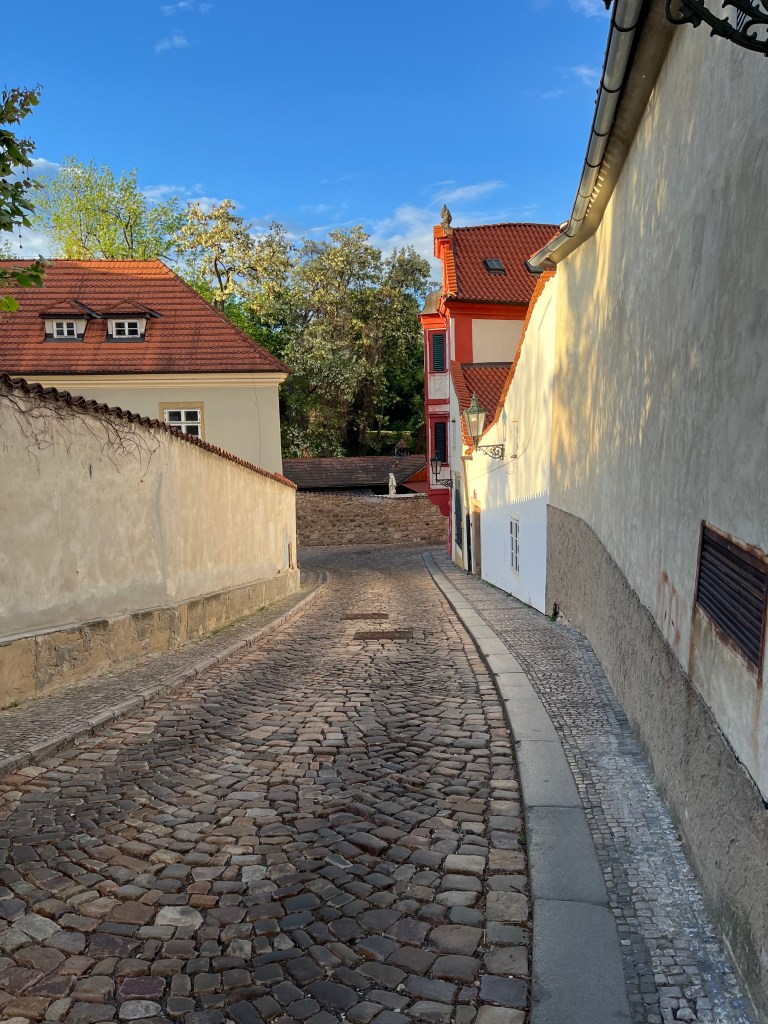
From Nový Svêt, I made my way back up the hill towards the Hrad to revisit Loreta and the famous Strahov Monastery, founded by an austere order in 1140 and rebuilt in the Gothic and Baroque styles later. It’s still a functioning monastery. When I walked inside, a priest was lighting the Pascal candle.

The Loreta 
Strahov Monastery 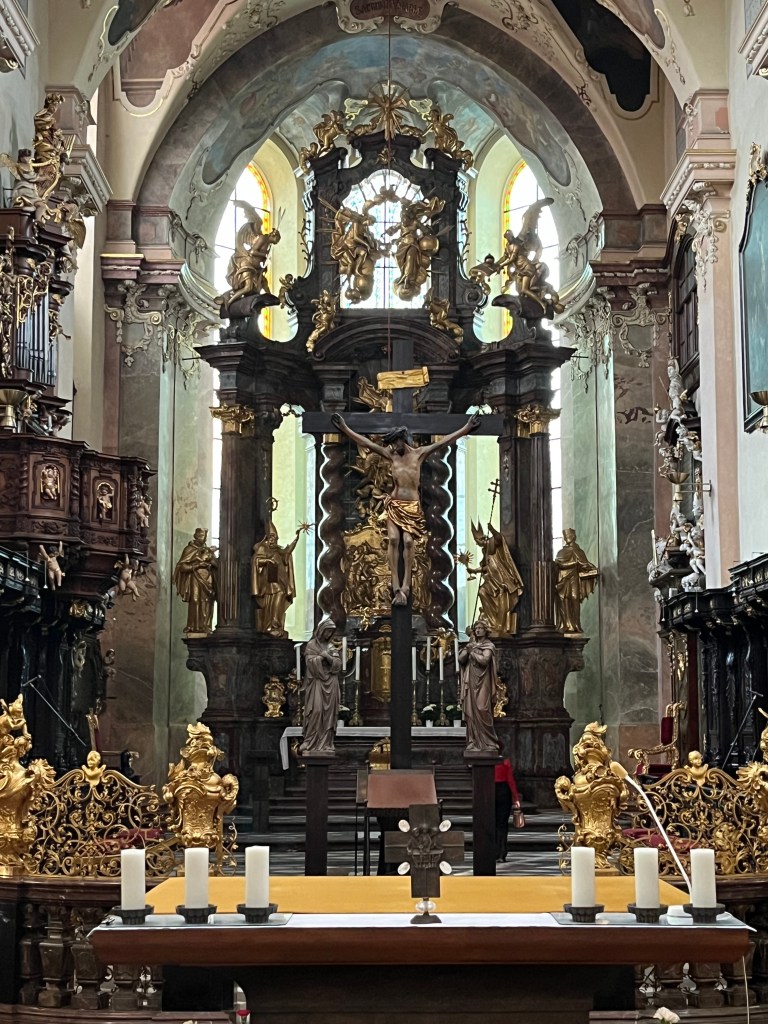
Interior high altar 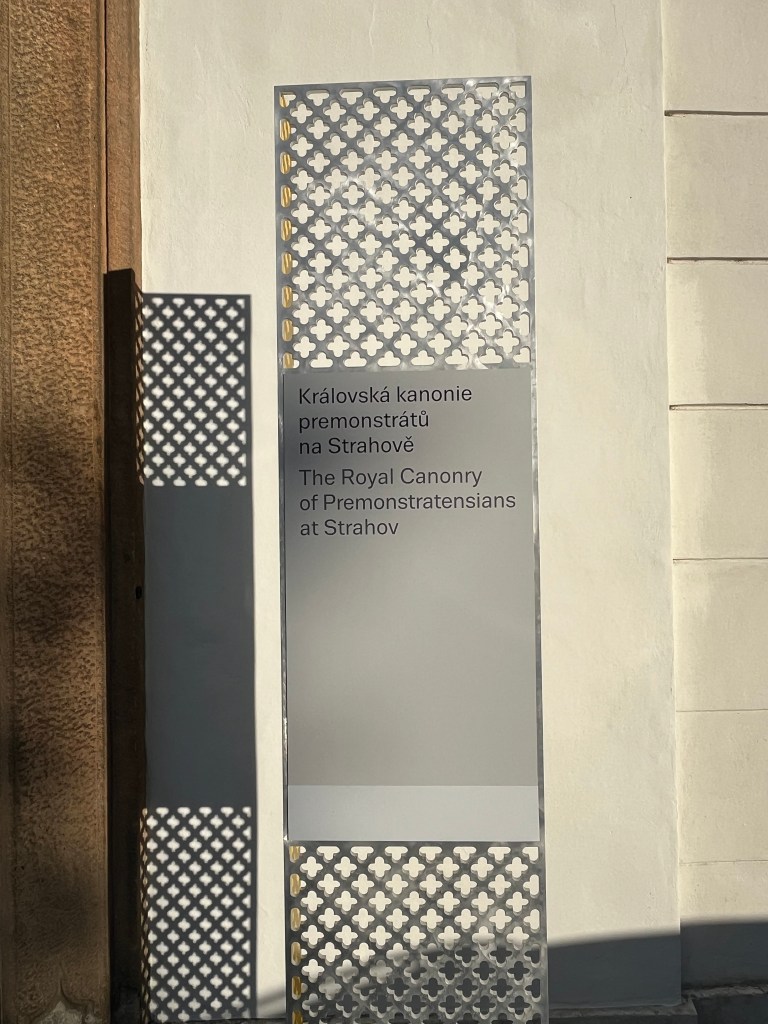
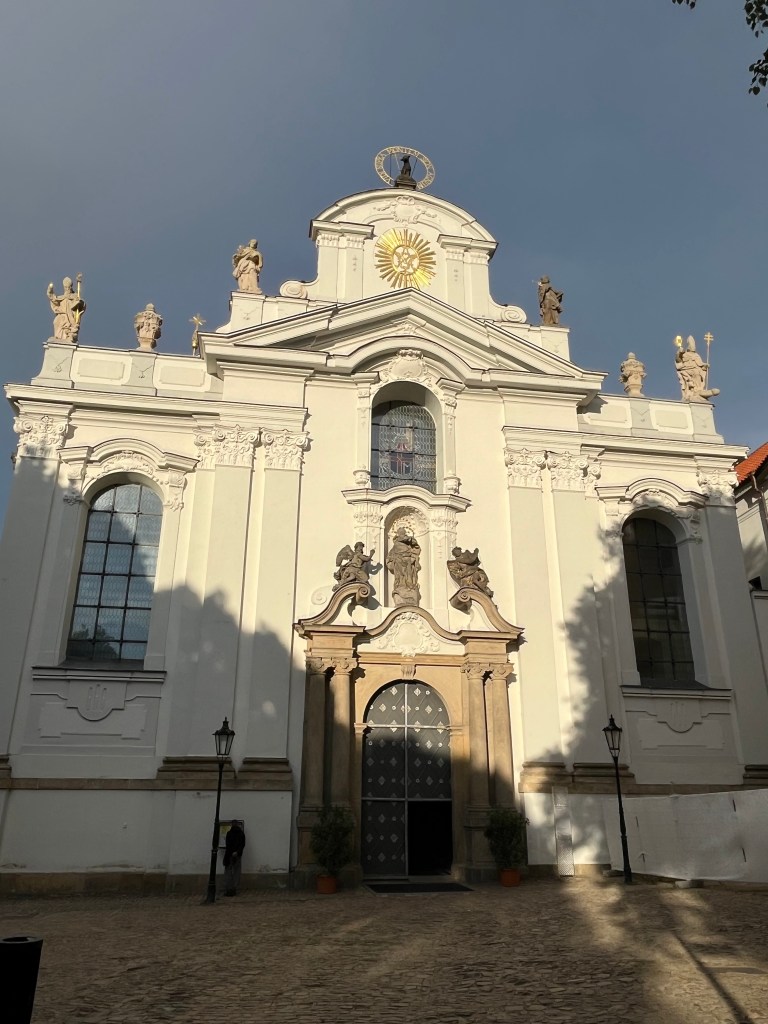
Monastery facade 
Grand organ As it was getting late and I hadn’t eaten since late morning, I popped into The Golden Bull, a traditional Czech restaurant, and enjoyed roast pork with dumplings and sauerkraut, preceded by an excellent Caprese salad. The server suggested I visit Brno, the capital of neighboring Moravia, where the noted wine region is. Since I’ve seen all of the major sites before, I’m considering going there on Tuesday, when it’s expected to rain.

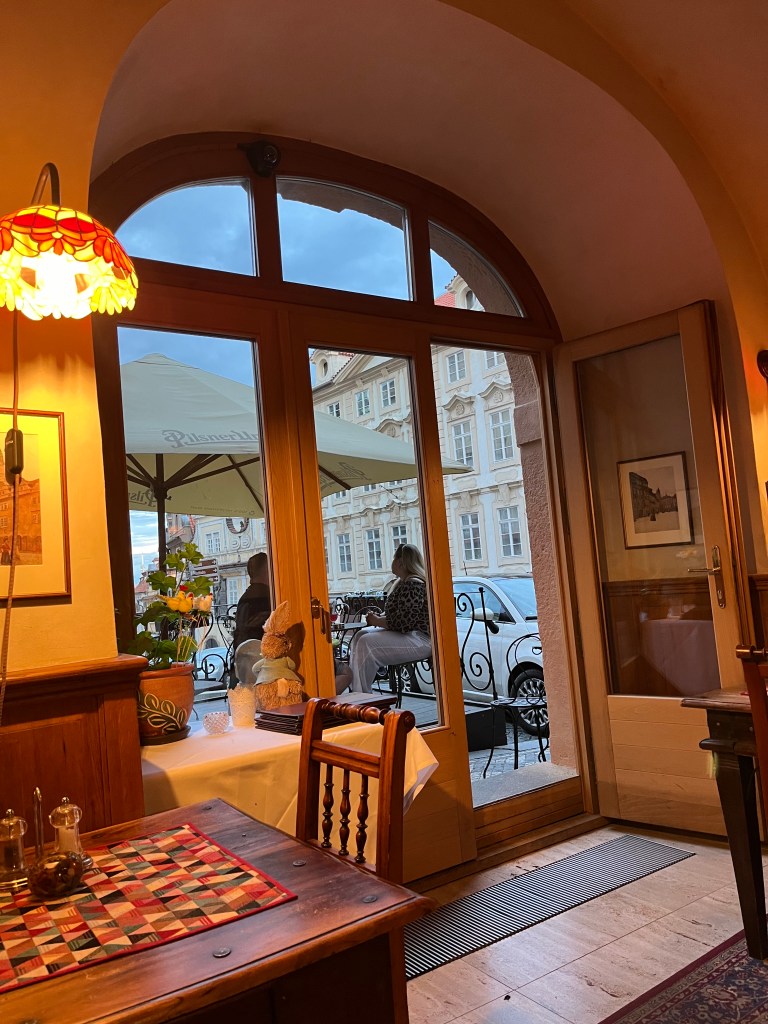

Returning to Malá Strana, the tourist throngs were out in full force for a night of drinking. I snapped a few pics of St Vitus Cathedral up on the hill and returned to my Airbnb after clocking ten miles.

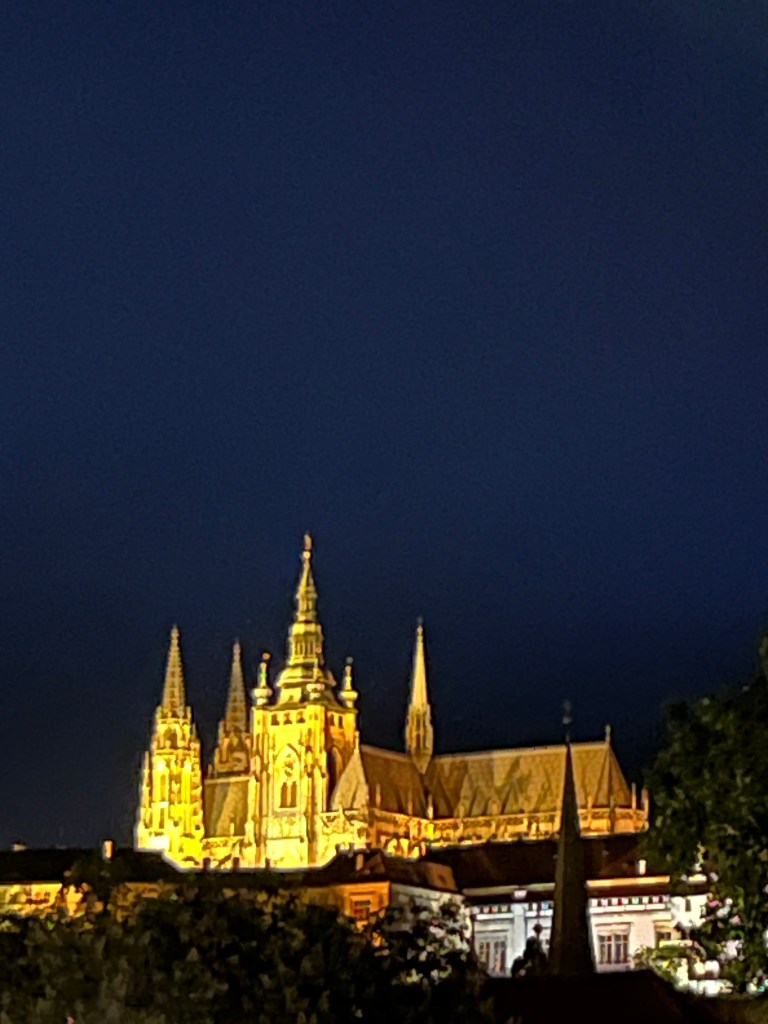

-
Dresden Day Two: May 4, 2024
I woke up early and after some blah Nespresso in my room, I went for a nice walk through the Altstadt before turning east along the Elbe. Dresden has excellent biking and walking trails on both sides of the Elbe. Considering my little cycling pratfall on Thursday morning, I’ve decided to keep on foot for a few days before jumping on a bike.
Although it’s cloudy now, it was sunny and cool this morning. I walked east to a distant bridge and then crossed over to Neustadt and did a little exploring before heading south back to my hotel. I took some nice pics of the Baroque churches and palaces in the Altstadt from the other side.
I stopped at a bakery in Neustadt and asked for a cappuccino. The grumpy waitress told me take a seat, where I was ignored. She must have been a runner-up in the DDR Miss Congeniality contest when she was younger.
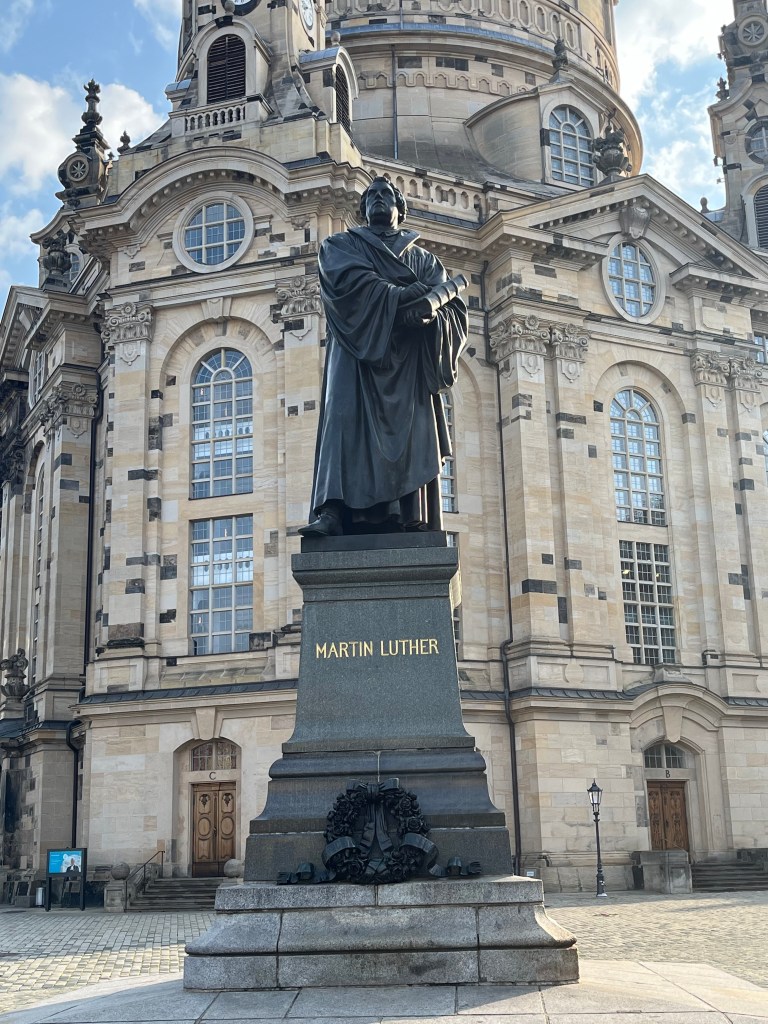
Luther statue in front of Die Frauenkirche 
Die Frauenkiche 1743 
Neumarkt plaza 
Riverside gardens 
Baroque cluster from Neustadt 
Royal Ministry of the Interior 
Riverside palace in Neustadt 
The Golden Horseman Augustus the Strong 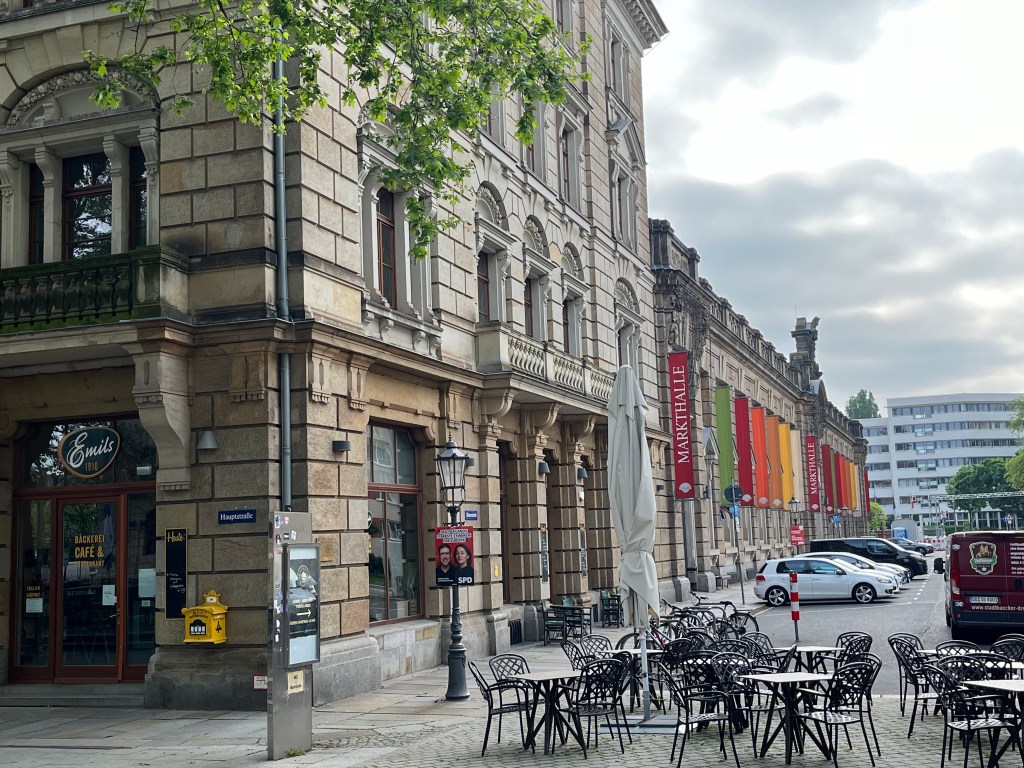
Neustadt Market 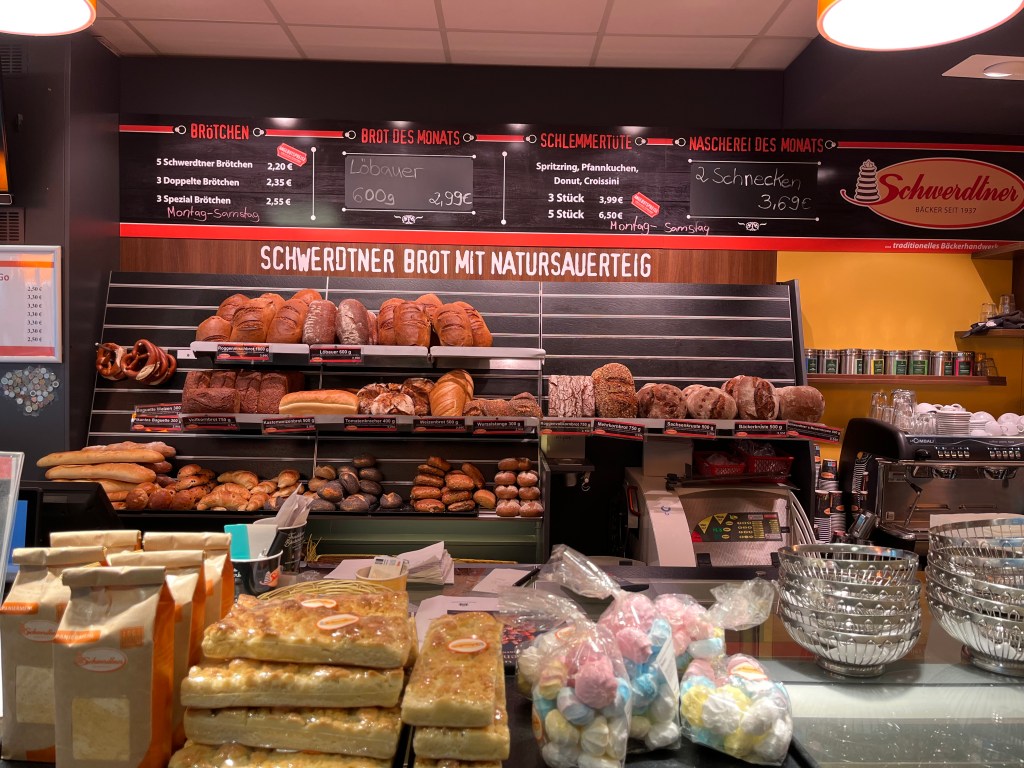
The unfriendly bakery I joined the walking tour at 11. As usual, the guide was a highly-informative university student with the unlikely name of James. He gave a comprehensive overview of the city’s origins, beginning with the Sorbs, a Slavic tribe which was eventually overpowered by Saxons moving southeast. The first capital of Saxony was Meissen, famous for its porcelain, but the ruling Wettin family, from whom the House of Windsor is partly descended, moved the capital to Dresden and ruled until 1918. Their most famous king was Augustus II the Strong, who also wore the Polish crown in the early 18th century. Eventually the Prussians came to dominate Saxony, which became part of the new German Empire in 1871.
The Wettins build much of the Altstadt, especially the Baroque Frauenkirche and many others, including the Residenz, or royal palace, dating from the 15th c.

Porcelain mural “Procession of the Princes”, made of 23,000 tiles 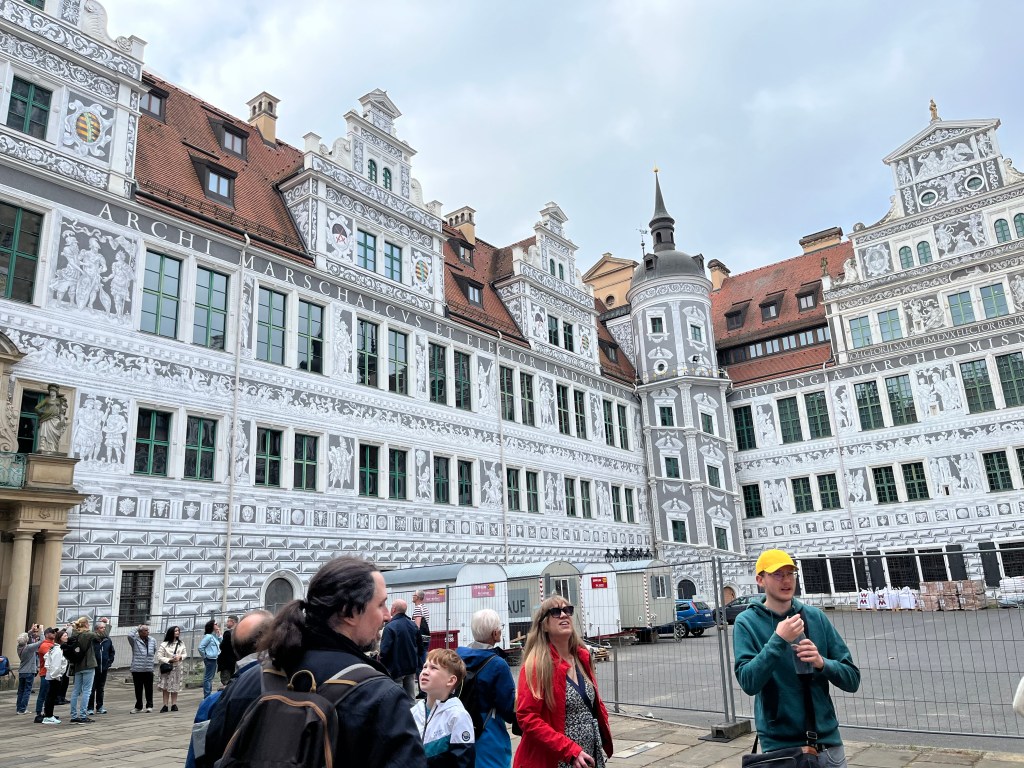
Courtyard of the Residenz 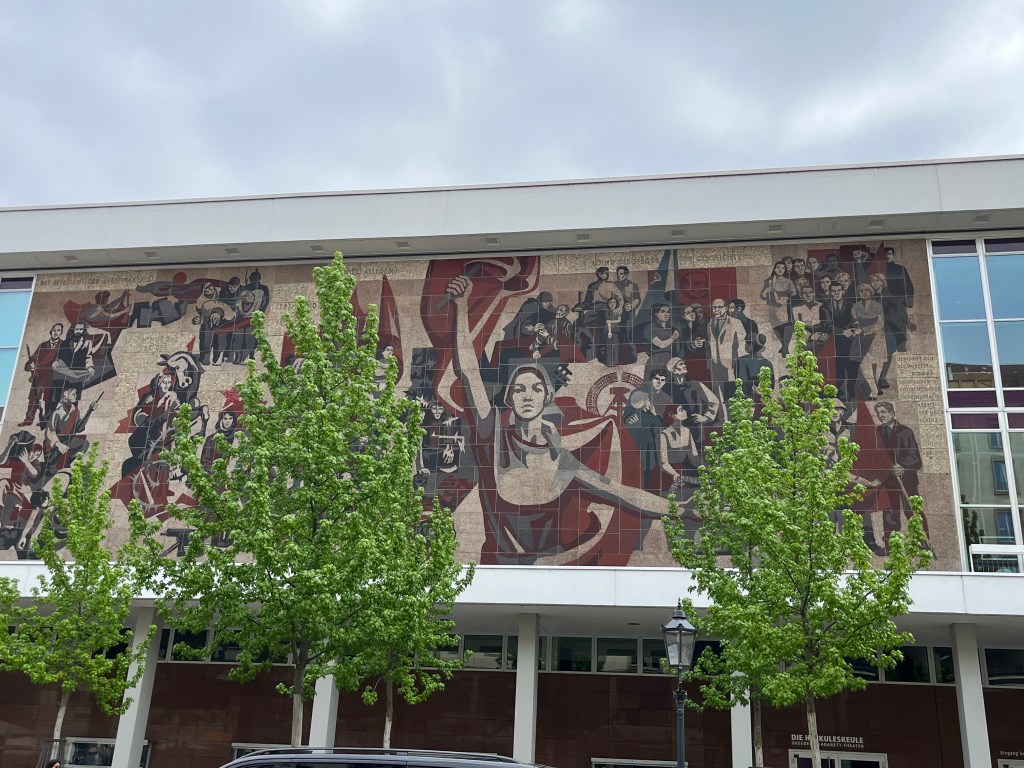
Communist mural on the DDR-era Kulturpalast 
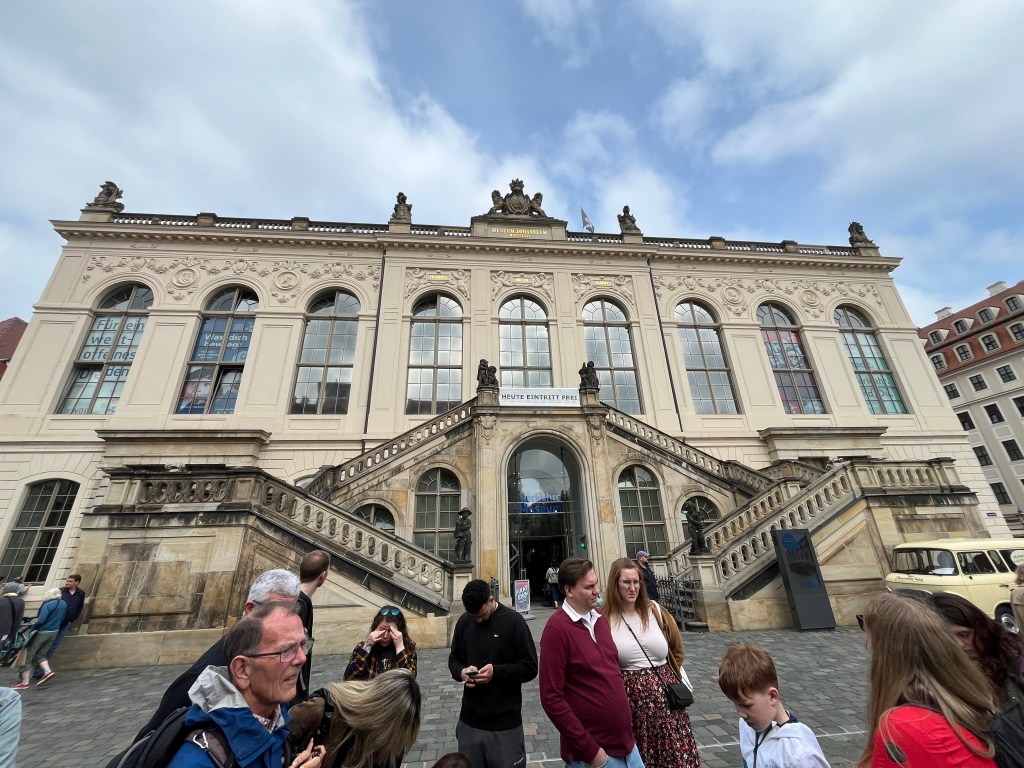
A wing of the Residenz 
Catholic Court Church 1754 In contrast to the Baroque masterpieces, many of which lay in ruins until after 1990, the DDR built the modernist Kulturpalast, which remains controversial. Many in the city wanted it torn down, but it remains as part of the city’s legacy.
During the stop at the Kulturpalast, James presented an overview of the Bombing of Dresden in early February 1945. I gave the number of 150,000 dead in my previous post, a number I recalled from reading Kurt Vonnegut’s Slaughterhouse Five, based on his experience of living through the bombing as an American POW. The official number, drawn from burial registrations, is 25,000, still a significant death toll. Especially since 2000, the government and private sources have meticulously rebuilt the historic center, which is ongoing. A first time visitor would never know that the Altstadt had been obliterated and rebuilt.

Interior dome of the Frauenkirche 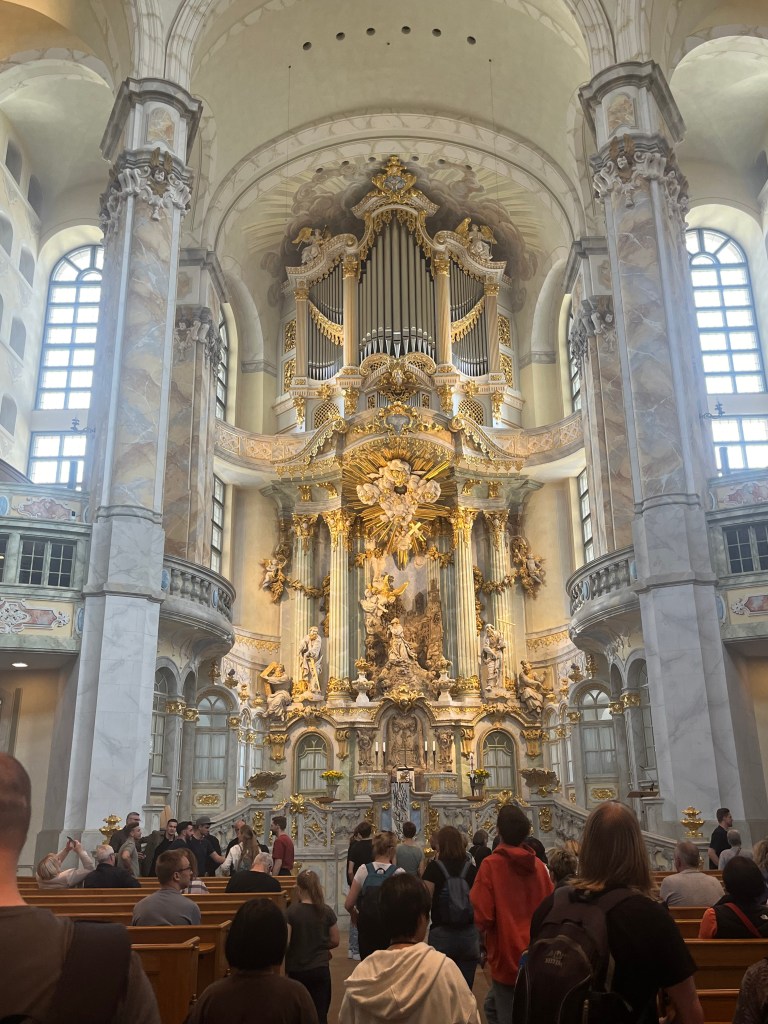
High Altar of the Frauenkirche After the 150-minute tour I rode the tram with James back over to Neustadt and then left for the restaurant area to grab a late lunch before walking back to the hotel. The hotel had a sauna, so I took advantage of that before getting ready to head over to the Semper Opera for a performance of The Marriage of Figaro. I was surprised how dressed up the full crowd was. At least I was wearing a collared shirt! My seat was at the end of the row, so I didn’t have to climb over people. I often nod off during performances, but this time I managed to stay alert during the three-hour performance. At least there was a nice intermission. The opera was well staged and enjoyable.

Semper Opera interior views 



Leaving via the side entrance 
Frauenkirche at night The opera ended around 10:20 and I made a quick exit ahead of the crowd. The weather on the walk back was cool and I stopped by the hotel bar for a quick snack since I hadn’t eaten since early afternoon. I logged in 11.5 miles today. Tomorrow I leave for Prague in the early afternoon.
-
Arrival in Dresden: May 3, 2024
The tram from Dresden Hbf was just a few stops from my hotel, which was a 2-minute walk from the tram stop. The Gewandhaus Hotel is an elegant building dating from the early 18th c. The room is large and well-furnished and even has an oversized soaking tub, which is a first. After checking email and looking at a few maps, I took an orientation walk around the Altstadt before crossing the Elbe to the Neustadt. I also planned a visit tomorrow late afternoon to the Vesper choral service at the Kreutzkirche around the corner and was also able to grab one of few tickets to see Mozart’s The Marriage of Figaro tomorrow evening at the renowned Semper Opera.
At the Central Station, I chatted with a young Canadian woman at the information center. She suggested that I visit some nearby vineyards where the excellent Grauburgunders are made and she showed me how to get there by public transit and circled the areas.
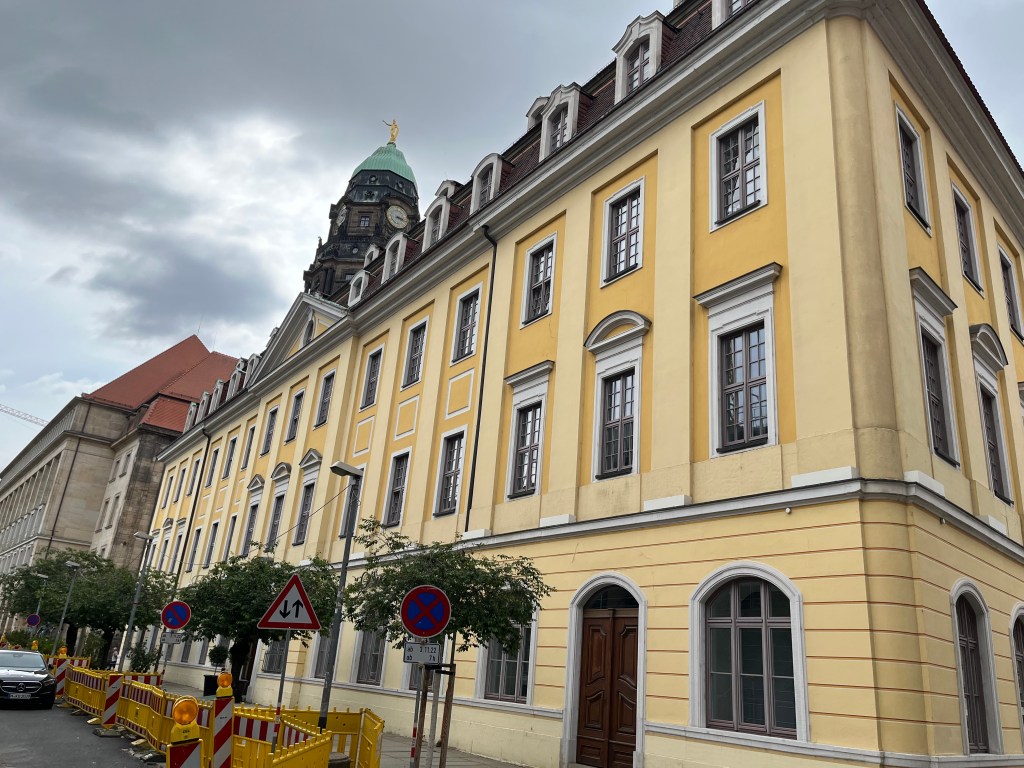
My hotel 
A thoughtful welcome treat 
The charming reception and bar Since I booked a walking tour tomorrow, I’ll hold off on descriptions until then; however, my impression of the city is hugely positive, especially when one considers that Dresden was utterly destroyed by thousands of US and British bombers in early February of 1945. The bombing was designed to create a firestorm which killed up to 150,000, mostly civilians. The Elbe River was boiling and the maelstrom even permeated the bomb shelters, literally melting the occupants. You can read about the gruesome details online. The fact that most of the city was meticulously rebuilt after German reunification is itself a miracle. The former DDR had neither the money nor the desire to rebuild this magnificent Baroque jewel. The last photo is of the Semper Opera, which I mentioned. The others are a prelude to tomorrow’s deeper dive.
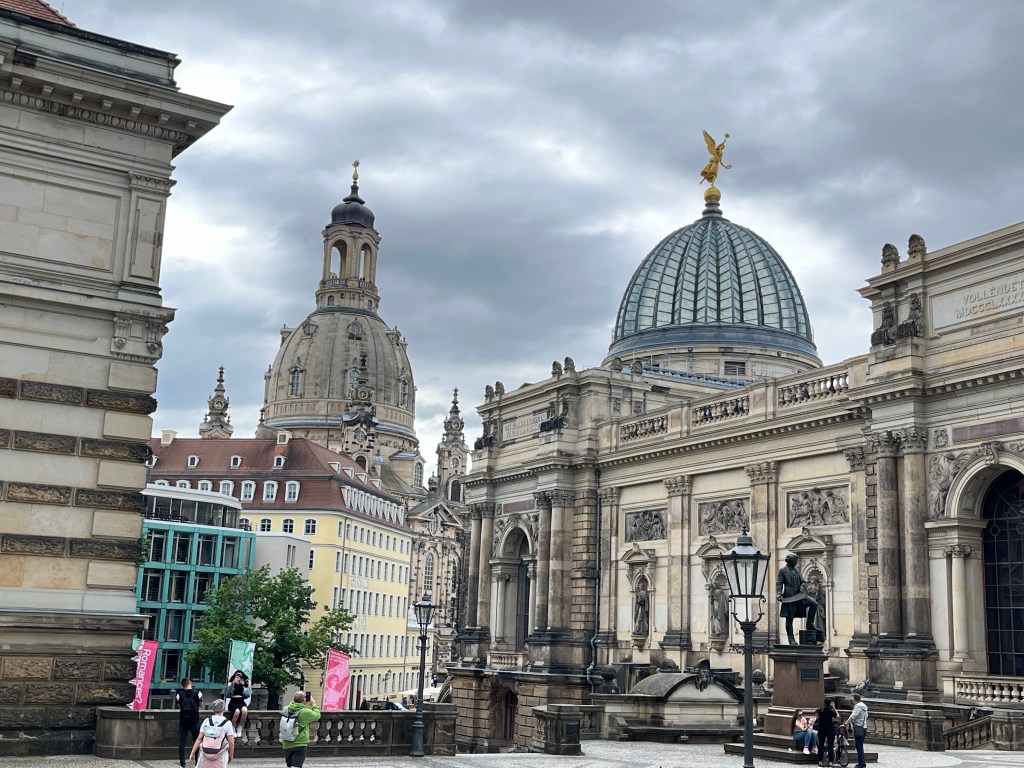
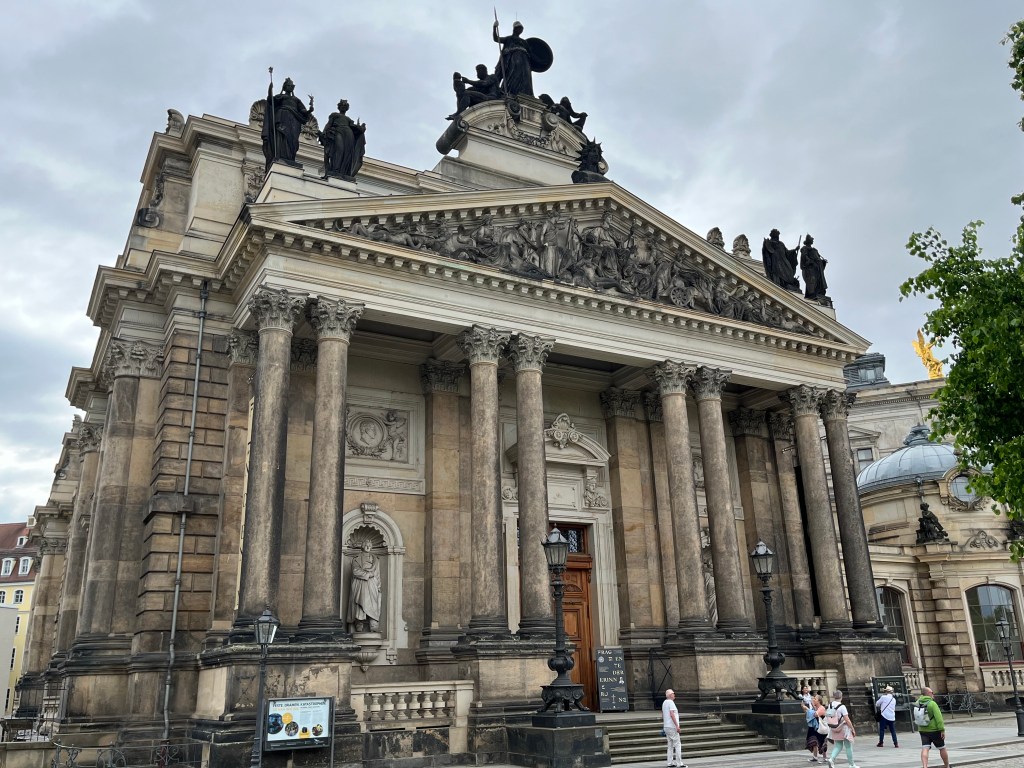

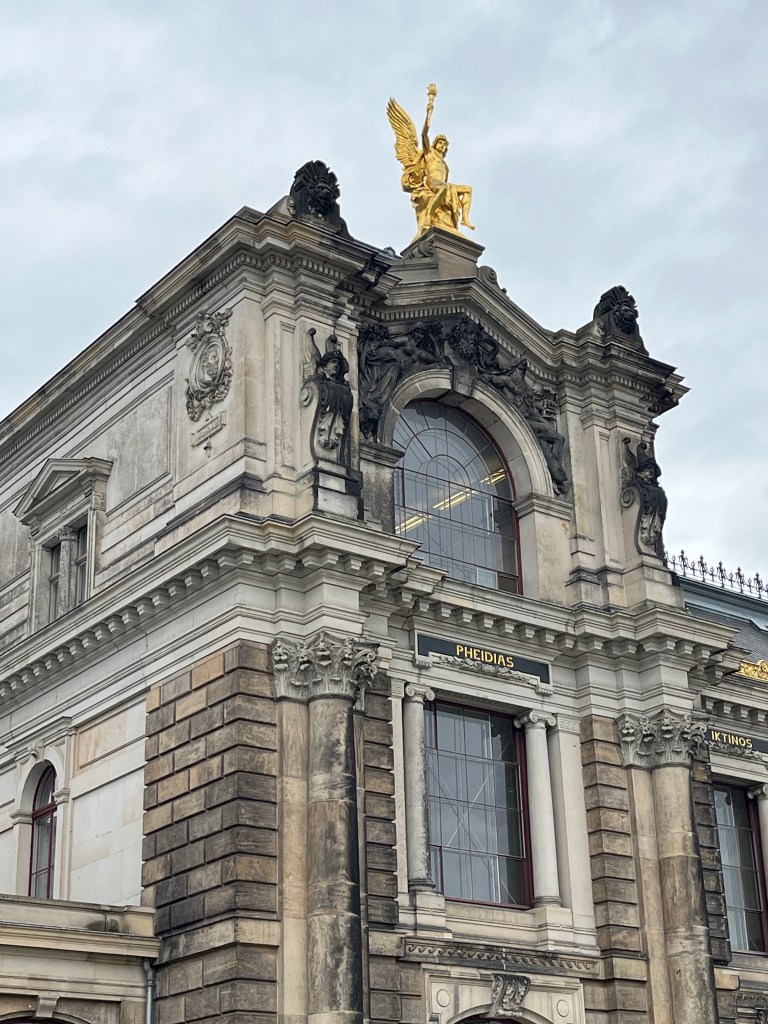





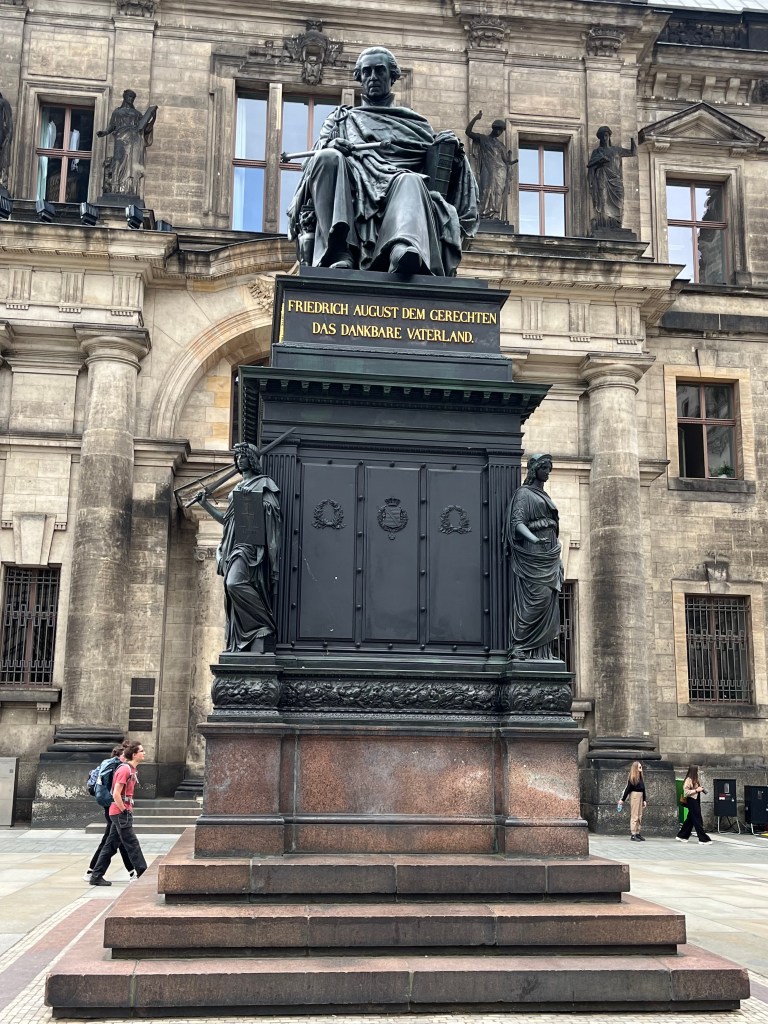
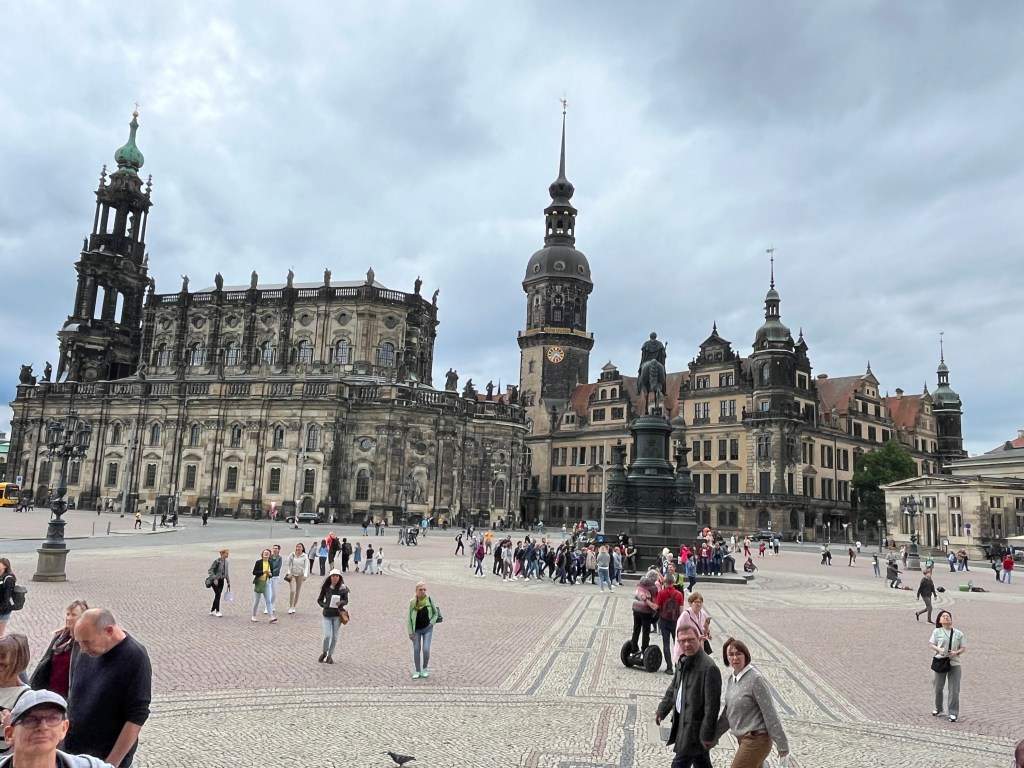
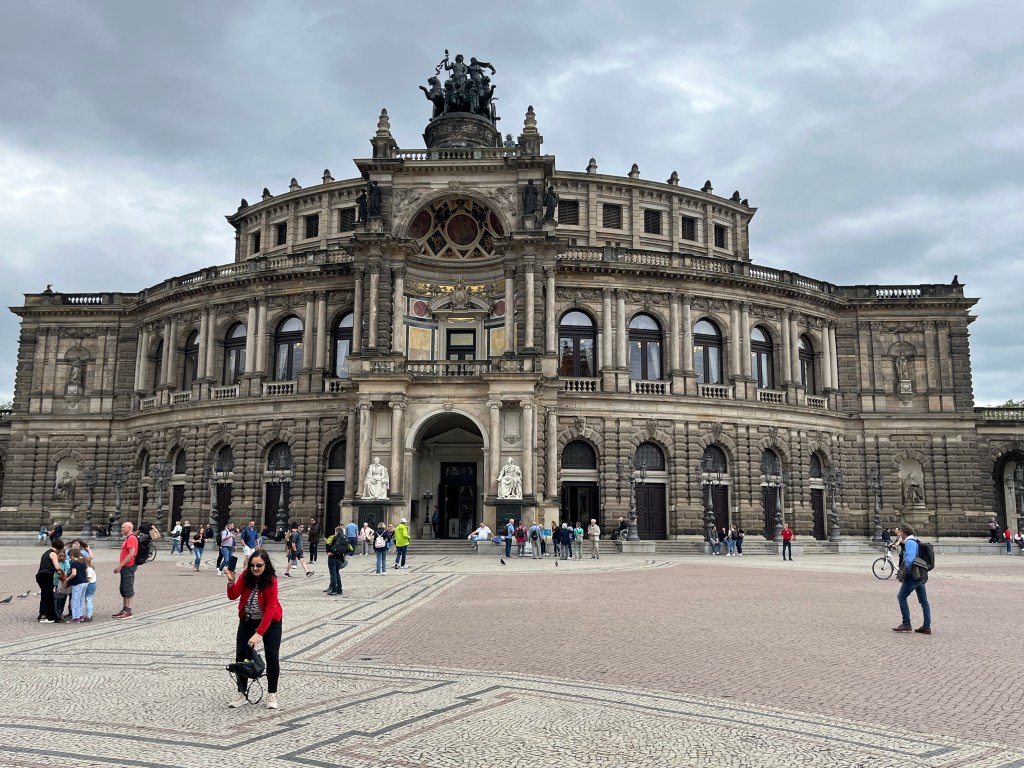
Today the weather turned cooler and it began raining as I rode the tram to an outlying suburb where some of the vineyards are located. Since I hadn’t done any advance planning, I couldn’t figure out how to get to the hilltop vineyards. I’ll try to figure that out later. I returned to the Altstadt and wandered around before returning to the hotel to figure out dinner plans.
-
Subscribe
Subscribed
Already have a WordPress.com account? Log in now.




